Manly's Wildflower Shows: Some History
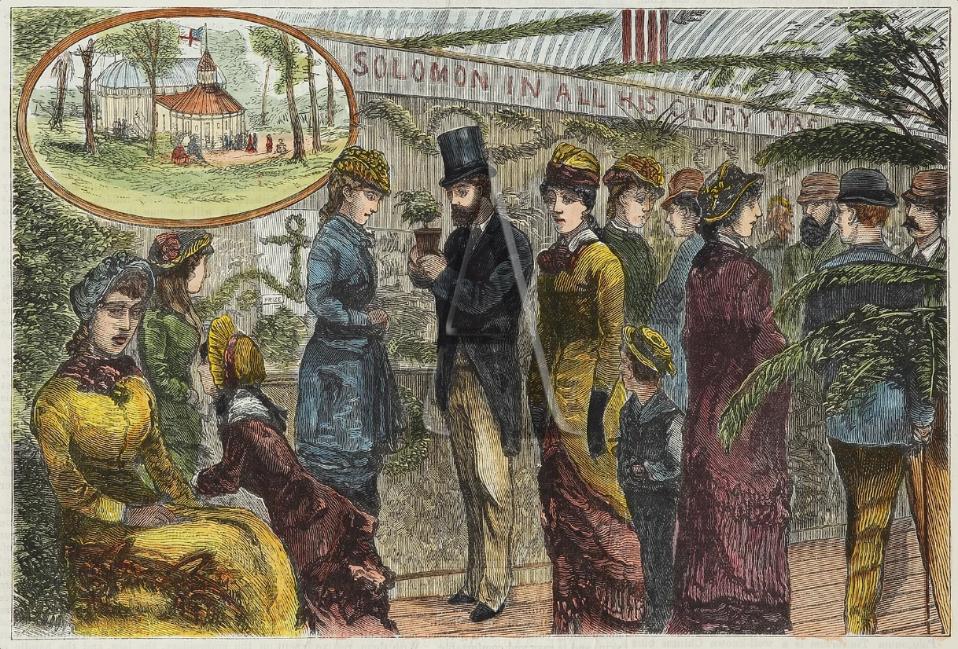
The early residents of the Manly to Barrenjoey Peninsula have always had to come together as a community to raise funds for any community facility needed - whether that is a surf club, a hospital, knitting socks for children or a church - the foundation stone is what lived in the core of the people who resided here and cared about each other and their community.
These fundraising efforts often relied on volunteers to do any work associated with the object for free, and in the case of materials for plays, music nights or cake stalls, required people to rummage through what was at home that could be adapted for purpose, and again for as little cost as possible and aiming to have that for 'free' as well.
The Manly Wild Flower Shows, which commenced in October 1881 and persisted into the late 1890's, made use of the bushflowers that then covered the hills of Manly and surrounds during those years.
The Manly to Barrenjoey peninsula had been renowned for its natural beauty and wealth of wildlife and wildflowers for decades prior to the commencement of these shows.
Added to these celebrations of local beauty was a rise in appreciation and even love for our own landscapes and their features, a celebration emphasised by people such as as Ellis Rowan, whose paintings of wildflowers were exhibited overseas, winning numerous medals and focussing the Australian eye on that which enriched our lives.
The Wild Flower Shows became such a popular event, attracting thousands annually (while generating much needed funds for local churches), they spread to other areas - the Willoughby and Gosford Wildflower Shows soon followed, as did others in other areas. This led to destroying the bush and wildlife habitats in its wake in those other places as well.
It even inspired others to have 'wild flower gathering excursions' to Manly and Pittwater outside of that Spring event. Australia being one of the few places on the planet that has native plants that flower all year round - to feed the native animals, all year round - and with no rules, regulations or laws in place to look after the native plants, the unscrupulous cashed in on the boon and even encouraged the naïve to keep taking with a message that the supply could never be exhausted. However, the manner of the taking, by ripping the plants out by their roots, specifically to keep them fresh for the duration of the Manly Wild Flower Show, led to the local extinction of endemic species.
For example; has anyone ever seen the native white rose that was once profuse in the Manly to Pittwater area - that reported in these earliest Manly Flower Shows? Its cousin the pink native rose may still be encountered at Frenchs Forest, Belrose and parts of Pittwater, but no one has reported finding the white variety since the days of the Manly Wild Flower Shows.
Boronia serrulata, or Native Rose in the pink variety, occurs naturally within a radius of about 50 km of Sydney from Gosford to the Royal National Park, where it is found growing in semi-shade amongst outcrops of Hawkesbury sandstone.
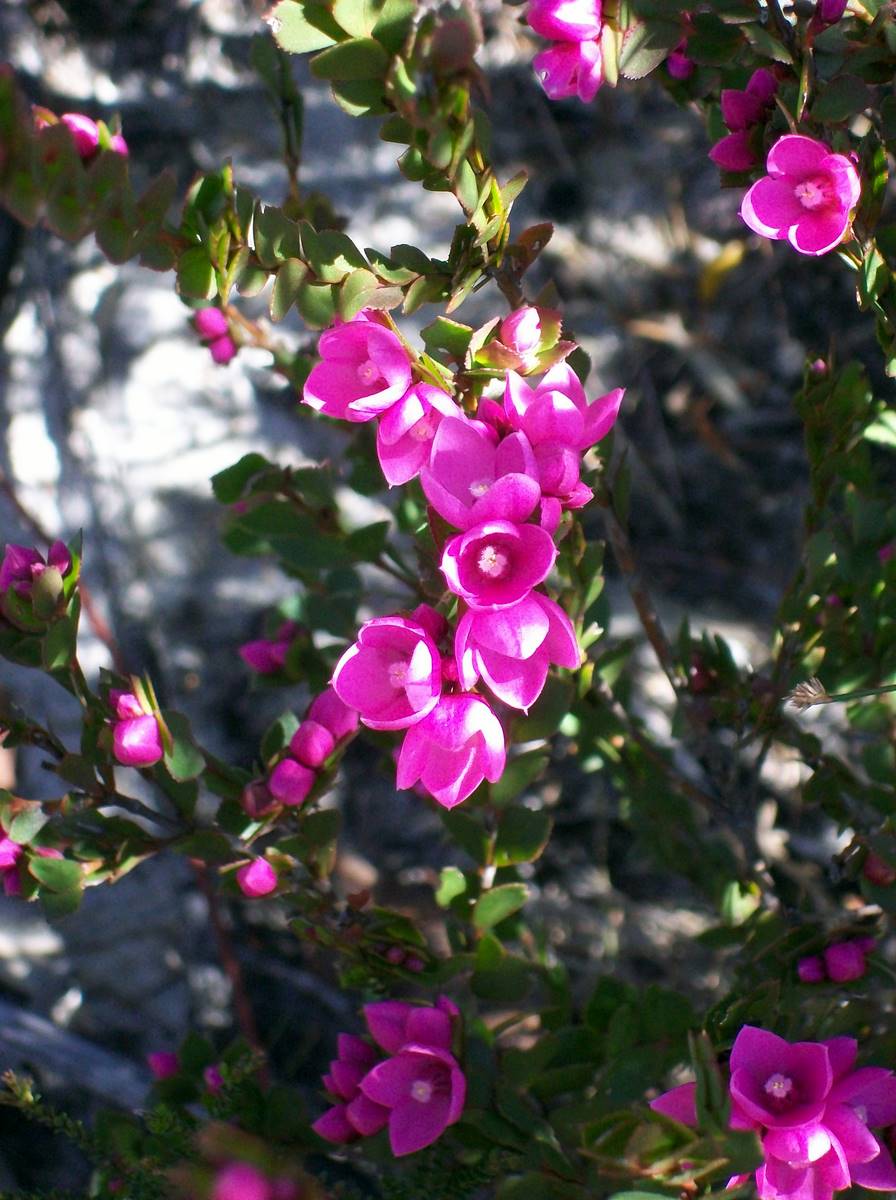
Native Rose, Waratah Track. Ku-Ring-Gai Chase National Park, Australia. Boronia serrulata. Photo: Peter Woodard
Another example, this excursion was conducted every second Saturday afternoon, even during Winter:
Native Flowers at Manly
Under the leadership of Mr. Haviland, a patty of members of the association proceeded to Manly last Saturday afternoon for the purpose of collecting wild flowers. The weather was cold and wet, but the meeting was both pleasant and instructive. In all, 38 specimens were secured, and named as follows :
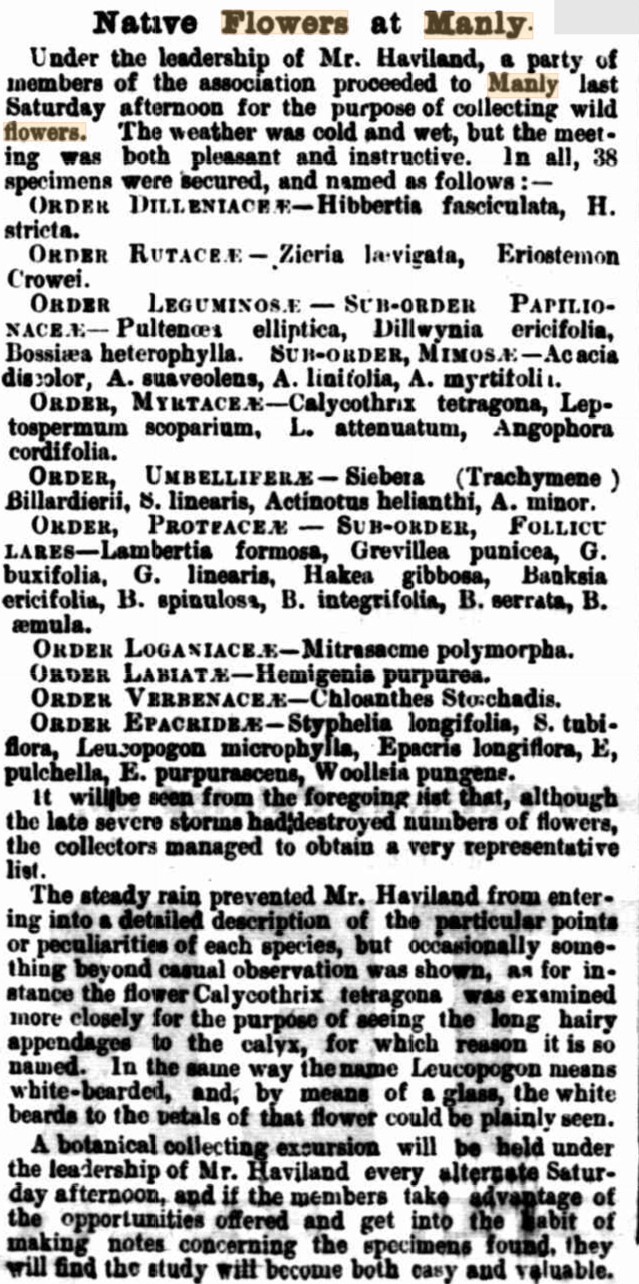
Native Flowers at Manly. (1889, June 8). The Sydney Mail and New South Wales Advertiser (NSW : 1871 - 1912), p. 1203. Retrieved from http://nla.gov.au/nla.news-article161933145
Eventually the hills were denuded of local flora to such an extent that laws were introduced to protect the wildflowers. Just as a law to protect birds and other wildlife was introduced because so many had been lost due to the imported English pastime of hunting for anything alive in the bush with a gun as 'sport' - and a cessation was tabled to be held during 'breeding season' so the next generation could be killed too - steps were taken to try and save the pillaging of the bush. Even though that did not stop those other aspects of human nature - greed, selfishness and theft - it may have stopped some species, but not all, becoming locally extinct.
The Manly Wild Flower Shows were initially held in a pavilion in Ivanhoe Park that had served as a venue for the 1870 Metropolitan Intercolonial Exhibition, held in the newly established Prince Alfred Park, Surry Hills, immediately south-east of the central business district.
Two of the refreshment pavilions from the exhibition, one large, and one small, were transferred and re-erected at Manly Beach in January 1871 on land known as Ivanhoe Park, then owned by Henry Gilbert Smith, the founder of Manly, acquired 100 acres on 9 March 1853 at what was then referred to as Cabbage Tree Bay (now Manly), from John and Anne Mary Thompson for ₤800. The large pavilion was promoted as being the “largest Pavilion in the colonies”, and said to cover 9000 square feet.
Mr H W Wardle, formerly the Manager of the Royal Pavilion Gardens, London, erected and managed the dance and entertainment pavilion in Ivanhoe Park, Manly in the 1870s. was the proprietor of the Park in 1873, and probably earlier.
Although John Farrell, of the New Steyne Hotel (not to be confused with the present Steyne Hotel), is seemingly the first to make use of the pavilion, the Eight Hours Demonstrations and Eight Hours League:
“NEW STEYNE HOTEL, MANLY BEACH
I, the undersigned, beg to inform the Public that I have taken the Pavilion, lately erected in Ivanhoe Park,
for Anniversary Day [1871], where I intend to have a great variety of sports and amusements. A band
engaged for dancing. JOHN FARRELL” Advertising (1871, January 14). The Sydney Morning Herald (NSW : 1842 - 1954), p. 9. Retrieved from http://nla.gov.au/nla.news-article13220096
EIGHT HOURS' DEMONSTRATION.
THE annual picnic of the Eight Hours' League was held at Ivanhoe Park, Manly Beach, on Monday, February 27. The day's proceedings commenced with a procession, which was formed at an early hour, in the vicinity of the site of Captain Cook's Statue, Hyde Park. A large body of men, connected with the movement, assembled for the purpose of assisting in this portion of the demonstration ; and accompanied by two fine bands, that of the Naval Brigade leading, proceeded through the principal thoroughfares of the town.
The line of march led southerly until the Haymarket was reached, when the procession turned into George-street, along which thoroughfare it proceeded until King-street was gained, and eventually passed down Pitt-street to the Circular Quay, where an immense number of excursionists had collected. The procession was headed by a flag, on which was depicted a beehive, with the motto ' ' May industry be rewarded. " This was followed by a large banner, inscribed with various mottoes connected with the movement, the principal being the old axiom that "Union is strength." Numerous smaller banners were interspersed along the line, bearing suitable inscriptions, such as :-
." Eight Hours' Labor" "Eight Hours' Recreation"-"Eight Hours' Rest," & c.
Our view is taken from that portion of George-street near Goulburn street, and depicts the procession emerging from the neighborhood of the Haymarket. Large bodies of people, attracted by curiosity, or bent on pleasure at the consequent picnic, gave variety and animation to the scene.
Two powerful steamers, the Goolwa and Breadalbane, were laid on to convey the large concourse to the pleasant scene appointed for their amusement, and before two o'clock no less than three thousand persons had been conveyed to the spot. Ivanhoe Park is a pleasure ground admirably adapted for the enjoyment of visitors. It is spacious, sheltered, and shaded with numerous trees-some of them most grotesquely shaped.
The dancing pavilion, (a building that did duty as Muscutt's saloon during the late exhibition,) affords almost unlimited space for dancers, and is perhaps the most spacious and substantial of its kind, being roofed with corrugated iron, glazed at the sides, and otherwise protected. Adjoining this is an octagonal pavilion of good proportions and highly ornamental appearance, used as a refreshment room: and in addition to these there are several ornamental buildings for the shelter of visitors.
At two o'clock, a limited number sat down to dinner, provided by Mr. Tidswell, and presided over by Mr. John Stewart. M.L.A., assisted by Alderman Goold. The usual toasts were vigorously responded to, and a good deal of information was ventilated concerning the future intentions and prospects of the League. The great body of the company preferred an al fresco luncheon ; many of the visitors lighting fires in woodland nooks, and with snowy cloths spread on the 8 ward, and plentifully supplied with temptations to the appetite, they enjoyed themselves literally "to the full."
Dancing was kept up uninterruptedly throughout the day ; some joined in cricket ; quoits and skittles divided the attention of others ; some looked at the always attractive drama of " Punch and Judy ; " others witnessed the somewhat awkward evolutions of some self styled " acrobats ; " a wandering band of "niggers" engaged the attention of more ; and the youngsters revelled in the intoxicating Merry-go-round, the breathless swing, and exciting races, for which the committee had thoughtfully provided prizes in the shape of some handsome books.
The most admirable order prevailed, and if visitors failed to enjoy themselves it was certainly not owing to want of forethought on the part of the committee, for the gentlemen composing that body for once seemed to succeed in the proverbially difficult task of pleasing everybody.
Stay ! there is no rule without an exception, and the exception on this occasion consisted of several sharp individuals who endeavoured to introduce " a bit of gambling pleasure" and whose "little games" were effectually put a stop to by one of the committee aided by the police. " Old Aunt Sally" (being a lady) was tolerated-but as several " experts" knocked her about the head most unmercifully, and broke her pipes to an alarming extent, thereby winning many contingent cigars ; the proprietor passed the day in a higher state of dudgeon than of profit. By nine o'clock everybody was safely landed at the Circular Quay, and the general order and good feeling displayed throughout the day was a convincing proof that the working-man enjoys himself-as he labors-with a will.
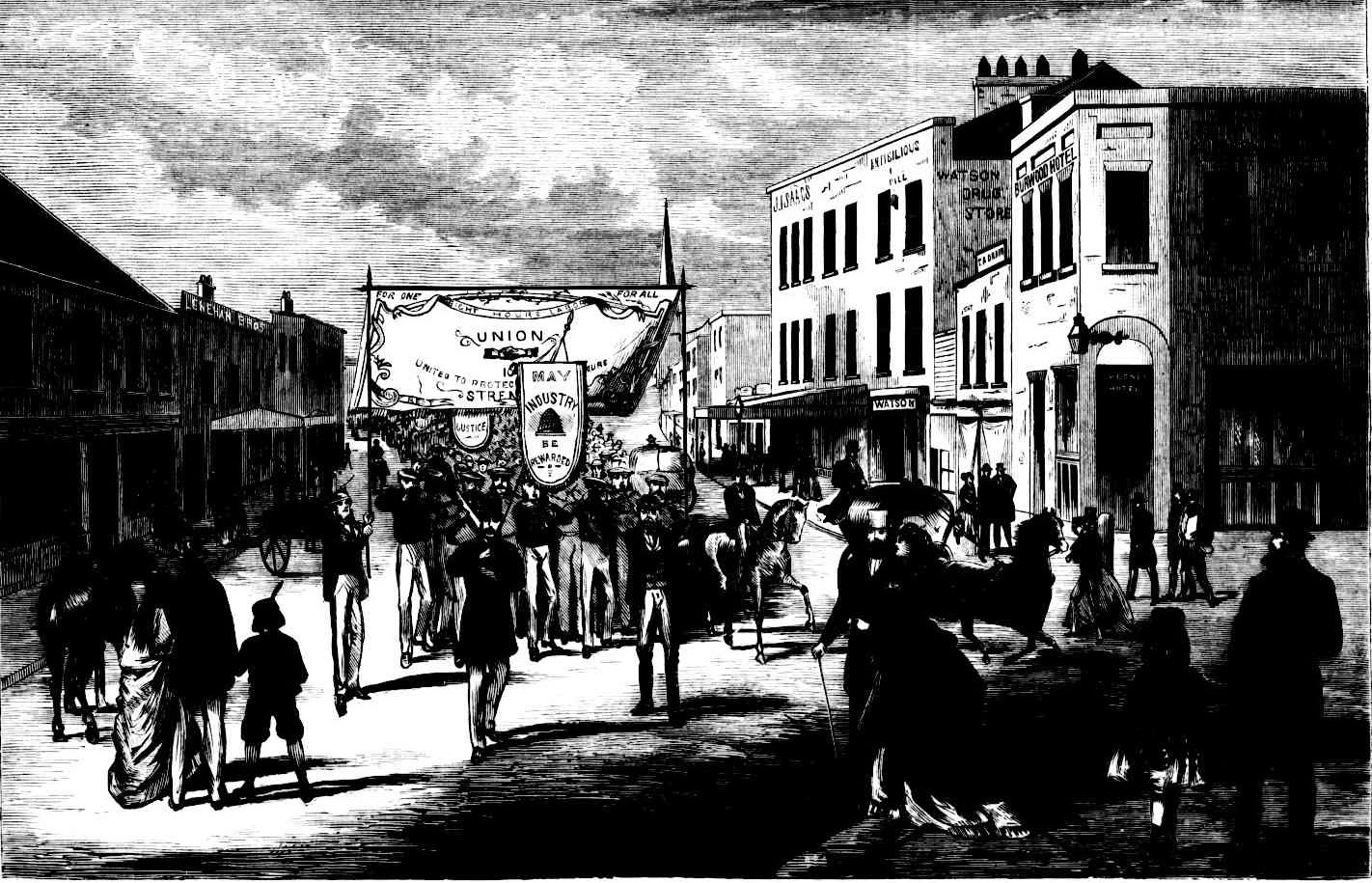
EIGHT HOURS' DEMONSTRATION.-SEE PAGE 147.
EIGHT HOURS' DEMONSTRATION. (1871, March 18). Illustrated Sydney News (NSW : 1853 - 1872), p. 3. Retrieved from http://nla.gov.au/nla.news-article63618049
EIGHT-HOUR DEMONSTRATION— MANLY BEACH.
THE members and friends of the Eight-hour League held their usual Annual Picnic at the delightful grounds of Ivanhoe Park, Manly Beach, on Monday, 19th ult. Three commodious steamers were engaged to con-vey the pleasure-seekers to their destination, and at a very early hour the Circular Quay was thronged with intending visitors.
The members of the League marched in procession through the principal streets of the city, carrying banners, and headed by a band of music.
On arriving at Manly Beach, the excursionists scattered about in various directions, the main stream wending its way to Ivanhoe Park—the centre of attraction. In these pleasant grounds every variety of amusement was provided : cricket, football, swings, dancing in the great pavilion to the strains of the Volunteer Brigade Band, Aunt Sally, &c. These kept the visitors well engaged till the ringing of the luncheon bell.
The luncheon was served in a large marque specially erected for the occasion, and which was decorated with banners and evergreens. The dinner was presided over by the Hon. W. C. Windeyer, Esq., and, in the absence of Mr. John Stewart, the vice-chair was occupied by Mr. Chapman.
After the usual loyal toasts, the chairman introduced the toast of the day, " Success to the Eight-hour Movement. " In an able and very instructive speech, he dwelt at considerable length on the advantages of the league, and on the beneficial results attend-ing the organization of similar movements in Great Britain.
The company present was also addressed by Mr. John Young, contractor ; Mr. Holland, and other gentlemen.
The visitors who did not join the luncheon party procured refreshments in abundance from various stalls about the grounds, or formed gipsy-like encampments under the overhanging rocks or antique gum-trees, and there, with table-cloths outspread upon the turf, and an abundance of good cheer, made themselves very jolly under the circumstances.
The sports continued until the shadows of evening closed over a really enjoyable day, and the excursionists returned to town very shortly after dark. EIGHT-HOUR DEMONSTRATION— MANLY BEACH. (1872, March 19). Illustrated Sydney News (NSW : 1853 - 1872), p. 2. Retrieved from http://nla.gov.au/nla.news-article63618558
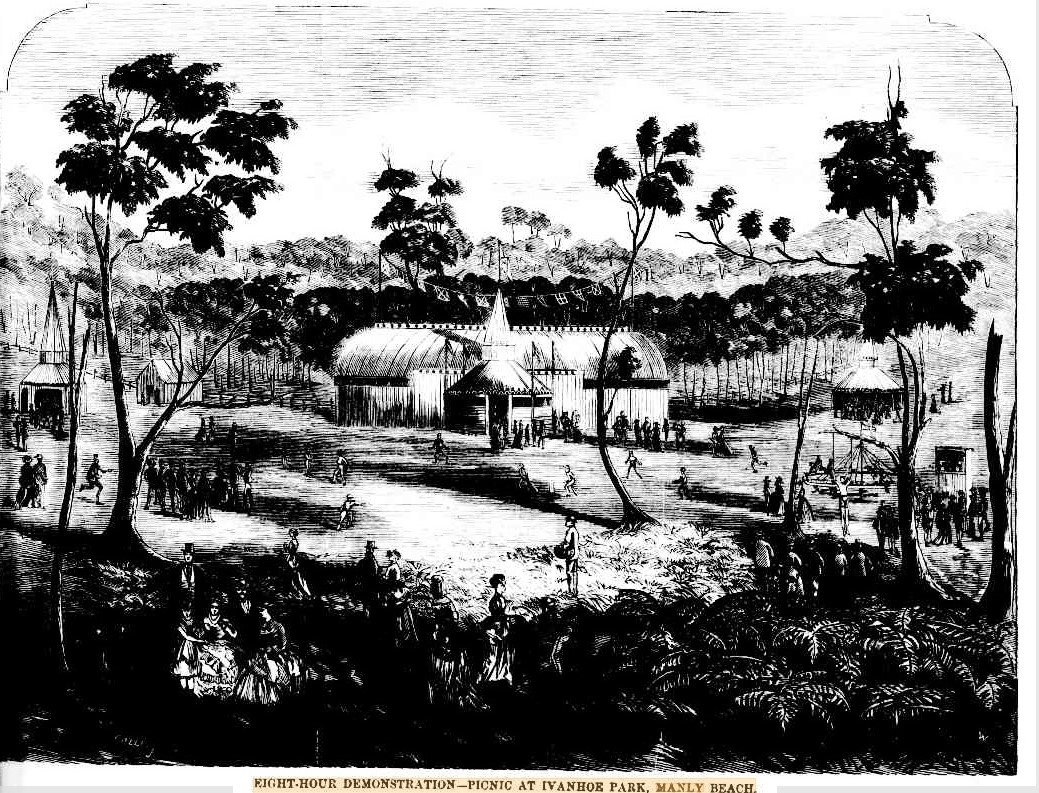
EIGHT-HOUR DEMONSTRATION-PICNIC AT IVANHOE PARK, MANLY BEACH. THE MONTH. (1872, March 19). Illustrated Sydney News (NSW : 1853 - 1872), p. 1. Retrieved from http://nla.gov.au/nla.news-article63618556
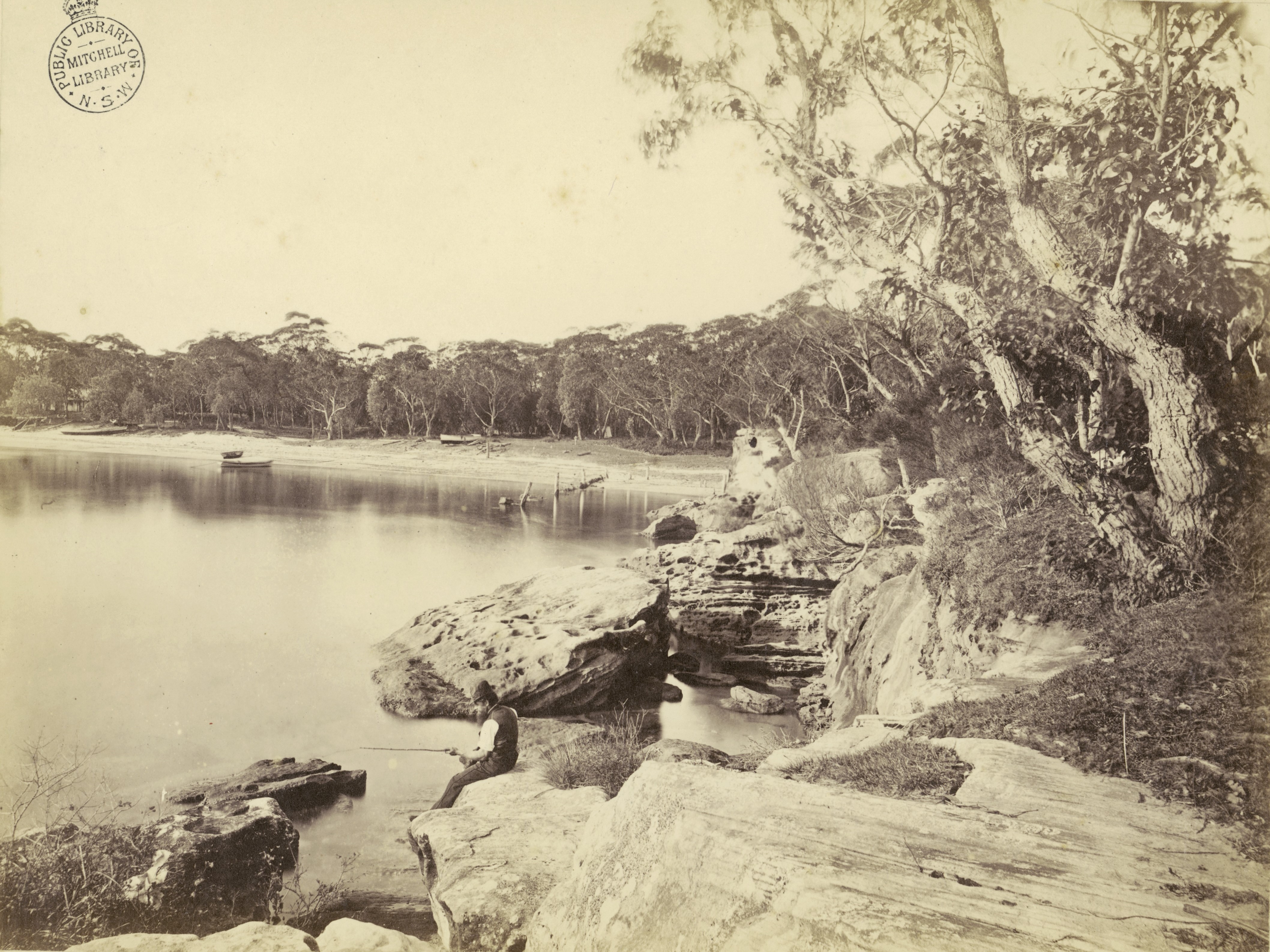
'At inner Manly', undated [ca. 1870-80s], courtesy State Library of New South Wales, Item: SLNSW_FL1230476
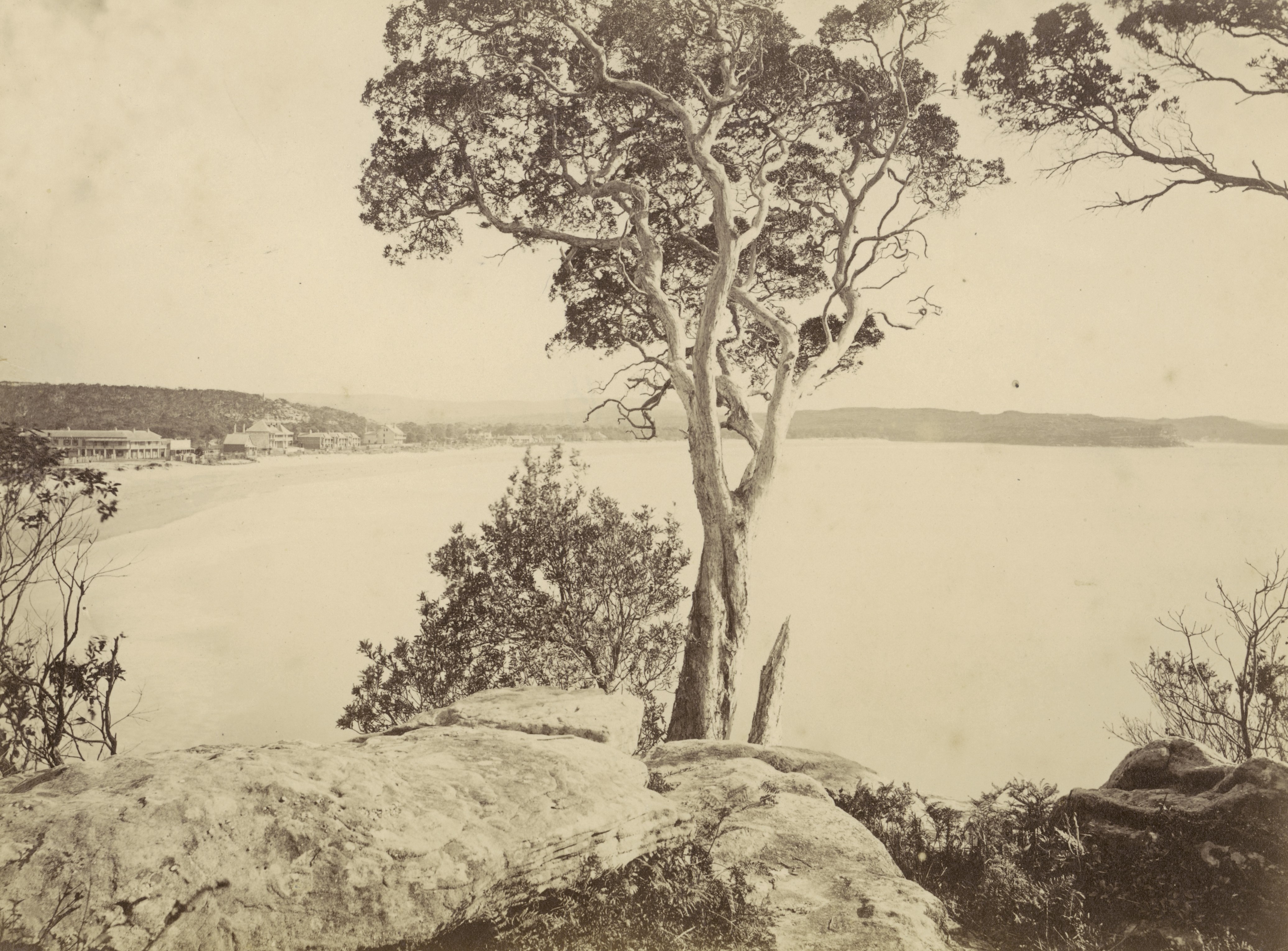
Ocean Beach, Manly, undated [ca. 1870s], Lambourn's Hotel, Corso, Manly, at left, courtesy State Library of New South Wales, Item: SLNSW_FL1227131
The first Manly Wildflower Show opened on October 1st, 1881 - the newspapers of then recorded:
THE WILD FLOWER SHOW.
A novel floor show will take place at Manly Beach to-day. It will be an exhibition of wild flowers, and although no one who has rambled through the bush at North Shore, or down by Coogee and Bondi, could have failed to observe some at least of the multitude of lovely bush blossoms which excited the admiration of the earliest visitors to Australia, it can with equal truth be said that the public has not hitherto had the opportunity of inspecting such an extensive, collection of these fragile flowers as may be seen to-day. The exhibition, which is under the patronage of his Excellency the Governor and Lady Augustus Loftus, will be in aid of the church enlargement fund. Masses will be provided during the day by the band of the Permanent Force, while at night there will be concert at the pavilion. THE WILD-FLOWER SHOW. (1881, October 1). The Sydney Morning Herald (NSW : 1842 - 1954), p. 6. Retrieved from http://nla.gov.au/nla.news-article13495903
EXHIBITION OF WILD FLOWERS AT MANLY.
One of the finest exhibitions of ferns and wild flowers ever seen in the colony was held on Saturday last, at Manly, and attracted a large number of visitors to that favourite watering place. On entering the Pavilion the scene beheld was of surpassing beauty. A fountain, decorated by Mrs. Rowe, played in the centre, which was most refreshing to the eye; and all around were grouped in wreaths, bouquets, and quaint devices, wild flowers of great beauty. The waratah and gigantic lily were striking features in the exhibition, and, together with the rock lily and native rose, of which latter there are several varieties, were much admired. The bouquets exhibited by the Misses Underwood, and the grand display made by Mr. Morris, were also the theme of general admiration.
The specimens of Blandifordias were not the best that have been seen, but these, it was stated, were the only ones procurable. Some of the flora which attracted so much attention were plants of great value that would adorn any garden. Several tastefully arranged festoons gave a charming appearance to the scene, and denoted the praiseworthy exertions of the ladies, to whom the success of the exhibition was mainly due.
In connection with the show a concert was given in the evening, in aid of the enlargement fund of St. Matthew's Church, which also proved a great attraction, and had a successful result. The programme was carefully performed, and afforded much gratification to the large audience assembled.
Among those who took part were Messrs. James, H. R. Woods, H. F. Francis, Pitt, Rev. Dr. Ellis, Miss Sachs, Mrs. H. R. Woods, and Mrs. Percy Rowe.
The wild flowers, which were arrayed in button-hole bouquets, wreaths, &c,, sold rapidly at good prices. The children of the Public school, under Mr. Flashman, also took part in the sale with much zest, and the ladies who held stalls were Mrs. Alfred Hilder, Mrs. C. H. Hayes, Mrs. Augustus Morris, Miss Underwood, Mrs. Austin, Mrs, Geo. Thornton, Mrs. John Wood, Mrs. Willis, and Miss Cohen.
Sir John Hay, who took a great interest in the proceedings, opened the exhibition with a neat and appropriate speech, congratulating the people of Manly on the excellence of the display of their own native wild flowers.
The various specimens were critically examined by the visitors, and indeed they would have charmed a botanist, while the lilies from the National Park at Port Hacking — magnificent specimens of the Dorynnthus exceisur — were as admired as any of the exhibits.
Messrs. Searle and Sons exhibited a handsome bouquet of wild flowers. The rare Cocoiuea from West Australia, shown by Mr. A. J. Ralston, was a decided acquisition to the . show, and a cutting of a native white rose realised a good price.
Mr. John Sands exhibits (for exhibition only) some exquisite drawings of wild flora by Mrs. Rowan and others, and these form quite a feature of the display. Messrs. Lassetter and Co., Webb and Son, and Holdsworth, Gardyne, and Co., lent some handsome vases, which set off the show-room to great advantage.
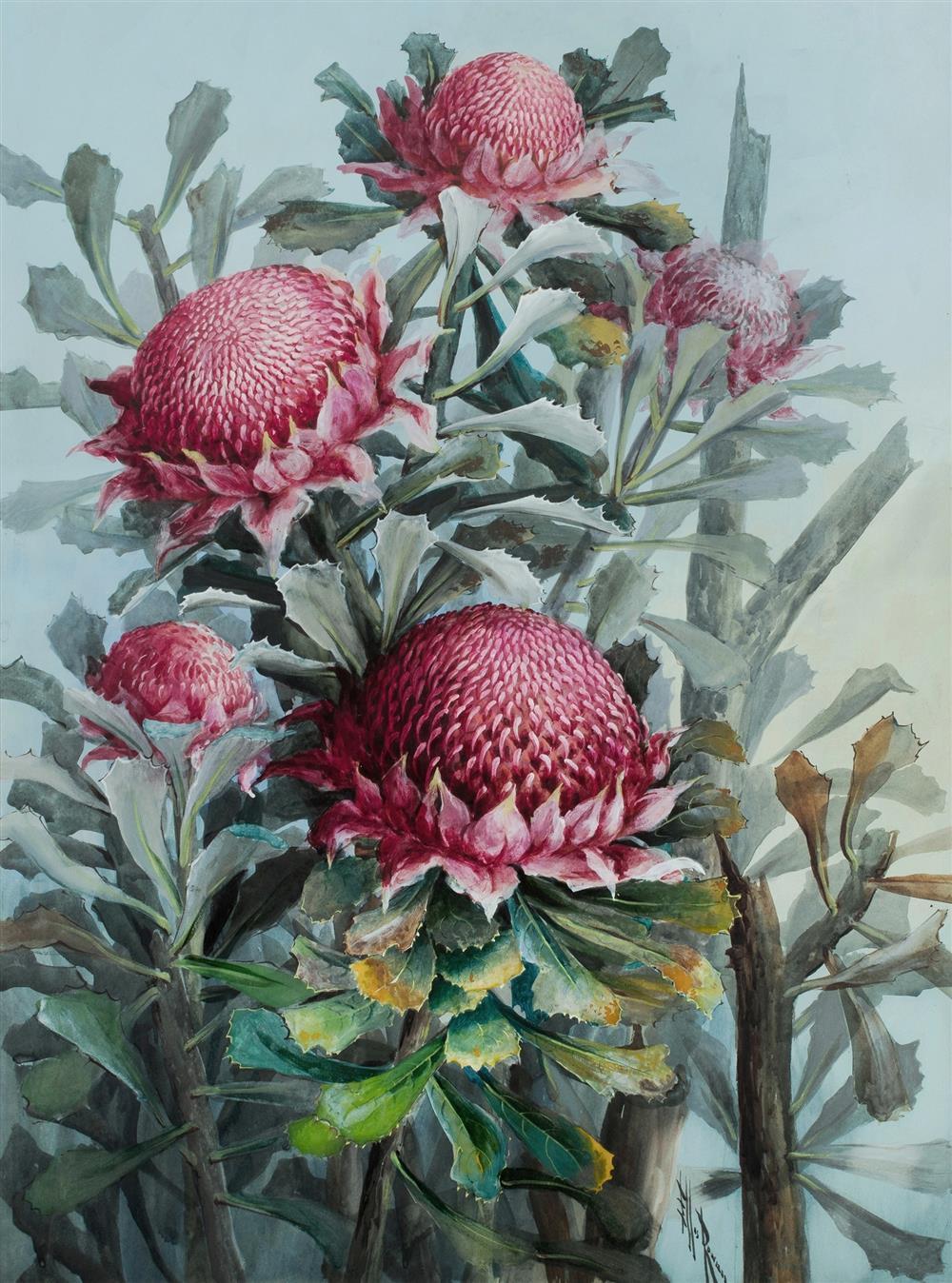
Waratahs, NSW State Floral Emblem., Gouache & W/Clr, by Ellis Rowan
The fernery, as arranged by Mr. Goodenough, was very attractive. The wonderful tree ferns, rock lillies, etc., which grow plentifully around Manly, were tastefully arranged, and it was pleasant to rest by them and inhale the faint perfume of the flowers all around.
The prizes were distributed in the afternoon, Mrs. Willis taking the one for the best arranged, and Mrs. Forde for the best water-colour drawing of native flowers.
Mr. Charles .Moore, director of the Botanic Gardens, and Dr. Bennett, acted as judges. The show was continued yesterday. EXHIBITION OF WILD FLOWERS AT MANLY. (1881, October 4). The Sydney Daily Telegraph (NSW : 1879 -1883), p. 3. Retrieved from http://nla.gov.au/nla.news-article238312564
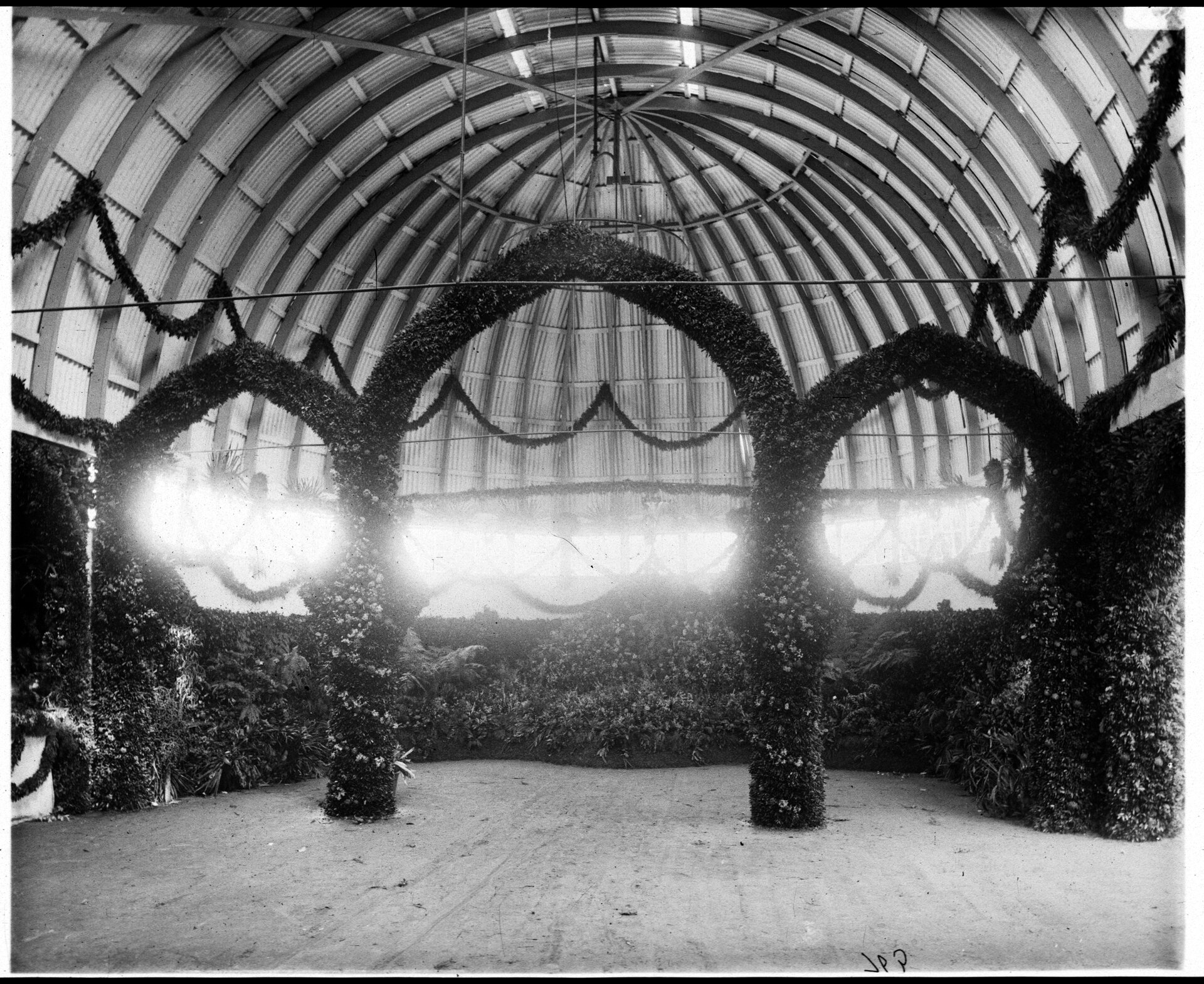
Manly Wildflower Show, date unknown. Photo: NSW State Records and Archives.
Wild Flower Show at Manly
A NOVELTY in floral shows was recently introduced at Manly, near Sydney, when an extensive and admirably arranged display of wild flowers took place in the pavilion, Ivanhoe Park. The show was held in aid of the fund for enlargement of St. Matthew's Church, Manly, and the plan adopted was an excellent one in a moneymaking sense, being a combination of the principal features of a horticultural show and a charity bazaar. A number of energetic ladies had stalls allotted to them, as at a bazaar, with carte blanche to decorate those stalls according to their respective tastes, and exhibit as many native flowers as they could procure.
The exhibits principally took the form of bouquets, button-holes, wreaths, mottoes, and baskets, and these were offered for sale, or raffled, from prices ranging from 6d. and Is. for button-holes, to 10s. and 15s. for bouquets. The stalls were ranged along each side of the building and down the centre, in the following order, commencing at the entrance :-
Public school children, under the direction of Miss Flashman ; Mrs. C. H. Hayes, Mrs. Augustus Morris, Miss Underwood, Mrs. Austin, Mrs. Geo. Thornton, Mrs. Alfred Hilder, Mrs. John Woods, Mrs. Willis, and Miss Cohen.
All these ladies appeared to have devoted their best efforts to make the stalls attractive, with the most gratifying results, the only drawback being the impossibility of many of the visitors properly seeing the display in consequence of the densely crowded state of the pavilion.
The varieties of flowers shown included waratah, native rose (both' red and white), zamia, rock lilies, mustard flower, Christmas bells, white heath, flannel flower, star of the south, and a hundred other varieties. Some splendid specimens of the gigantic lily {Doryanthus excelsior) from the National Park, at Port Hacking, were sent by the trustees ; Messrs. Searle and Sons sent (for exhibition only) a very fine bouquet of wild flowers ; Mr. A. J. Ralston exhibited a cutting of the Kennedya coccínea, a West Australian flower very rarely seen in this colony; and Mr. W. M. Jackson sent a fine cutting of the white native rose, which was disposed of at a high price.

THE NATIVE WILD FLOWER SHOW AT MANLY.
Wild Flower Show at Manly. (1881, October 29). Illustrated Sydney News and New South Wales Agriculturalist and Grazier (NSW : 1872 - 1881), p. 16. Retrieved from http://nla.gov.au/nla.news-article64974679
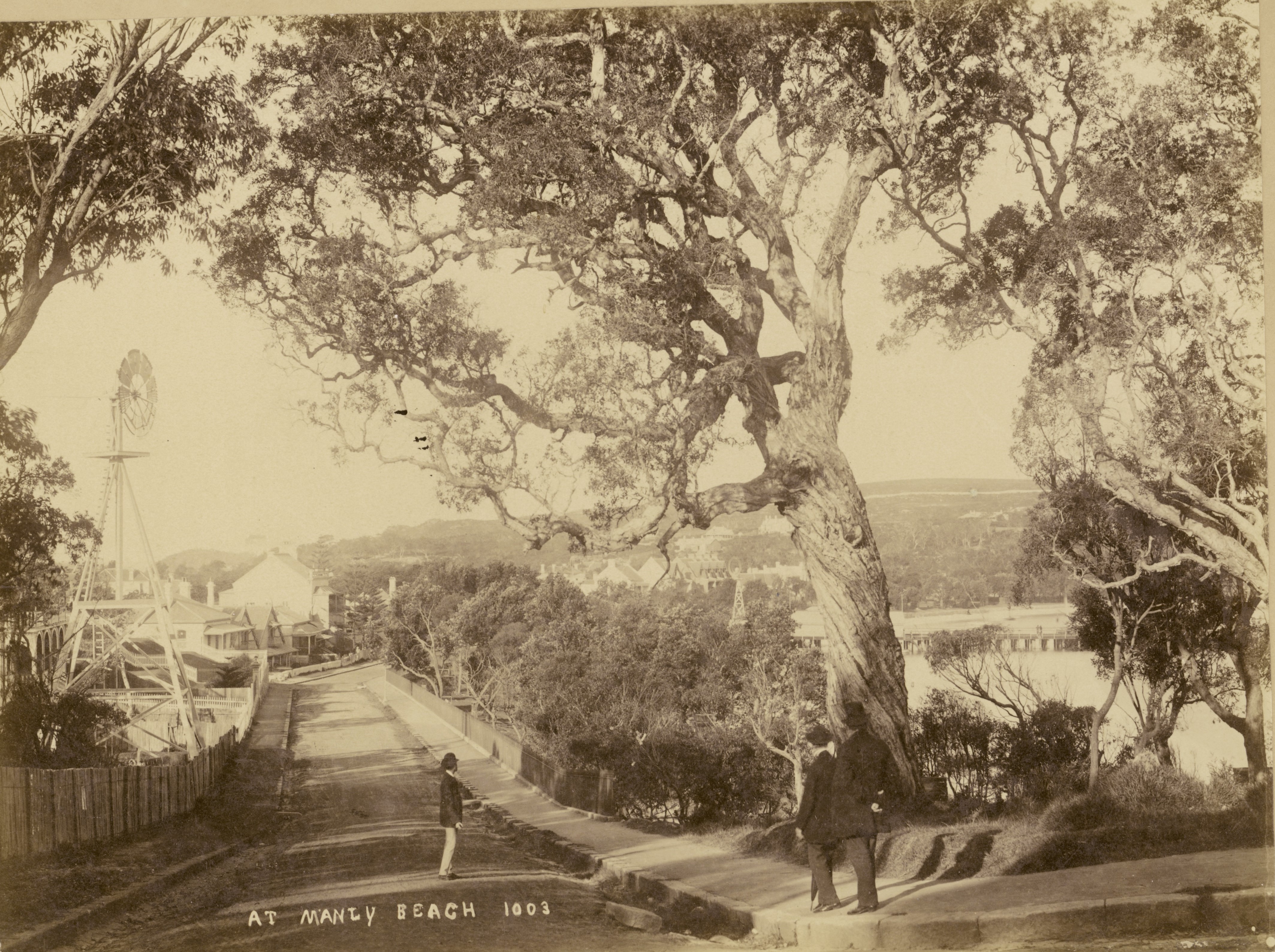
At Manly Beach, circa 1880, courtesy State Library of New South Wales photo by Frank Arnold Coxhead, Item: SLNSW_FL1226353
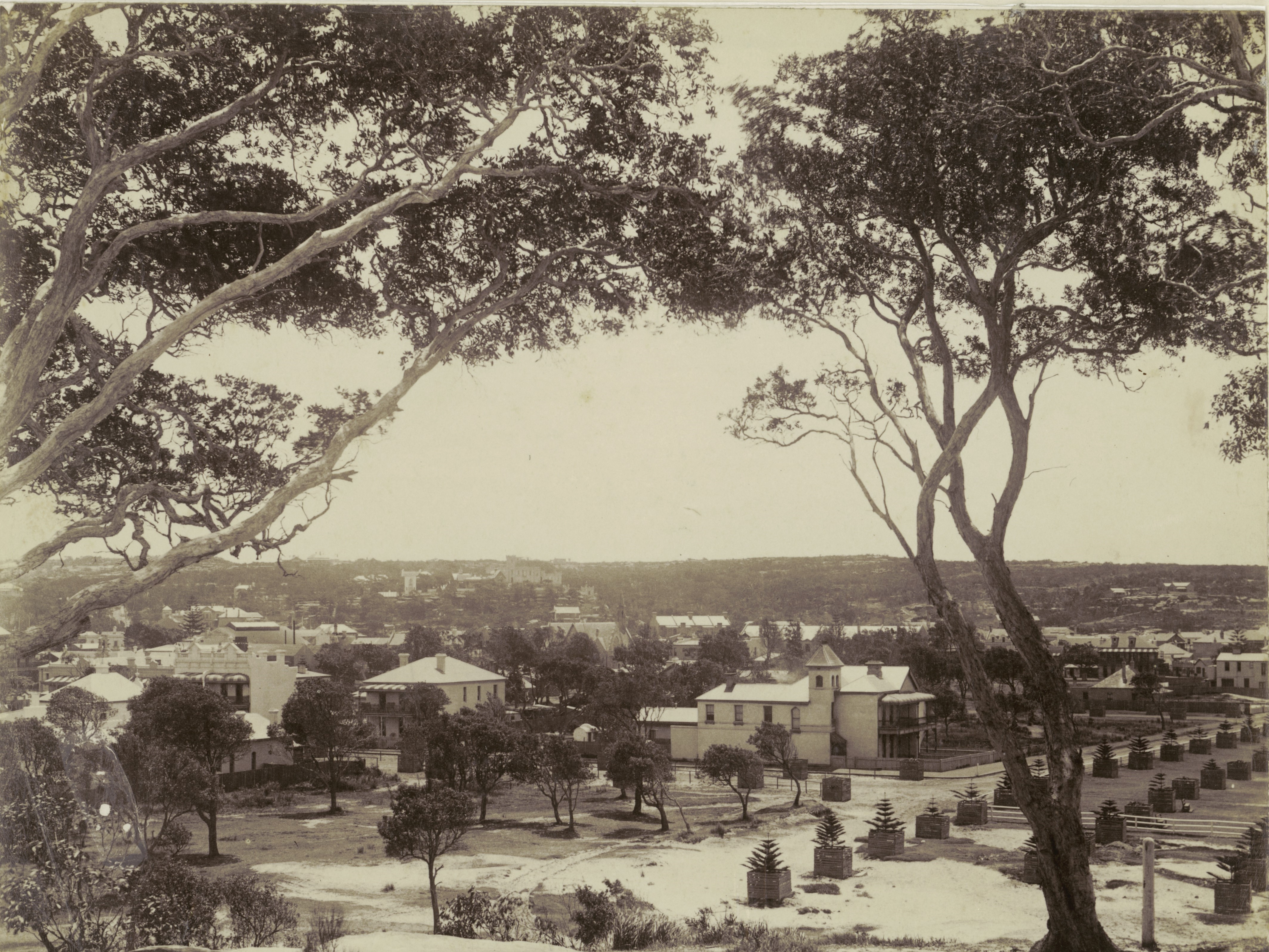
View of Manly, circa 1881-82, courtesy State Library of New South Wales In the foreground, residences and pines protected by tree guards; Looking toward 'Marinella' (Dalley's Castle, built in 1881 for William Bede Dalley) at centre, Item: SLNSW_FL1230056
A report about the 1883 show records the idea spreading:
SHOW OF WILD FLOWERS AT MANLY.
The promoters of the wild flower show at Manly are to be congratulated upon the success which has attended their very pleasing and instructive exhibition. Special steamers were put on to Manly on Saturday, and every one of them was crowded with passengers. During the greater part of the day there was a constant stream of visitors going to and from the pier at Manly and Ivanhoe Park. The steamers carried between 4000 and 5000 persons to the watering-place, and it is hardly necessary to say that the pavilion which had been made so attractive with its wealth of flowers and so instructive with floral designs, was thronged throughout the afternoon. Amongst the visitors to the show were the Premier (the Hon Alexander Stuart), the Hon. R. L. Cohen, the Hon. F. A. Wright, Sir John Robertson, Sir Alfred Roberta and his Honor Mr Justice Windeyer.
Between 6 and 6 o'clock the crowd began to thin and the stallholders commenced to illuminate their stalls for the evening exhibition, which was also largely patronised The illumination of the main building was accomplished with patent portable gas and coloured lights, whilst a number of Chinese lanterns were suspended in the Rotunda. The scene was very claiming, the fittings for the portable gas were kindly supplied by Mr Kelley. the attractiveness of the stalls was considerably enhanced by the collections of glassware lent for the occasion by Messrs. Lasetter and Co., Messrs. 'Webb and Co., and Messrs. Bray Bros.
The City Band, under the conductorship of Mr S. Hodge, performed the following programme of music in the afternoon -1. March, "Endymion," Devery; 2 Polka, " Cornstalk," Hon. G. Thornton; 3. Overture, "Domino Noir," Aubor, 4. Waltz, "Bulwarra," Stevens; 5. Selec-tion, " Ltv Hilo do Madame Angot," Lceocq; G. March, " Victoria," Riviere, 7- Selection, "Maritana," Dubois 8 Quadrille, " Como," D'Albert, 9. March " Charlie and Minnie," Godfrey: 10. Galop, "Brighton," Lutton,
The sale of flowers at the stalls amounted to upwards of £180. We understand that the Port Jackson Steamship Company have promised that they will give to the church building fund 50 per cent. of the receipts in excess of the ordinary traffic.
A wild flower show will be held in the North Willoughby School of Arts, in aid of the building fund of the convent at Lane Cove, on Saturday 29th September, Monday and Tuesday, 1st and 2nd October. A concert will be held each evening, at which lady and gentleman amateurs will assist. SHOW OF WILD FLOWERS AT MANLY. (1883, September 17). The Sydney Morning Herald (NSW : 1842 - 1954), p. 7. Retrieved from http://nla.gov.au/nla.news-article13544844
Show of Wild Flowers at Manly.
It is only when an exhibition such as that at Manly, on Friday, Saturday, and Tuesday, brings vividly before us the bounty of our native soil, its harvest of beauty, that we learn how really great is the floral wealth of our own home. About this time of the year there often pass through the dusty streets parties of young people who have brought from far up the harbour, bunches of wild roses, or lengths of wild sarsaparilla knotted with clustered purple blossoms; and these and a few other of the commoner bush flowers constitute the great mass of the people the flora of the colony. They have really no idea of the wonderful variety of flowers scattered over the fields and hills around them. Those who despise Australian wild flowers, and whose notions of our indigenous vegetation is confined almost to the limits of a knowledge of the ' eternal gum tree,' should have seen the show.
It is two years since the last show of native flowers was held there, and for days past the hills at the back, and the rocky heights along the shore, have been searched by eager parties of amateur botanists and florists. Happy was the one who found a great piece of native clematis now just breaking into blossom, or a fine bunch of lilies, or rarer than all a plant of the pun white native rose. Then the damp dark gullies were explored, and lovely ferns were found hidden away in the moss that 'lies amongst the sleeping stones.' Great indeed was the work of the flower finders, and wonderful was their success. The pavilion in Ivanhoe Park was a very 'bower of beauty.' Nothing prettier has been seen this season. It was opened at noon on Friday, and was, up till 6 o'clock in the evening, when it closed, visited by nearly 2000 people. The early afternoon steamers to Manly from Sydney were crowded— with ladies especially, and also very many gentlemen. Ivanhoe Park was made gay with lines of flags looped from staff to staff, and the pavilion newly painted, and, with the entrance framed in green leaves, looked also as pretty as need be. In the vestibule was a general stall, contributed to by all the stall keepers at the show ; and here encircled by a band of bouquets, and sheltered by a canopy of leaves and ferns, the ladies sold their dainty wares. The stall was presided over by Mesdames Willis and Thornton and a cloud of attendant Misses. It was beautifully decorated ; here, rich scarlet waratahs being set against a background of dark hued leaves, and there being laid out bouquets of forest flowers of every tint and form. Entering the hall the visitor was almost bewildered where to first gratify his sight.
All round were stalls laden with flowers wrought into fanciful devices, or gathered into one concentrated bouquet of a multitude of lesser ones. From each corner of the hall a leafy cable was linked to a central point, from which depended a basket of ferns and creeping plants. At either end of the room sprang an arch and foliage, and ?n ?utS middle space from arch to arch were gathered fem trees, palms, and staghorns. To the left the first stall was that of Mesdames C. H. Hayes and W. M. Jackson. Here all the flowers, in bouquets and other forms in which they were grouped, were noncompetitive, though to these ladies fell the honour of the prize for the best arranged stall. One of the principal exhibits in the stall was a miniature carpet bed, laid out with flowers on moss ; native roses, honeysuckle, blue 'oats' eyes,' and a variety of other blossoms, being formed into stars and other shapes, and surrounded with moss. At short spaces mirrors were set on the carpet, and the toy swans upon them appeared as though swimming on miniature lakes. The ladies' in this stall had put together some really charming bouquets. The great fault, if one can be found in so excellent a show, would be, we should say, the rather crude and inartistic manner in which some of the bouquets were composed. They were too prim and set. Flowers to look their best must be arranged most naturally, and a series of concentric rings or bands of flowers of similar colours, or spaces of white picked out at regular intervals with patches of red or blue flowers, do not represent the acme of beauty. In avoiding this fault, so general among amateur florists, the ladies of this stall were most successful, and some of the bridal bouquets, with beautiful crisp little mow flowers, relieved by lemon-coloured sprigs of rock lily, and the whole seen through a lace work of delicate green maidenhair fern, were perfect little works of art.
An Exquisite Heart Service was one of the best of the exhibits, and seat to this emblem of charity were kindred services of the emblems of faith and hope. The next stall— at the head of the hall was that of Mrs. Morris and Miss Miller. There were two very prominent exhibits at this stall, one a dado, from three to four feet in height, formed of squares of different coloured flowers, such as waratah, native rose, daphne, and paeans, in all about eight varieties : and the w... at bank of flowers containing about 8 different varieties, and whose apex was downed by a magnificent Prince of Wales feather formed of rock lilies. Some splendid waratah and lilipilli were also shown in this stall. Mrs. W. R. Rowe and Mrs. Warburton had the next stall on the opposite side of the li'l. Here a most perfect Japanese garden is laid out. It was a charmingly pretty presentation of a lake scene in miniature. A square of mirror was the lake, and the basket were built of very fine velvety moss, fine ferns and little buds serving for the shrubs and flowers and clumps of trees, and miniature fonts being made with larger ferns and plants. A Iittle house perched on a distant hill overlooks the lake on which boats were placed JitlWlsset as if filled with a light wind.
Q-rsice bouquets and baskets of flowers were shown, and also the novel device of two crowed tennis bats worked in flowers. The stall next in order to this 5 was that of Mrs. Medcalfe and Miss Underwood. There were several novelties, such as a parasol of flowers and a Union Jack worked in native roses, white forget-me-not, and blue flowers.
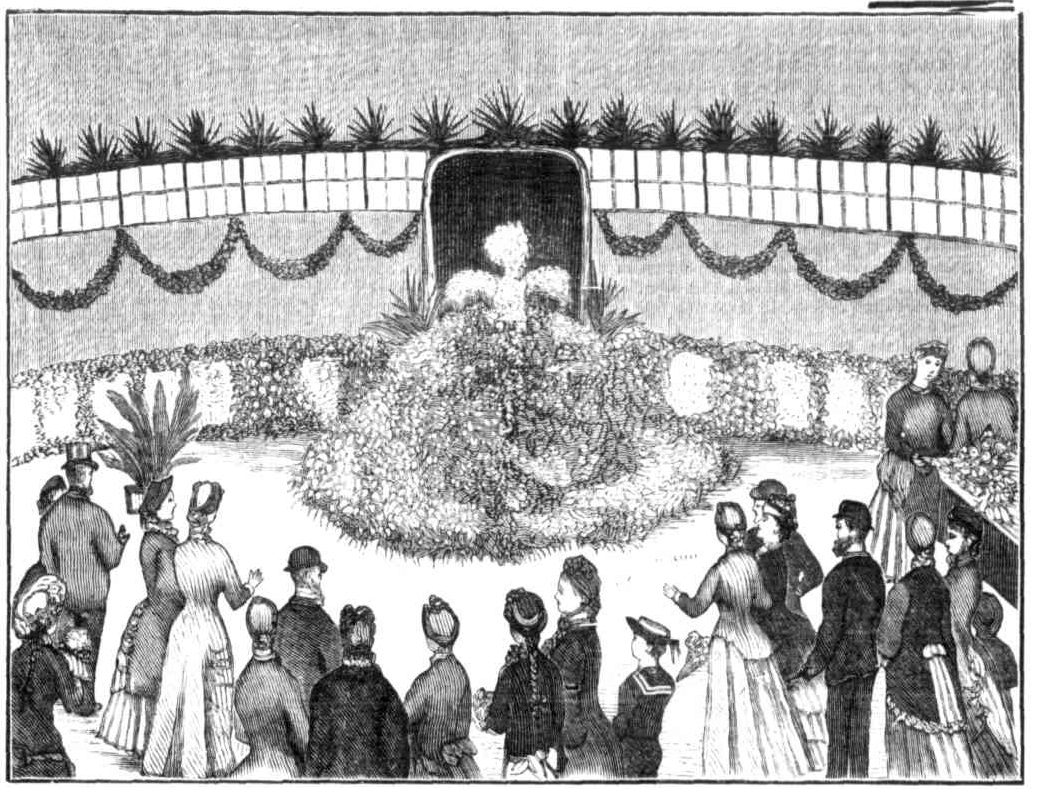
SKETCHES AT THE MANLY FLOWER SHOW.
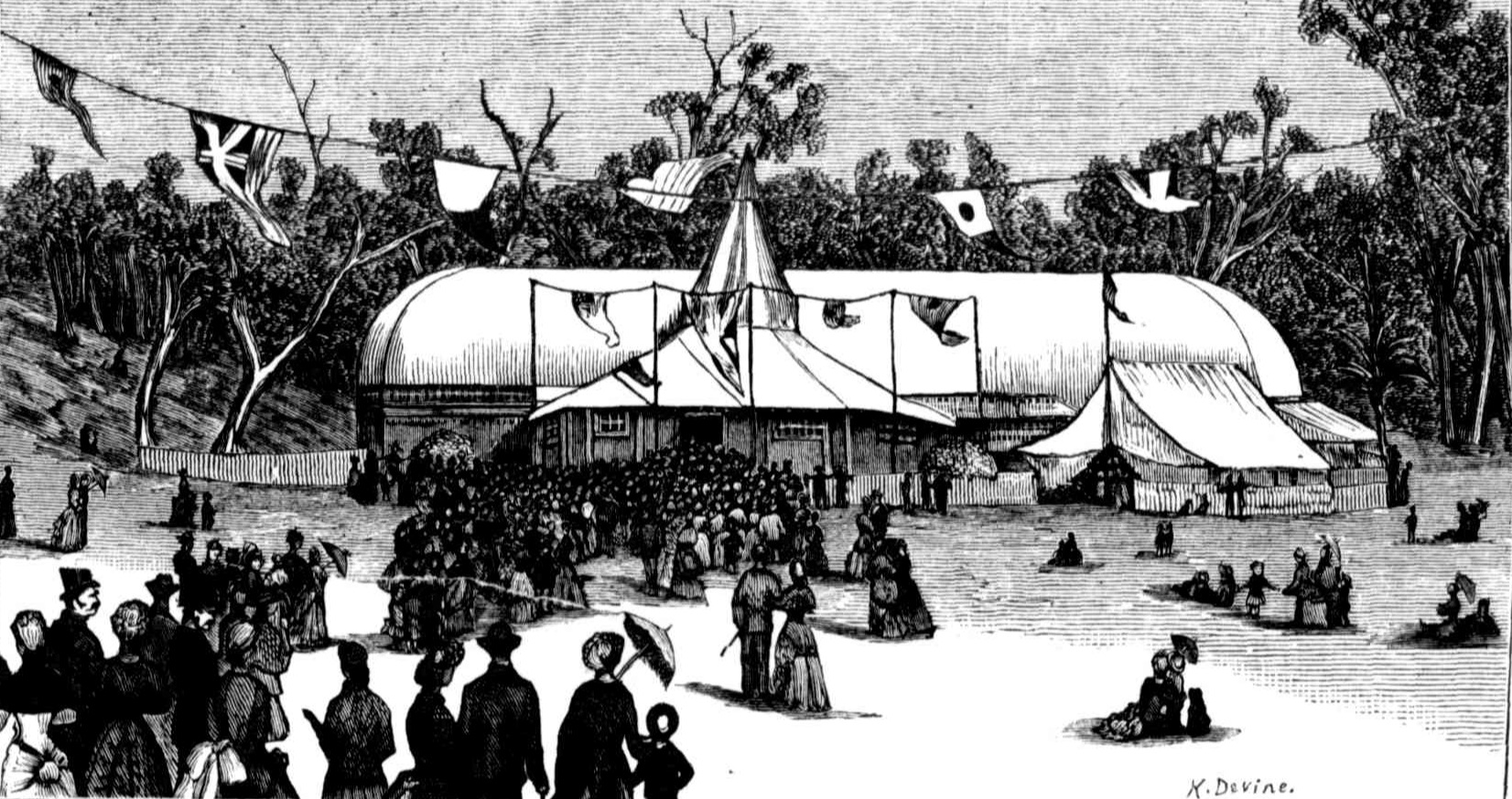
Sketches from Manly Wildflowers Show of September 1883 showing pavilion and original hotel in Ivanhoe Park, Manly and one of the displays within:
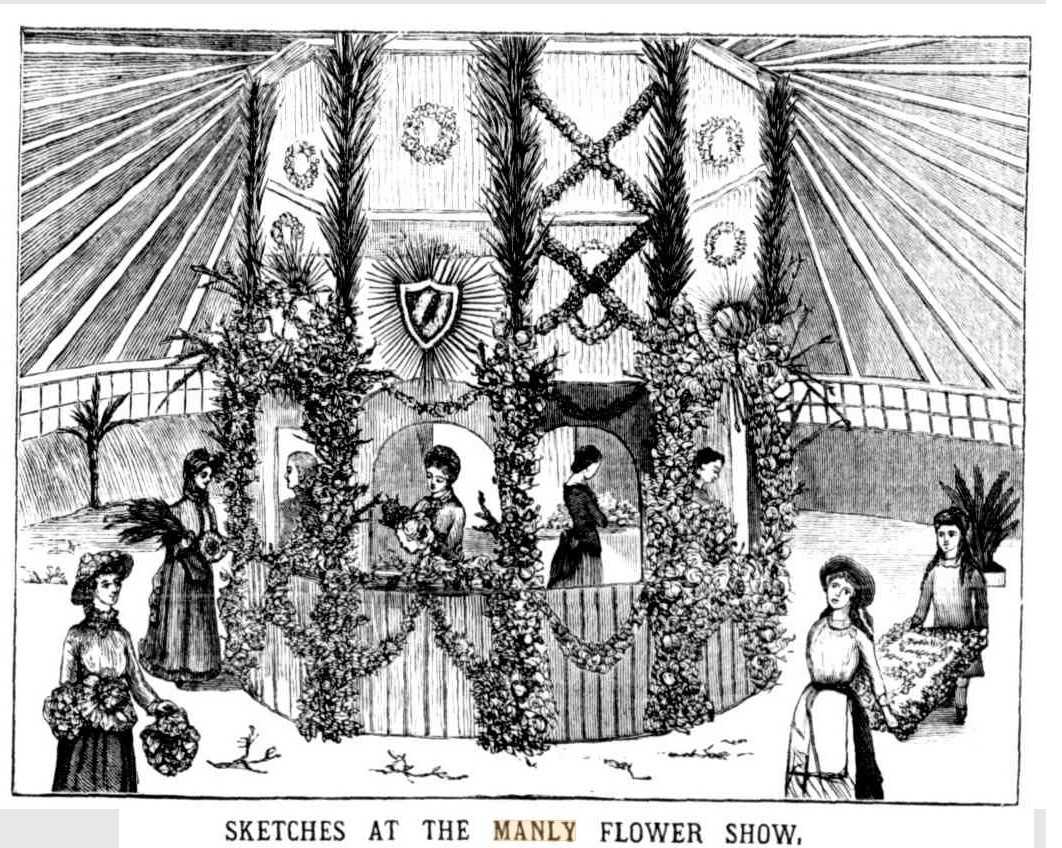
A bridal wreath, some very pretty bouquets, and flower baskets, where among the other exhibits. In the next stall, Mrs. George Smith had s very beautiful anchor worked in violet and white blossoms, and at the back of the many pretty bouquets on the stall was a rockery. Meadames Robey and Tedd had a very abundant display of bouquets, many of which were worked fancifully with stars and crosses. Here also was certainly the most perfect plant of the white wild rose m the hall. A handsome basket was worked in pink roses, spider flower, and lilipilli. At the back of the stall was very elaborately worked design in leaves and flowers bearing the Irish welcome. Mesdam.es Christian and Doddemead had a very neat fanner arrangement of wild flowers and some very large floral baskets. They, too, were the envied possessors of a quantity of white clematis, difficult to get so early in the season. A fine Prince of Wales feather in flowers was also a noticeable feature of this stall. Miss Smith had a novelty in the way of a Persian carpet in native roses, with a Prince of Wales feather embossed on it in small white flowers. Miss Stubbs showed a very fine bridal bouquet, indeed so fine that it found a purchaser at a guinea. A heart worked in native roses and native may and fringed with fern leaves, a harp whose strings were beaded with golden-hued blossoms, and other pretty devices were among her exhibits. Miss M'Keown had some Very nice flowers, and next to her stall was that of the school children of Manly, presided over by Miss Bardsley. The young people had succeeded in gathering a goodly quantity of flowers, and some of them showed a little taste in their arrangement. Some beautiful clusters of waratah were conspicuous. Miss Woods' stall had many flowers, and a model of the steamer Brighton framed in leaves and blossoms was a prominent exhibit.
During the greater part of Saturday there was a constant stream of visitors going to and from the pier at Manly and Ivanhoe Park. The steamers carried between 4000 and 5000 persons to the watering-place, and it is hardly necessary to say that the pavilion which had been made attractive with its wealth of flowers and so instructive with floral designs, was thronged throughout the afternoon. Among the visitors to the show were the Premier, (the Hon. Alexander Stuart), the Hon. L. E. Cohen, the Hon. F. A. Wright, Sir John Robertson, Sir Alfred Roberts, and his Honor Mr. Justice Windeyer.
Between 5 and 6 o'clock the crowd began to thin and the stallholders commenced to illuminate their stalls for the evening exhibition, which was also largely patronised. The illumination of the main building was accomplished with patent portable gas and coloured lights, whilst a number of Chinese lanterns were suspended in the Rotunda. The scene was very charming. We understand that the Port Jackson Steamship Company have promised that they will give to the church building fund 50 per cent, of the receipts in excess of the ordinary traffic.
According to special arrangements, made at the instigation of Mr. John Woods, the native flower show was reopened on Tuesday, for the purpose of raising funds to assist the movement in aid of the widow and family of the late Captain Moreton. During the day additional steamers were put on by the Port Jackson Steamboat Company, and all necessary steps were taken to provide for the speedy transport and convenience of passengers. The flowers were fresh gathered for the occasion, and, as was fully anticipated, some hundreds of persons took the last opportunity offered of visiting the show. The show was closed at 10 o'clock at night, when the proceeds were found to be most satisfactory. The net proceeds of the day are expected to add £150 to the widow's fund.
Manly has made the wild flower-show an institution of the land. Is there anything else Manly can do ? There is indeed much, very much, if the people were fully worthy of the place. Old-world travellers have looked down from the peninsula upon that narrow sand neck between two seas, the satin robes, the harbour within, and the unwoven wool or the wild sea fleece without upon the point beyond point of the seaboard : noon the lakelets, each, as the eye of divinity, fringed with the forest skirts : and have said out of fall hearts and broad understanding, ?' There is no fairer spot in all the world;' but then, most bitter supplement, 'Nor a place with great opportunities so utterly neglected.' Has Manly aught besides wild flowers? As well ask has heaven aught betide the moon.
Manly has many delights, each as effectually buried as were the true beauties of the wild flowers a couple of years ago. Let us imagine Manly as it might be : with a perfect garden from 'sea to sea ; with a well-made drive about all that peninsula which is not surrendered to quarantine ; with those little lakes along the northern coast, approachable by railway, each made merry by half a dozen toy steamboat*, and with quaint pagodas about all their shores ; with a great sea field fenced against sharks, but free to all who would conform to simple rules to frolic or to swim ; and with another enclosure for those who loved better to roll in the foamy billows of the open sea. '. Manly with half-a-dozen wharfs, and as many Brightens and Fairlights up and down, and a railway running from the city a dozen times a day : that is the Manly which will certainly be a hundred years hence, which might be in the next decade, which should be now. Show of Wild Flowers at Manly. (1883, September 22). The Sydney Mail and New South Wales Advertiser (NSW : 1871 - 1912), p. 545. Retrieved from http://nla.gov.au/nla.news-article162027920
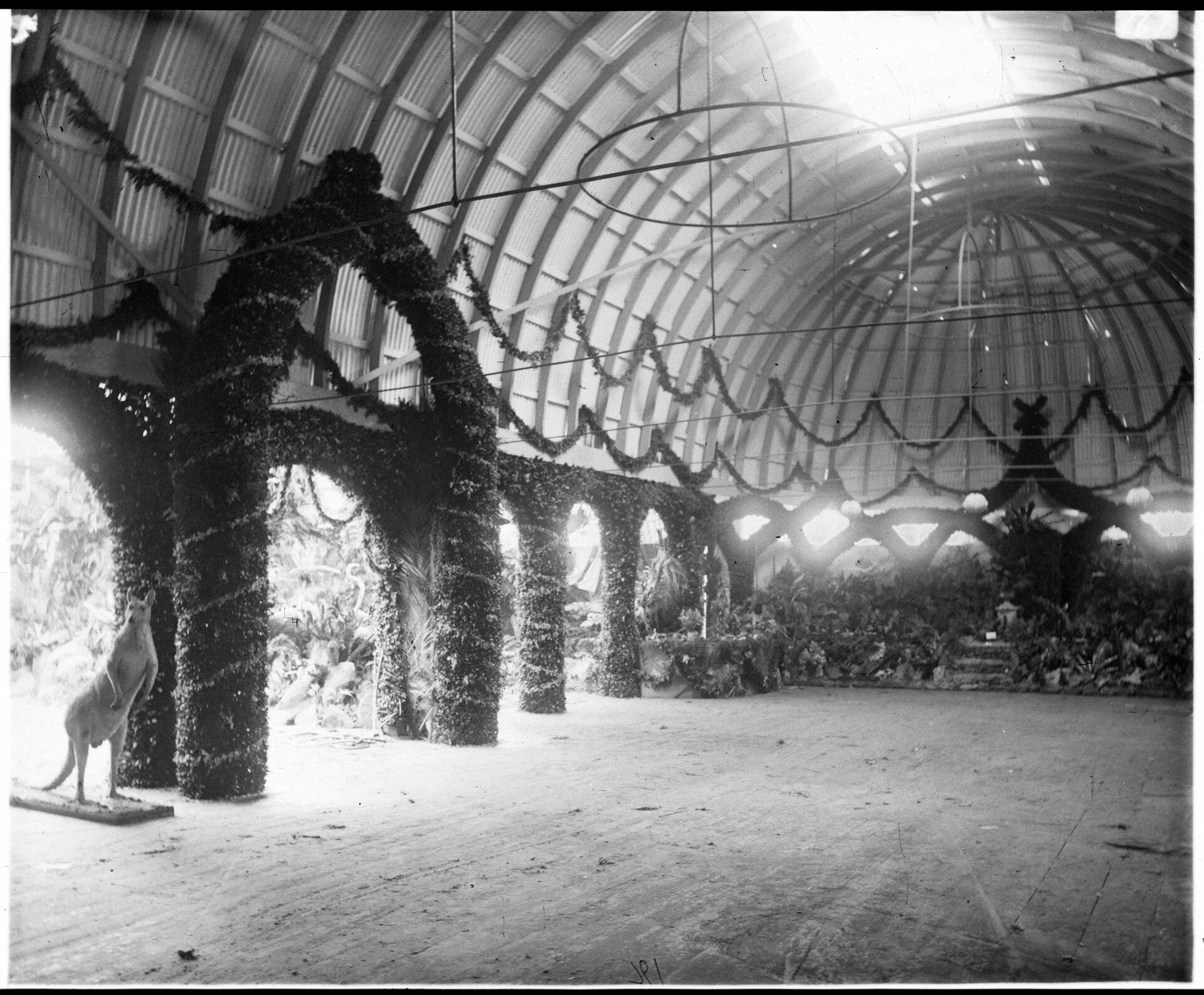
Manly Wildflower Show, date unknown. Photo: NSW State Records and Archives
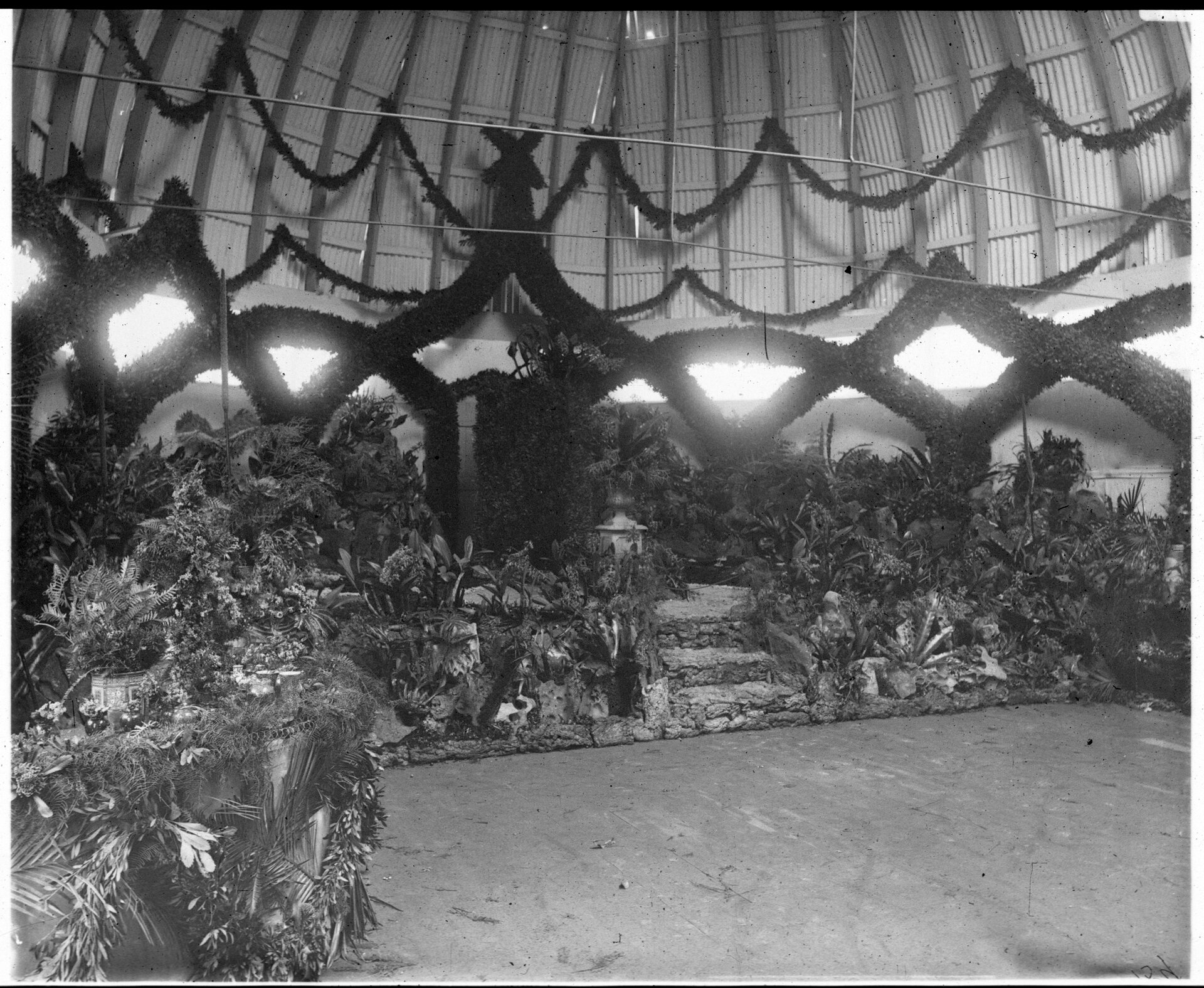
Manly Wildflower Show, date unknown. Photo: NSW State Records and Archives
THE MANLY FLOWER SHOW.
Somewhere about three years ago the Anglican congregation at Manly was short of funds. There is nothing extra-ordinary in such a fact, truth to say, it would be remarkable if there ever was or ever will be a church with all its pecuniary wants fully supplied. Many plans were discussed for raising money in any of the many elastic methods sanctioned by ecclesiastical usage, and when the bazzar, the raffle, the picnic, and other ideas had been discarded one after the other, a suggestion came in that fructified into the first wild flower show in the colony. Like that peculiarly blessed institution of Hospital Sundays, known to almost every English speaking community but our own, the Manly shows have developed into something far above and beyond what was originally anticipated. Instead of being now a mere local affair, it has attained a celebrity entirely dissociated from any creed or class, in short, it has become the fashion, and there is very little doubt that it will continue the fashion till the Manly people find their pavilion utterly inadequate to meet the requirements of the annual festival. It is only fair, perhaps, having said so much, to add the name of the suggestor. It is that of one of the most representative men in all Manly, one who has done as much, if not more than anyone else, in developing a quiet seaside nook into the Brighton of New South Wales - Mr C. H. Hayes, the mayor.
The Anglican people got not only the proceeds of the first show but of the second, the one held last year amounting altogether to about £700, a figure that they would probably have never dreamt of receiving at the inception of the affair. This year it was thought fit to give the Congregational Church a fair show, as it had a manse fund showing a yawning gap of £400 ; so it was resolved to wipe off this incubus, and to give the surplus to the 'park' recently acquired by the corporation wherein the pavilion stands, a rather primitive piece of land with everything wanting to be done that could justify the title already bestowed upon it.
Manly was looking at its best yesterday, and that is saying a good deal. The gentle rain of the previous day had laid the dust excellently, and had caused every green thing to blossom and spring forth abundantly. There was none of the languid heat of early summer, for a smart, fresh southerly breeze was sweeping across the harbour in a bracing, joyous manner, showing its effects plainly enough on the faces of the youth and beauty who went to see 'alf the fun of the fair'. It has often been hinted that the natural loveliness of the sand-girt peninsula is by no means confined to its inanimate flowers ; and possibly it would have been a hard task for any spectator at the pavilion yesterday to say whether the very animated native blossoms, costumed in all the glory of fashion, were more perfect than the wealth of floral beauty all around. It is hardly necessary to say that nobody in Manly was 'at home' yesterday ; all the 'society' such as there was of it appeared to have migrated with one consent and accord to the show early in the morning, for masculine digits could never have performed such marvellous devices in such exquisite taste as were exhibited in the stalls. Beside most of the stallholders were local ladies, and it has been a custom from times immemorial that every stallholder shall be glorified by the entire circle of her available acquaintances.
The Emu went down with a fair boat-load from Sydney at a quarter-past 10 a.m., and all the space on the Brighton was occupied an hour or so later on. The passengers by the latter boat were just in time to witness the opening ceremony, which was performed by Sir Alfred Stephen in the place of honour almost underneath the inevitable "Welcome to our Village" arch, at the eastern end of the building. Mr C. H. Hayes appropriately received the venerable Lieutenant Governor, and led off the proceedings by requesting him, on behalf of the ladies and gentlemen connected with the show, to formally declare it open.
Sir Alfred Stephen said that he need hardly say that he had the greatest pleasure in acceding to the request of declaring that admirable exhibition open. It had been the custom for some years to give Australians generally credit for exaggeration and boasting, and with the fact before him he should be careful to avoid anything like over-praise. But he could say that they had that day before them an exhibition full of all the attractiveness and bounty that could delight the senses - an exhibition of a kind that could hardly be surpassed in any part of the world. That opinion was pronounced in a London newspaper concerning the last show. For his part he knew of no employment so elevating as that of cultivating garden flowers and when one passed by a cottage, however humble it might be, in front of which were flowers cultivated and tended with loving care, it might to a great extent be assumed that that home was a happy one. He had not come there to make a long speech, but simply to express the pleasure he was feeling at being present. He was sure that the public were very much indebted to the ladies and gentlemen who had been good enough to give their time and energies to an exhibition of that kind, and of all the entertainments incidental to this gay season of the year there was none that surpassed in attractiveness, beauty, and refinement such a one as they now had the pleasure of attending. He himself was no gardener, but as a trustee of the Hyde Parks he had pleasure in announcing that it had been determined to set apart a plot of ground in one of the parks which should be sacred to wild flowers alone. He had much pleasure in declaring that grand exhibition open.
Three cheers were then given for Sir Alfred, and the ceremony concluded.
Immediately on entering the building - which, by the way, is approached by a small desert of black sand - is a pretty octagonal structure, which one of the lady stall-holders described as a pagoda, which takes up most of the space of the vestibule, the many windows of the pagoda forming so many counters for the retailing of various floral niceties. Overhead inside them are festoons of lilly pilly crossing from side to side and uniting in an evergreen wreath, in the centre of which the waratah roses were peeping out. Baskets of flowers hung all around, and inside and outside the pagoda were cabbage tree palms and ferns et hoc genus omne. The children of the Manly Public School have contributed a good many of the flowers in the pagoda, and Miss Bardsley, daughter of the schoolmaster, with Miss Hagon and Miss Ponton, have supervised matters generally there.
On entering the main building the first thing that strikes the eye is a large fountain, some ten feet high, adorned in the usual manner with lilies and rock ferns, arranged with a decided turn for effect. At the eastern end is the ever-green arch previously spoken of, with the floral inscription "Welcome to our Village," worked in native roses. At the rear and in the comer of the building is a very handsome fernery, arranged by Mr Yates, of the firm of Messrs Seattle and Sons, of the Central Markets. There is a rustic waterfall in the middle of the fernery, and the "gentle murmurs of the stream" plashing into the little lake beneath make up a charming picture. On either side of the fernery, and between the end of the building and the arch, are the two stalls presided over by Mrs Hardie (wife of the Mayor of Sydney), which, it is scarcely necessary to say, were tolerably thronged throughout the day. The arches over the stalls are of the ubiquitous gee bung, interspersed with waratahs and cabbage-tree palms, while the stalls present a number of tasteful devices in native roses, maiden-hair ferns, daphne wreaths, and so on. Adjoining is a stall belonging to Miss Barker and Miss Hawson, whereon the exhibits are of the same character.
On the opposite side of the building close to the entrance is the stall belonging to Mrs Olley, the wife of the pastor of the Congregational Church. Prominent among the attractions there are a splendid "crown" of rock lilies, a bouquet of native roses, a floral heart, cross, and lamp, the effect being exceedingly chaste and pretty. The supports are gay with cabbage palm flowers, and the favourite waratah is seen in every direction. A very unique design with cherry-tree leaves and native roses is also exhibited. The motto "The Earth is the Lord's" is worked over the stall in native roses amidst a wreath of foliage. The floor of the stall is covered with moss, and at the back and sides are mirrors to enhance the general effect. But, probably, one of the most perfect specimens of what feminine taste and ingenuity can accomplish with wild flowers is seen at this stall in the shape of a dainty bonnet, that would need a lady's praise to do it justice.
To the right at the entrance to the main building is Mrs C. H. Hayes' stall, a particularly well-arranged collection of floral beauty. There is a harp, cross, and anchor, representing faith, hope, and charity, and devised cunningly with rock lily and actrontus major. There is a magnificent lyre, with the now famous initials S. D. underneath, which should present a peculiarly agreeable appearance to Herr Vogrich. There were baskets of flowers, and bouquets and button-holes, in fact flowers in every shape and form, that were reflected in numerous mirrors, framed in waratahs.
Not far off this stall is Mrs T. Littlejohn's, the chief feature of which is a splendid parterre, arranged on the floor of the stall, the supports being covered with geebung leaves, ferns, and palms. There are leafy festoons running from one end of the stall to the other, and here and there the native dogrose shows its modest little blossom. The whole of the exhibits at this stall were characterised by exquisite taste.
The stall at which Miss Cunningham and Miss Mullins presided is not a very large, but a decidedly pretty one. Some designs in rustic ornamentation are well worthy a notice. There are bouquets from to bridal to the buttonhole, wreaths; and the supports are one mass of cabbage tree palms and waratahs. Mrs. Underwood and daughters occupy the next stall, where some dainty-looking floral and fern parasols are shown, the fringe of rock lilies being parliculatly effective, the summit being decorated with native roses and other flowers. There are also a couple of lovely crosses of rock lilies and maiden-hair fern, the chef d'oeuvre being the Prince of Wales feathers in an excellent combination of liyronica and the ordinary wild flowers. Portraits of the champion and the ex-champion sculler adorn the back of the stall. The style of general decoration exhibited at this stall is very rich and handsome. At the extreme right is a stall inscribed "Middle Harbour" owned by Miss McComb and Miss Fraser. There are numerous designs in bouquets, rock lilies, and other flowers, some artful combinations of cones and flowers made into little baskets while the ferns are lavished all around wherever there is room for them. In the middle of the building is a Japanese pagoda, errected by Mr Smedley, who has spent several years in Japan. The propriety of a pink and white covering at the top might appear questionable as contrasted with the absence of any colour around save that of the flowers, but at any rate, there can be no question as to the floral excellence of theo exhibit. Sir Alfred, in particular, was warm in his expressions of approval. At one end is a Japanese parquet laid out in a most curious manner with moss, a pretty arrangement of ferns forms a fringe. In the centre of the pagoda there is another profusion or confusion ot floral emblems and devices, sur mounted by a garden basket of peculiarly pretty design. At the end of the pagoda is a charming combination of looking-glass ferns and flowers, with a toy house at the rear, to represent a Japanese country seat - that is, supposing that a Swiss and a Japanese cottage are similar. Adjoining Mrs. Olley's stall is one at which Mrs Spear and Mrs Austin officiate. Like all the rest it has its special good point, that consisting in a miniature rockwork wherein are corals and shells in artistic disorder, fringed with maiden hair fern. Some of the baskets hanging from every available point look very tasteful. A harp, a star, and a Maltose cross look very nicely finished off, and for general effect there is plenty of geebung, cabbage-tree, palms, waratahs, while the native roses and boronias serve to add to the attractiveness.
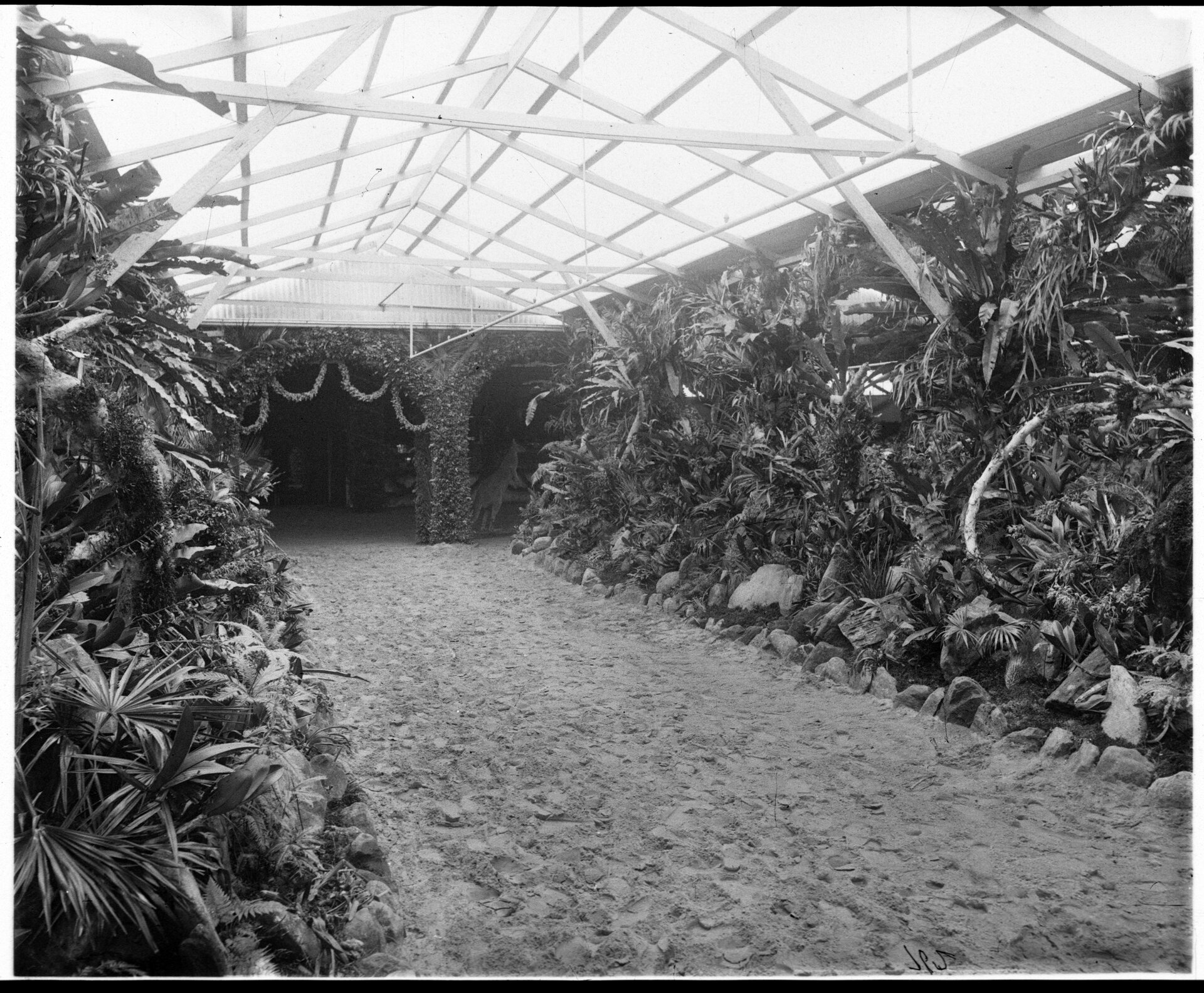
Manly Wildflower Show, date unknown. Photo: NSW State Records and Archives.
Another exhibit by Messrs Searl and Son, in the corner by the mantelpiece, deserves a word. The ferns, palms, and maiden-halr, rock lilies, with the orthodox fringing of waratahs, make a pleasant break in the line of stalls. Mr. Cyrus E Fuller, of the Stationers' Hall, who has lately been residing at Manly, has a stall close by the last-named exhibit. Mr Fuller, always looking far ahead, has appropriately shown a large and interesting variety of Christmas cards. It would be almost superfluous to say anything of their excellence, but some of the hand-painted gelatines are perfect gems of their kind. The proceeds from this stall go to the general object of the show.
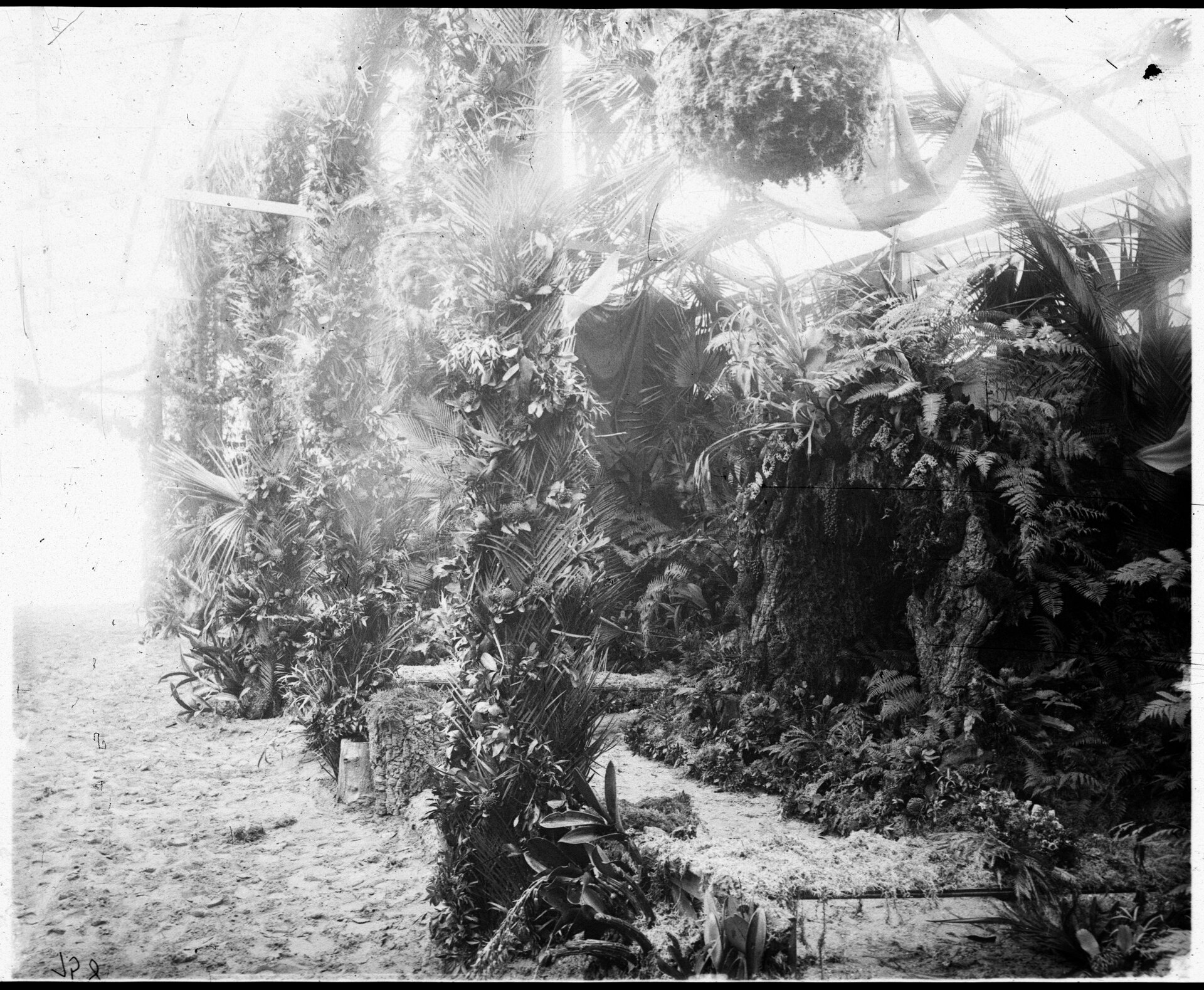
Manly Wildflower Show, date unknown. Photo: NSW State Records and Archives.
So far for the exhibits. Passing out of the main building, a room similar in size to the one containing the pagoda is reached, where there is another fernery with much rockwork in the usual style. The bank entrance door is at the end of the room, and not far off, in the open air, and stood the German band, who played all day yesterday, their programme being : - Boocaccio march, Silver Rhine, waltz, Martin's selection, Pirates of Penzance Lancers ; duet, Bohemian Girl ; Blue Danube waltz, Heart's Delight schottische ; selection, La Favourite ; selection from Maritana, Dream Faces valse.
Not far off was the inevitable Quong Tart pavilion, which one now looks to find at every affair of this kind. There was a considerable run on tea and muffins yesterday, for the place was fitted up to give ample sitting room to all comers. Mr Tart's pavilion was, of course, decorated inside in strictly Celestial fashion, even to his own name, in scribed in Chinese hieroglyphics at the end of the place on a kind of shield, underneath which were mirrors and drapery of the various unobtrusive colours peculiar to Chinese ornamentation. In the centre of the pavilion was an abnormal fountain, the sides Icing built up in pagoda fashion of gilded carvings, with woodwork in all the most brilliant possible hues. Mr Tart said that it had been impossible to get Europeans to make this wonderfully elaborate structure, and the Chinese workmen had been employed on it for several months past.
The financial outlook of the show, as far as the Congregational Church is concerned, is so far most encouraging. Yesterday £120 was taken at the gate, and in addition must of course be reckoned the gains made inside. To-day the show will open at noon, and will close at 6. as there is no boat back between 6.30 and 10. On Saturday, the last day, the show will be kept open till 9 o'clock, when it is extremely probable that, judging by the present rate of progress, the required debt will be twice provided for. THE MANLY FLOWER SHOW. (1884, September 12). The Sydney Morning Herald (NSW : 1842 - 1954), p. 5. Retrieved from http://nla.gov.au/nla.news-article13565454
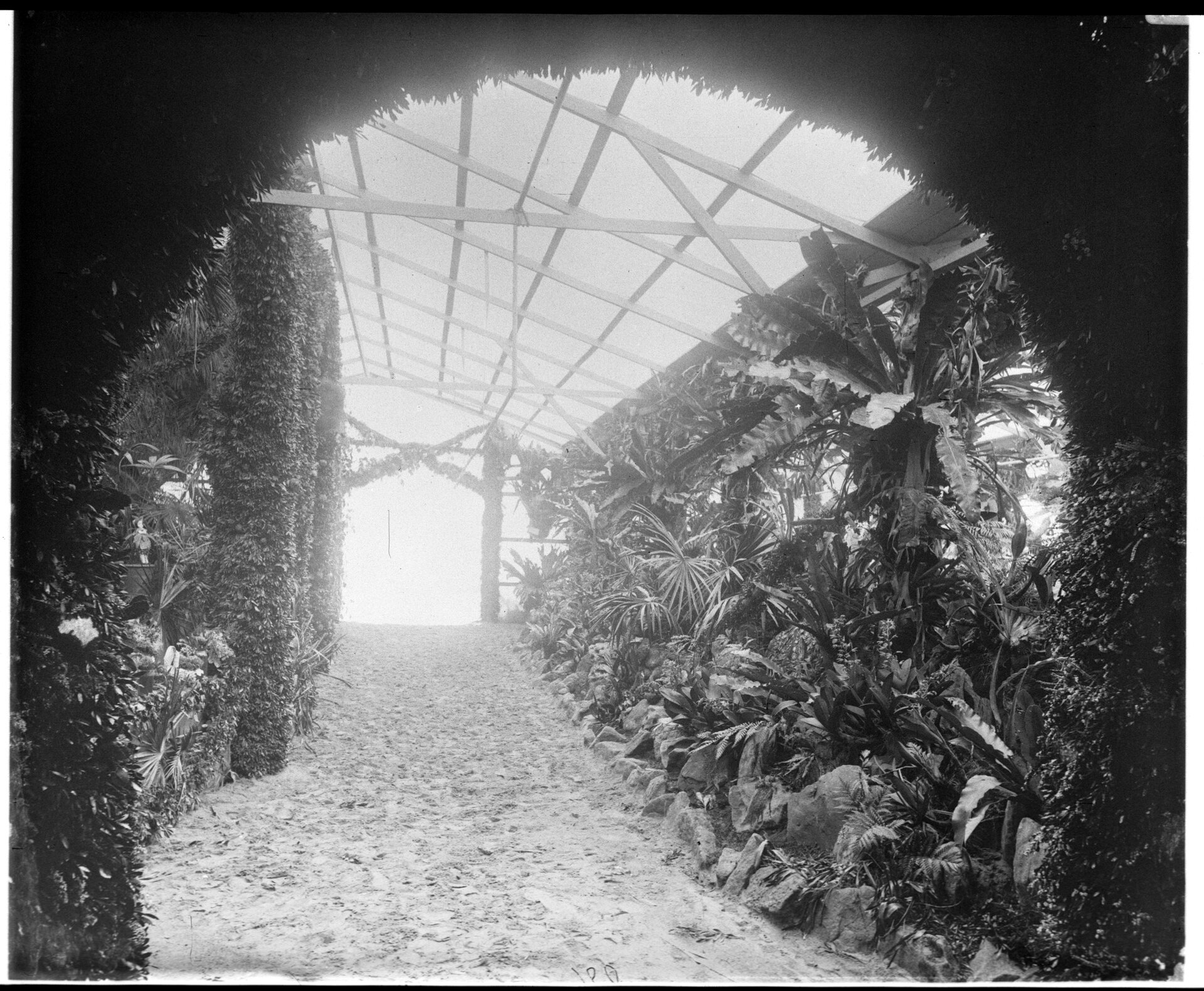
Manly Wildflower Show, date unknown. Photo: NSW State Records and Archives
As the popularity of the Manly Wild Flower Show increased, so did the scale of the displays and the amount of flowers being ripped from the bush to be put into the displays. The possibility of plants being made extinct thereby began to be realised and caused some to speak out about this:
MANLY WILD-FLOWER SHOW.
Preparations on an unprecedented scale are being made for the Manly Wild-flower Show, to be opened on September 10. Stimulated by the success of previous years, the executive committee has spared no expense in making preparations — erecting stalls .and providing additional space by adding an annex to the pavilion, putting the park in order, &c. The committee seconded in their efforts by the Manly Council having carried out several important works which will tend to make Manly all the more attractive on the occasion of the show. Wild flowers in the district are said to backward this season, but should the weather continue favorable til the show, and for the show, a splendid, collection will be obtained, and the show will be an exhibition on a scale never before witnessed in the colonies. Lord Augustus Loftus has signified his willingness to perform the opening ceremony should his engagements permit, but in the event of his inability to be Present, the Hon. W. B. Dalley will be asked to do the. honors. Bishop Barry has also promised to be present at the opening. MANLY WILD-FLOWER SHOW. (1885, August 31). The Daily Telegraph (Sydney, NSW : 1883 - 1930), p. 5. Retrieved , from http://nla.gov.au/nla.news-article237252955
WILD FLOWER SHOWS.
THE MANLY FLOWER SHOW.
The wild-flower show at Manly, which was opened on Thursday, the 10th instant, by his Excellency the Lieutenant-Governor, in the presence of a large assemblage, was closed on Saturday evening. The attendance during the first three days of this aesthetic exhibition amounted to upwards of 8800 souls ; but there was a marked falling-off, which was only to be expected, after the novelty of the show, and in some degree the freshness of the flowers, had passed away.
Still the pavilion at Manly was daily visited by hundreds of interested, or perhaps it might be more properly said, charmed spectators, upwards of 600 visiting it on Saturday. It would only have been natural to expect that the flowers would lose their freshness, and the leaves their gloss and crispness, confined for upwards of a week in a building ; but the marvellous freshness of plants and flowers was a matter of general observation and surprise on Saturday, and it must have been exceedingly gratifying to the management to be able to provide such "good wine" at the end of the feast. Fresh charms seemed to disclose themselves at every turning, and all the more noteworthy features of the exhibition- the bank of flowers, the oriental arches, the miniature lakes, the -grottoes, &c.,-as well as the minor but not less beautiful objects, were the delight of the spectators.
Kuster's band performed choice selections during the afternoon and evening, the exhibition closing at 10 o'clock. The attendance from the opening of the show until 9 o'clock on Saturday night numbered 10,673, but this number was slightly exceeded before the closing hour. The gross proceeds amount to about £1600 from all sources, and it is anticipated that after paying expenses there will be a balance in hand of about £1000, half of which will be devoted to the Manly Park, and the other half towards the extinguishment of the debt on the Church of England at "Our Village." A number of flowers from the pavilion have been forwarded to the different hospitals in Sydney. WILD FLOWER SHOWS. THE MANLY FLOWER SHOW. (1885, September 21). The Sydney Morning Herald (NSW : 1842 - 1954), p. 5. Retrieved from http://nla.gov.au/nla.news-article28363938
NATIVE FLOWER SHOWS
No one who knows Mr. Morris will for a moment doubt that the wanton destruction of wild flowering plants is as distressing to him as to any other lover of natural beauty, and it cannot be denied that, as he asserts, the 'cutting' up' and' utilisation of land is a very large factor' in the disappearance of the indigenous 'flora, or that the boys (aye, little girls, and men and 'women,- too) who. swarm out of Sydney into the country on the afternoons, of Saturdays and on Sundays are answerable for a huge amount of destruction through the tearing- up of plants by the roots ; but it would almost seem that, on the whole, bush fires do little more than a temporary injury to Australian plants; which since the advent of the black man, if not before, have-become accustomed' to such visitations, and have probably learned, in their extremity to withdraw their vital forces into their roots; from which they, spring up after the first rain with renewed, and often increased vitality.
lt is, a well-known fact that the seeds of acacias, and some other plants, seldom' germinate until released by a bush fire from the hard case which envelopes them.
The advent of the white man and the birth of larrikinism are events comparatively so recent that the plants have not yet been able to accommodate themselves to treatment to. which the ancient aboriginal inhabitants, who were true botanists, never dreamt of subjecting them.
I can well believe that Mr. Morris and his friends endeavour in gathering flowers, to do as little mischief as possible; but, considering the immense ' mass of flowers and foliage which it is necessary to collect for such a grand display as that last made at Manly, it is impossible to arrange that only judicious collectors should be employed.
On the occasion of one exhibition a botanical friend, who refrained conscientiously from visiting the interior, estimated that the'debris' thrown out, consisting principally of the roots-and branches of plants torn up and brought whole to the building for the more convenient removal of the flowers, amounted to a ton weight.
I assert that although our hardwooded native plants may entirely recover from a little judicious gathering of their flowers, yet when the process is applied extensively or year after year, they not only never recover their beauty, but almost invariably perish.
On one Sunday during the present month, a gentleman residing on the Parramatta River surprised some young men in the very act of clearing off with a boatload of rock-lilies in full bloom, removed from his garden, where they had been planted and carefully protected for at least 20 years. He was, fortunately, able to seize the boat and rescue his damaged plants, for the sneaking scoundrels, although five to one, were too cowardly to resist the man whom they were quite brave enough te rob behind his back. This mean theft, though certainly not authorised by the promoters cf the Manly Flower Show, was attempted for the purpose of offering the plants to them for sale.
We learn from the letter of Mr. William Freeman that it has been found necessary for the prevention of interference with the flowers and foliage of the National Park, to engage extra assistance of resolute men for each Sunday during the past month, and to affix placards at numerous places, warning persons against removal of, or injury to, trees, plants, flowers, &c growing thereon.
With the view of preserving a portion of the beauty of the waratahs growing in the gullies at my country residence, I have sacrificed the remainder by mutilating every flower so as to make it worthless for sale, but even that is not sufficient, and barefaced spoliation still goes on merrily.
I was lately promised a white specimen which bloomed near the valley among many others which the owner was carefully protecting, but some scamps took advantage of his absence and cleared off every flower, and though three or four years have elapsed the plant has not yet produced another flower. Something of the same kind happened in case of another white specimen which flowered nearly 10 years ago near Appin. Four years ago, a specimen with white bracts was inadvertently gathered on my own ground, and though carefully sought for every year has not yet produced another flower.
The beautiful Lycopodium arboreum, the staghorn and bird's-nest ferns, and the rock-lily, have been pretty well eradicated near Manly, and are being fast exterminated on the mountains, where that superb flower, Blandfordia Cunninghami, with its waxy orange and lemon bells, has almost disappeared also. The native rose has disappeared from South Head, and almost from the neighbourhood of Manly. Since the exhibitions have been going on, it has been a common thing to see ladies carrying home bunches consisting of perhaps a thousand flowers, their beauty being entirely destroyed by the tasteless method of packing them closely together so as to resemble a red cauliflower, the leaves of the latter being represented by fronds of the umbrella fern (Gleichenia).
The pristine beauty of the Christmas-bush has entirely disappeared from the neighbourhood of Sydney, being not allowed to bloom even in gardens ; and it is to be feared that the magnificent specimens near Faulconbridge, with their large blood-red perfect flowers, will shortly disappear also.
My object in writing at all on this subject was not to discourage flower-shows, but to advocate their regu-lation, in order to make them permanently useful as well as a temporary enjoyment, and to advocate the taking of all possible precautions for preventing such van-dalism and destruction as I have mentioned, and which these exhibitions undoubtedly encourage, notwithstanding all the care which their promoters may take.
It is impossible for persons robbed of their plants to protect themselves, for the almost universal sympathy with offenders when prosecuted, after Mrs. Glasse has caught them, almost invariably prevents the infliction of more than a nominal punishment ; but if in unfortunate owner ventures to take the law into his own hands he gets neither sympathy nor mercy. It is stated that in a late case strenuous efforts were made to induce the institution of criminal proceedings against a sufferer, whose gardener, with the view of terrifying a lot of Christmas thieves, fired, a shot-gun in the direction where, they, were carrying on their wanton depredations. If one of the vagabonds had died of fright, the gardener would have run considerable risk of being found guilty of murder.
With the kind permission of the Sydney Morning Herald, I propose shortly to furnish a list of wild flowers suitable for pot culture, and as this will no doubt be supplemented by gardeners and botanists, I have some present hope that a more healthy system than the present will be initiated by my good friends at Manly, to whom is due the honour of originating what has given so much pleasure to the careworn dusty citizens of Sydney.
JAMES NORTON.
NATIVE FLOWER SHOWS. (1885, September 28). The Sydney Morning Herald (NSW : 1842 - 1954), p. 5. Retrieved from http://nla.gov.au/nla.news-article28364156
Another, a local, speaking up for the bush:
TO THE EDITOR. OF THE HERALD.
Sir,-I read with a great deal of satisfaction the letter in your columns from Mr. James Norton, in which he directs attention to the wholesale and increasing destruction of our native plants and flowers through the medium of these shows. I deplore with him the rapid extirpation of our beautiful wild flowers, ferns, and indigenous plants in the districts adjacent to Sydney, and think that the show craze is assuming such proportions that it should be restrained. The floral wealth of our bush is disappear-ing rapidly enough in other ways without the extravagant appropriation that is made from it every year for these displays. We have not merely to consider the flowers and plants taken away, but it is the quantity, ruth-lessly destroyed by the collectors, who care not what damage they do provided they can make up their dray loads. I have had experience of this on my property at Lake Narrabeen, which I purposely purchased to preserve the beautiful cabbage-trees, ferns, and lilly-pilly trees upon it ; and much as I admire tho object for which the exhibi-tions are held, I cannot refrain from expressing the opinion that they are doing a deal of harm in the direction pointed out by Mr. Norton. The interval between the shows is far too short, and the contributions levied upon our native plants far too exacting. ln a short time the beauty of the bush and gullies around Sydney and Pittwater, so much appreciated by strangers for their profuse adornment of native flowers and ferns, will be gone, and I think it behoves those profess a love for our indigenous plants to see that the present wanton destruction is stayed.
The mischief is rapidly growing; the example set by Manly Beach is being followed by others, and this month we are having the bush and the gullies ransacked in every direction to supply the shows at North Shore and Kogarah, in addition to the one at Manly.
I hope Mr. Norton's protest will have the effect of directing the attention of the promoters of these exhibitions to the injury they are, I believe unwittingly, doing to the beauty spots around their own and other localities near Sydney.
OBED WEST.
Barcom Glen.
TO THE EDITOR OF THE HERALD. (1885, September 28). The Sydney Morning Herald (NSW : 1842 - 1954), p. 5. Retrieved from http://nla.gov.au/nla.news-article28364152
This persisted the following year, with even the local press weighing in with suggestions of preservation of the huge amounts of flowers being ripped out, by their roots, from the local bush:
MANLY.
The fifth annual exhibition of the wild flowers of the colony was opened at Manly on Wednesday, the 8th instant, in the presence of a large assemblage. Among those who attended were the Primate, Sir Henry Parkes, the Right Hon. W. B. Dalley,the Mayor of Sydney and Miss Young, and Captain Gascoigne. Punctually at the time appointed, his Excellency, accompanied by Lady Carrington and suite, arrived. Lord Carrington declared the exhibition open, and cheers. were given for the Queen, Lady Carrington, and the Mayor of Manly.
Miss Austin then presented to Lady Carrington a beautiful bouquet of wild flowers, which her Ladyship examined with interested curiosity, and she asked the names of the blossoms composing the bouquet. The vice-regal party was conducted by the Mayor through the pavilion, and showed considerable surprise and admiration at the floral wealth developed ''on the land of the songless bird and the scentless flower."
That the distinguished visitors should have been astonished by the display is not at all to be wondered at. The choicest treasures of the forest were disposed before them. Hill, gully, and flat had been rifled and robbed to add to the beauty and attractiveness of the show. With an utter disregard of the claims of posterity to the floral beauties of our land, sacrilegious hands had been laid on the forest flowers and. root and branch, bud and blossom.
The stately, gigantic lily, the blood-red waratah, the modest native rose, rock lilies, boronia, Star of Bethlehem, Aaron's rod,-Christmas bush, and many , other less-familiar wild flowors were displayed; in rich profusion. . Eight stalls, variously designed as .grottos, alcoves, bower, and archways were composed entirely of flowers and leaves, supported by a wooden framework. In a charmingly contrived alcove Mrs. Hayes had placed a tribute of loyalty. A portrait of the Queen as issued with the Christmas number of the TOWN AND COUNTRY JOURNAL was set in an oval framework of geebung loaves, with a border of pins: heather and fringe of cabbage-tree blossom.
Above was a crown of native roses, boronia, and colored heather, and at either side - were the royal arms. Surmounting tho whole was the motto in flowers, "Neither sea nor land can separate us." In the right corner was a harp and in the opposite corner a lyre, both ornamented with flowers and fringed with cahbage-tree and creepers. Fern and cabbage-tree fronds, with lily-pillvs, native roses, and heather, were tastefully displayed, and the appearance of the alcove was charming.
Mrs. Willis had two beautifully decorated bowers, in which was presented a. choice collection of flowers ; and Mrs. Pitt had a stall and grotto. The latter was a feature of the show. Opposite,, Mrs. Pitt exhibited a splendid assortment of native flowers, and to heighten the beauty of the collection art was called in to the assistance of nature, and devices, as stars, maltese crosses, wreaths; and streamers was shown. The most noticeable in this collection was a beautiful display of native lavender.
Passing through the fernery, where almost every description of fern, from the delicate dainty maiden hair to the imposing tree fern and palm-like cabbage frond, was on view, the stall presided over by Mrs. Woods was reached. Here a very fine display of woodland flowers had been placed. Above and surmounting the archway was the motto, " Cead Mide- Failthe"-a hundred thousand welcomes. Opposite was the stall occupied by Mrs. Dean's collection ; and the intervening space was utilised by Misses Woods and Dean, who presided over one of the most tastefully arranged stalls in the collection, rich in beauties of the forest, the gully, and the mountain side. Mrs. Smedley had what may be termed, inaptly perhaps, a rustic stall, where the spoils of the bush were displayed in almost endless variety. MANLY. (1886, September 11). Australian Town and Country Journal (Sydney, NSW : 1870 - 1919), p. 15. Retrieved from http://nla.gov.au/nla.news-article71067483
Another from the same year:
The Manly Wild-Flower Show
It is pleasant to observe that the aldermen of Manly have adopted the system of having a permanent bushhouse structure, in which all the epiphytal wonders of our bush find a genial home. The only fault we have to find is that the structure is too small and too low in height. We expected, when we heard that such a building was to be erected, that it would be more consonant with the surroundings. To be such, its height ought to have been double its present extent, and more capacious in other details, and in which not only should ferns, rock lilies, and staghom ferns find a home, but by having an additional height goodly specimens of palms might therein be planted. As it is, it is a step in the right direction, and by the manner in which the interior is laid out with rockeries and stumperies, well-laden with the above plants, it presented at the period of our visit a very pleasing appearance. We hope, however, to see the structure extended as we have suggested, as by doing so the councillors at Manly will be setting a good example for other municipalities.
The handsome green arches in the annexes of this bushhouse were certainly very picturesque, as, while the greenery and the geebung bushes were plentifully laden with flowers of our wonderful telopea, the delicate creamy flower pedestals of palms were brought into use, and thereby created a very pleasant effect. This mixture of deep-green, brilliant scarlet, and creamy-white, had a fairy-like appearance, and formed a fitting introduction to the alcoves, fitted up by the patriots of Manly for the display and sale of native flowers. Very pretty, indeed, and, we suppose, very expensive also, must have been the large space fitted up and occupied by Mrs. Alexander Dean.
Banks of wild flowers, having a fair imitation of such in the native state, formed attractive features in the affair. Miniature rocks of timeworn appearance were so arranged as to recall scenes of long ago, that were observable around the harbour. The goodly -sized plant of the albino variety of Boronia serrulata made one wish that it could be as easily propagated here as in the mother country. Unfortunately, however, our native flora does not appear to agree with to the operation of the propagator, and therefore we must be content to dull and grow with what success we may these albinas when found growing in their native state. Whether or not the pale varietv of Boronia pinnata is distinct, or whether the habitat in which it is grown brings about this paleness, we are hot prepared to state ; but as a variation from the original type it was pleasing in its diversity.
To enumerate all the wild flowers exhibited would entail a long list of names ; suffice it to say that the two above-named boronias. and their varieties, the native fuchsia or Epacris grandiflora, conospermums, the pultonias, diwillwynias, and telopeas, form, for their variation, the principal items. In Mr. John Wood's alcove a similar condition of affairs presented themselves, with the addition of representatives of our celebrated kangaroo and emu. In Mr. Austin's stall, the fittings up were also of a very similar character, but rather more artificial, owing to the introduction of Royal portraiture.
Might we suggest to the Manly authorities that, having a goodly surplus over from the event, a certain portion of the park should be laid out as a wild flower garden; and as the soil is eminently suited for the growth of such plants, we might predict a great success. There would be little trouble in obtaining, plants, and as the ground consists of soil perfectly similar to that in which they grow wild, the Manly wild flower garden would become quite as famous as is the annual wild flower exhibition.
A great deal of trouble must have been expended in the getting up of the exhibition ; and we are pleased to notice that the professional assistance of Mr. Paul Lairing has been fully recognised by the press. The Manly Wild-Flower Show. (1886, September 18). The Sydney Mail and New South Wales Advertiser (NSW : 1871 - 1912), p. 594. Retrieved from http://nla.gov.au/nla.news-article164381379
By 1887 the objections to the wholesale razing of the bush had grown. The Government of the day was called to step up and step in - while this report records that the lands at Manly that were once profuse with so many varieties of local flowers were now barren - just a few years later, and they had to take the mases required from that still left on privately owned land:
THE MANLY WILD FLOWER SHOW
The annual show of wild flowers at Manly, which has become quite an institution at that favourite marine suburb, will commence to-morrow, and judging from present appearances it promises to be quite as successful as if not more so, than any of those which have preceded it.
This will be the sixth show of the kind, and notwithstanding some difficulties which appeared to beset the exhibition of this year at the outset, there is no reason to believe there will be any falling-off in the display either in the quantity of flowers for sale or in the general attractiveness of the whole.
The difficulty referred to, and which for a time at least threatened to interfere with the success of this year's exhibition, was an outcry to the effect that the flowers were not cut off as they should be, but were torn up at the roots, so interfering with the beauty of those places from which they were taken. Hence the Government were called upon not to permit this year the " desecration of the ground from which in years past the flowers were usually gathered. But as a matter of fact the whole of the flowers on Government lands at Manly and its neighbourhood have disappeared-not through any action on the part of past flower gatherers for the show, but simply because they have been completely rooted up by the " unemployed."
Therefore all the Government lands are closed to the committee-not for fear of any wilful destruction of the plants, but simply because they are now completely barren.
Thus the attention of those who have this show at heart, have this year been completely turned to private land, over much of which permission has been given by the owners to pick flowers, and, as before remarked, the result will be fully equal to former years, for they have been, and are being obtained in abundance, so that there is no fear whatever of any dearth in this direction.
As usual, the show will take place at the pavilion, near Ivanhoe Park, and this is very considerably enlarged by the fernery and annexe at the rear. The pavilion itself is being most artistically and elaborately decorated with ferns and evergreens of various kinds, some of the designs being beautiful in the extreme.
There will be four stalls in this part of the show, but it would be unfair to anticipate any future description beyond saying that they will certainly vie with anything of the kind ever seen in these colonies. One feature of this port of the show will be the model of an aboriginal encampment with gunyahs. natives, &c. and with a winding stream running through the centre, at which gold-diggers will be seen at work. Another pleasing feature of the pavilion will be a fountain, which will do much towards cooling what might otherwise be a somewhat heated atmosphere, especially in the evening, when the place will be aglow with gas.
In the annexe there will be six stalls for the sale of flowers, and the floral decorations of most of three are beyond all praise. As usual, the fernery between the pavilion and the annexe will form a cool and pleasing retreat, where almost every kind of wild flora will be met with in abundance, displayed to the best advantage. These shows were begun by long ago as 1881, and, with the exception of one year, have been held annually ever since.
At the very start a principle was laid down with regard to the distribution of the funds obtained, and it has been undeviatingly adhered to. Half the net receipts have gone towards the improvement of the local park, the other half to one of the religious denominations of Manly. Last year it was in aid of the Presbyterian Church building fund, and on that occasion the not receipts were £1000, so that the funds in question benefited to the extent of £600.
This year the moiety is to go to the Catholic Church funds, and when the Wesleyans have in their turn been served, a commencement will have to be made de novo-if in aid of the churches, as all the religious places of worship at Manly will then have participated in the proceeds of these shows.
Mr. C. R. Austin, Mayor of Manly, has for the third year the entire management of affairs, the shows being, as it were, vested in the Mayor for the time being and this is Mr. Austin's third year of office. It is expected that every thing will be in perfect order by the opening hour to-morrow, and as usual the show will last four days. Among other pleasant features that will be provided will be the band of the First Regiment, which will daily perform selections of popular music ; so that taken altogether, this year's wild flower show at Manly is likely to be the reigning attraction of the week. THE MANLY WILD FLOWER SHOW. (1887, September 27). The Sydney Morning Herald (NSW : 1842 - 1954), p. 8. Retrieved from http://nla.gov.au/nla.news-article13652774
MANLY.
Great preparations are being made for the Manly wild flower show, which is to be opened by Lord and Lady Carrington on September 28. A number of men are at work at the pavilion getting the stalls and decorations ready. The committee have invited all the leading public men of Sydney to the opening. The crews of men of warships in the harbor, at the time of opening, are also to be invited. ' The park and grounds are to be lighted with prismatic lamps during the nights of the show.' Mr. Pain will have charge of the illuminations. Mr. Quong Tart has charge of the refreshment stalls, and everything in connection with the show promises to be a great success.
Yesterday morning the Manly Aquarium was discovered to be on fire; but before the flames got a good hold of the building they were extinguished by the men employed at the place. The fire was caused by sparks from the engine falling on the roof of the fernery. The damage done was Very small.
The Manly local minstrels gave an entertainment in' the Oddfellows Hall on Wednesday night. Professor Anderson has also been entertaining the Manly folks with some of his wonderful performances. MANLY (1887, September 16). Evening News (Sydney, NSW : 1869 - 1931), p. 3. Retrieved from http://nla.gov.au/nla.news-article108010123
.jpg?timestamp=1725761908942)
.jpg?timestamp=1725761934640)
.jpg?timestamp=1725761973269)
The Manly Wild Flower Show
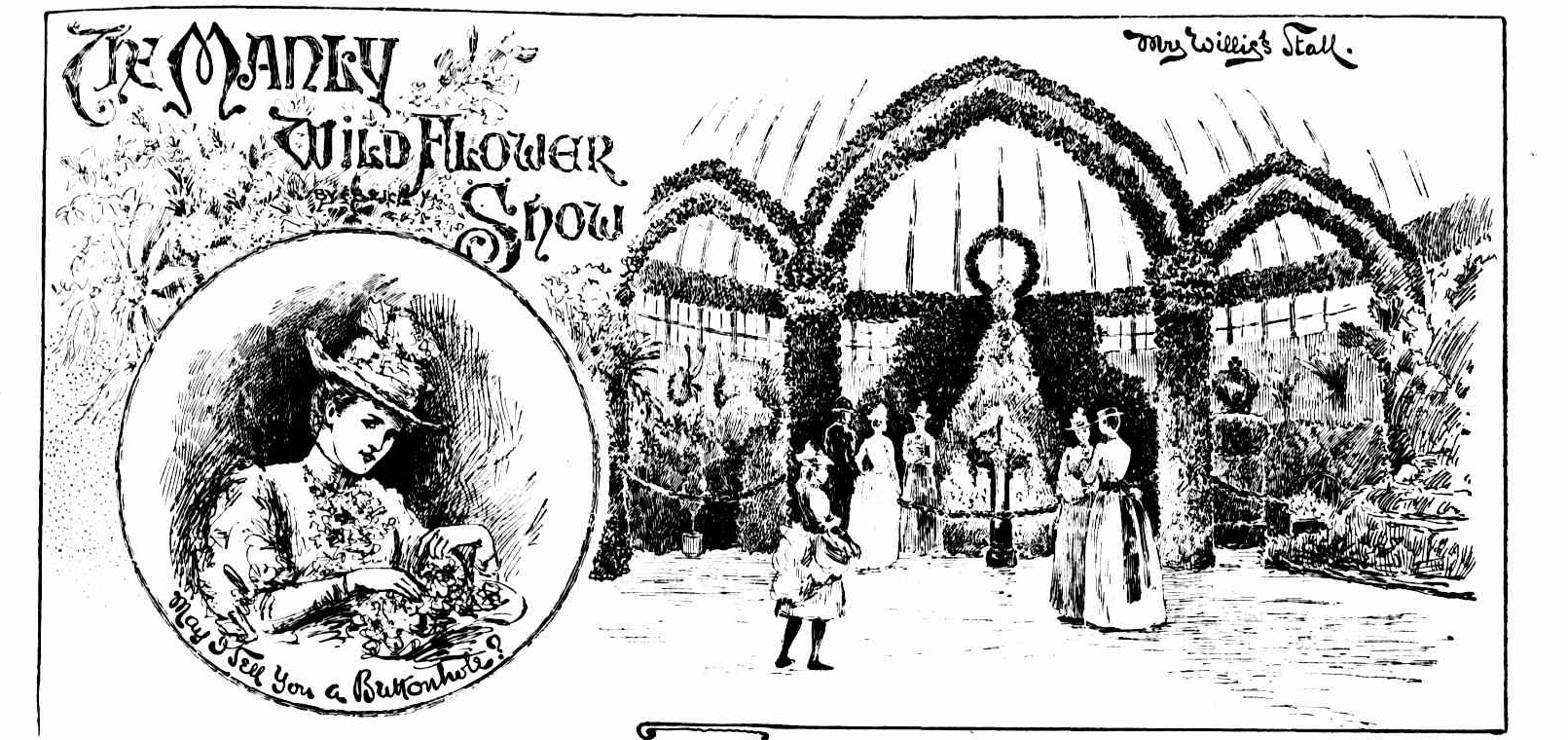
The show of wild flowers lately held at the pretty little watering place of Manly was a thing to be remembered as a gathering of the beautiful both in nature and art. It must be that all kinds of loveliness possess affinity, for that quality could not be attributed to the flowers alone ; the eye of the visitor straying frequently to the fair faces and figures that passed him, decked in robes which were sufficient to cause a Greek goddess to forswear her nudity.
Rich glowing colour was everywhere; in the clusters of Waratahs which graced the greenery of decoration pillars, in the dress materials which flitted between the fern fronds of the rockery, in the giant lilies which towered above their fellows, and in the features of the flower sellers as they charmed victims to their doom, forcing them to disgorge whatever they had about them, and decorating them for the sacrifice in countless bouquets. The band of the 1st. Regiment was in attendance in the grounds, and above the hum of many voices rose the sound of music softened by distance, inducing a soothing effect upon the male portion of the visitors, which lulled them into a false sense of security from which they awoke but to find that the combined attractions of flowers and faces had stripped them of their wealth.
On entering the pavilion, the exterior of which somewhat resembles the Mormon Tabernacle at Utah, one found oneself in a building decked to the roof in flowers and ferns, whilst in front a wing extended where rock lilies gleamed amongst a wealth of native foliage. To the right and at one end of the main building the principal feature was a stall presided over by Mrs. Willis, assisted by Mesdames Ger-man and Ridge, and the Misses Hamilton, Biddulph, Lovegrove, Drake, Wilson, Deuchar, M'Kenzie, Shaw, Wadsworth, Thomson, Willis, and Hawkes.
This arbour of beauty was separated from the public by three splendid arches com-posed of lilly-pilly leaves and berries, faced with clusters and columns of waratahs and pink heather. The interior radiant with masses of yellow and white rock lilies, native roses, boronia, heaths and cabbage-tree palms, arranged in a most artistic manner.
Opposite to it a stall of some-what similar proportions and style was presided over by Mrs. A. Morris and Miss Miller, assisted by the Misses Gore, Docker, Morse, and Hoskings. The principal feature here was a bank of flowers at the back, capped with a plume of feathers of rock lilies resting upon a background of zannias, whilst a pyramid of blossoms, topped with a fountain, occupied the centre.
To the right and left of the entrance were two exquisitely decorated stalls, presided over respectively by Mrs. Smedley, assisted by Mrs. Watson, the Misses Russell, Campbell, Jenner, Watson, Grafton, Scarr (2), Lyne (2), Kirkby, and by Mrs. Ritchie, who has for her assistants Mesdames Farmer, Garde, and Harris, and the Misses Orr, Richards (2), Montague, Hoskings, Russell, and "Watson. Both of these stalls were perfect bowers of blossom and fern, reflecting the greatest credit upon the taste of the proprietors ; indeed, the labour which the arrangements must have entailed throughout speak volumes as to the indefati-gable qualities of the so-called 'weaker' sex.
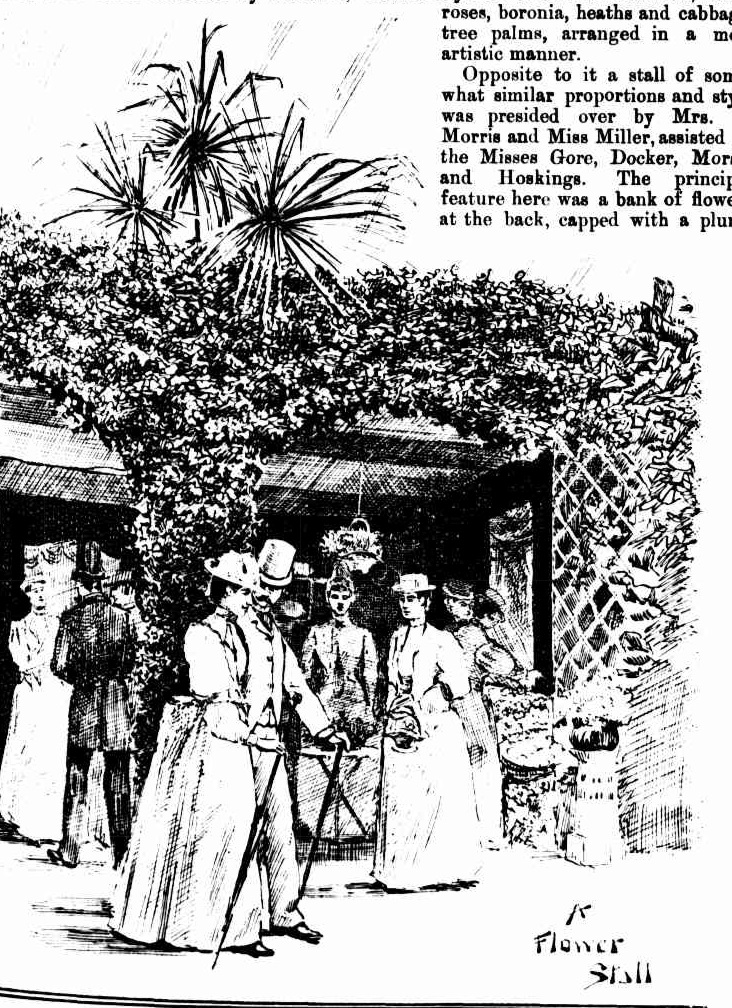
Passing into the fernery, under arches of mosses, lilies, and greenery, beautiful in design-the work of Mrs. Townsend-one passed on to 'Fernholm,' where Mrs. Chamberlain and the Misses Pym, aided by the Misses Gibbes, Wilshire, and Stevens, reign supreme. Here was a bush scene of a swagman camped out, apparently undisturbed by a phenomenal fall of gigantic leaves, any one of which, striking him, would be calculated to do him grievous bodily harm. The idea was exceedingly novel and interesting, and was carried out, as far as possible, with due regard to detail.
At the next stall Mrs. C. R. Austen and Mrs. T. C. Haylock presided, assisted by Mrs. Craven, the Misses Craven, Ada Austen, Lillie Austen, Robinson, Hack (2), Eastwood, Morgan-Williams, Haylock, Hensley, B. Kilminster, and E. Kilminster. Everyone has experienced the effects of the craze for wall decorations, consist-ing of embellished gin bottles, frying-pans, rolling pins, etc., but here we come upon the Ultima Thule of this eccentric taste, a severe parody on the society and fads of the day, in the shape of a hand-painted boot of antique structure, now turned into a flower vase. There is more pathos, however, about an old boot than an empty liquor flask. It was once a sturdy, matter-of-fact sort of foot covering ; now, with its painted toe, and gaudy pink silk lace, with flowers and ferns waving above it, there was something of a want of reverence about its look, against which the yawning holes gave feeble protest. Underneath this exhibit were printed on a card the following words :
By dainty foot I have been worn
O'er hill, or vale, at eve, at morn,
In mazy dance, at banquet hall,
Now finding rest on flower stall.Tho' old and worn, yet you will find
Art and beauty in me combined,
Transpos'd by chance from mud or snow,
To grace a Manly Flower Show.
A distinguished personage who was present suggested the change
Transpos'd perchance by many a toe.
At a stall adjoining Mesdames Haylock and Austen's display is one presided over by Mrs. Bow, assisted by the Misses Eox (2), Shorter, Ahronson (2), Graham, Bow, and other ladies. The stall is exceedingly prettily arranged, with the words ' Consider the Lilies ' worked in flowers upon a crimson ground. Besides the stalls a refreshment tent is conducted by Mesdames Tibbits, Barton, and Moore. A maypole dance, performed by a number of little girls dressed in Watteau costume, takes place in an ad-joining tent, and is superintended by Mesdames Lowe, Mostyn, Hawkes, and Miss Rolfe.
The very greatest credit is due to the mayor of the borough (Mr. J. Cameron), Mr. C. W. Marshall (hon. sec.), Mr. Et. M. Shannon (assistant hon. sec.), and Mr. C. GK Warburton (hon. treasurer), who carried out the arrangements connected with the holding of this exhibition.
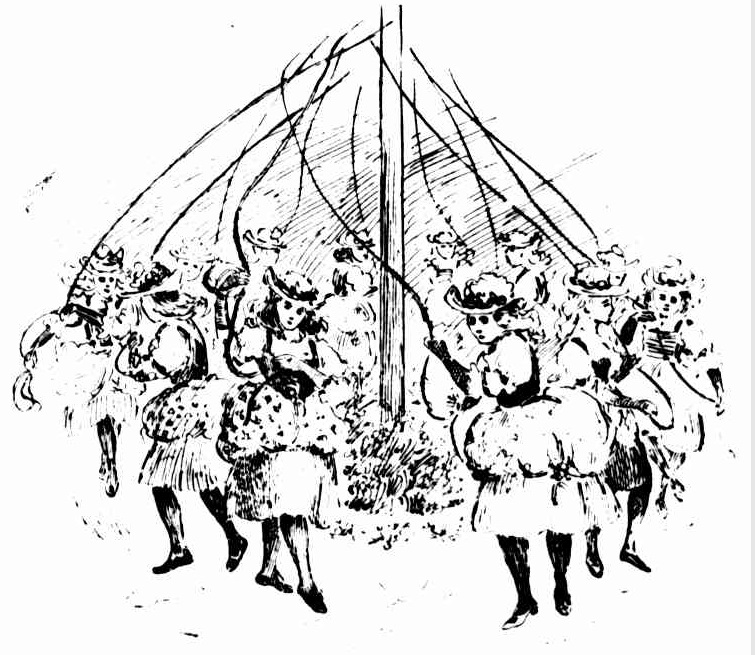
THE MAY-POLE DANCE.
The MANLY WILD FLOWER Show (1889, September 19). Illustrated Sydney News (NSW : 1881 - 1894), p. 15. Retrieved from http://nla.gov.au/nla.news-article63622020
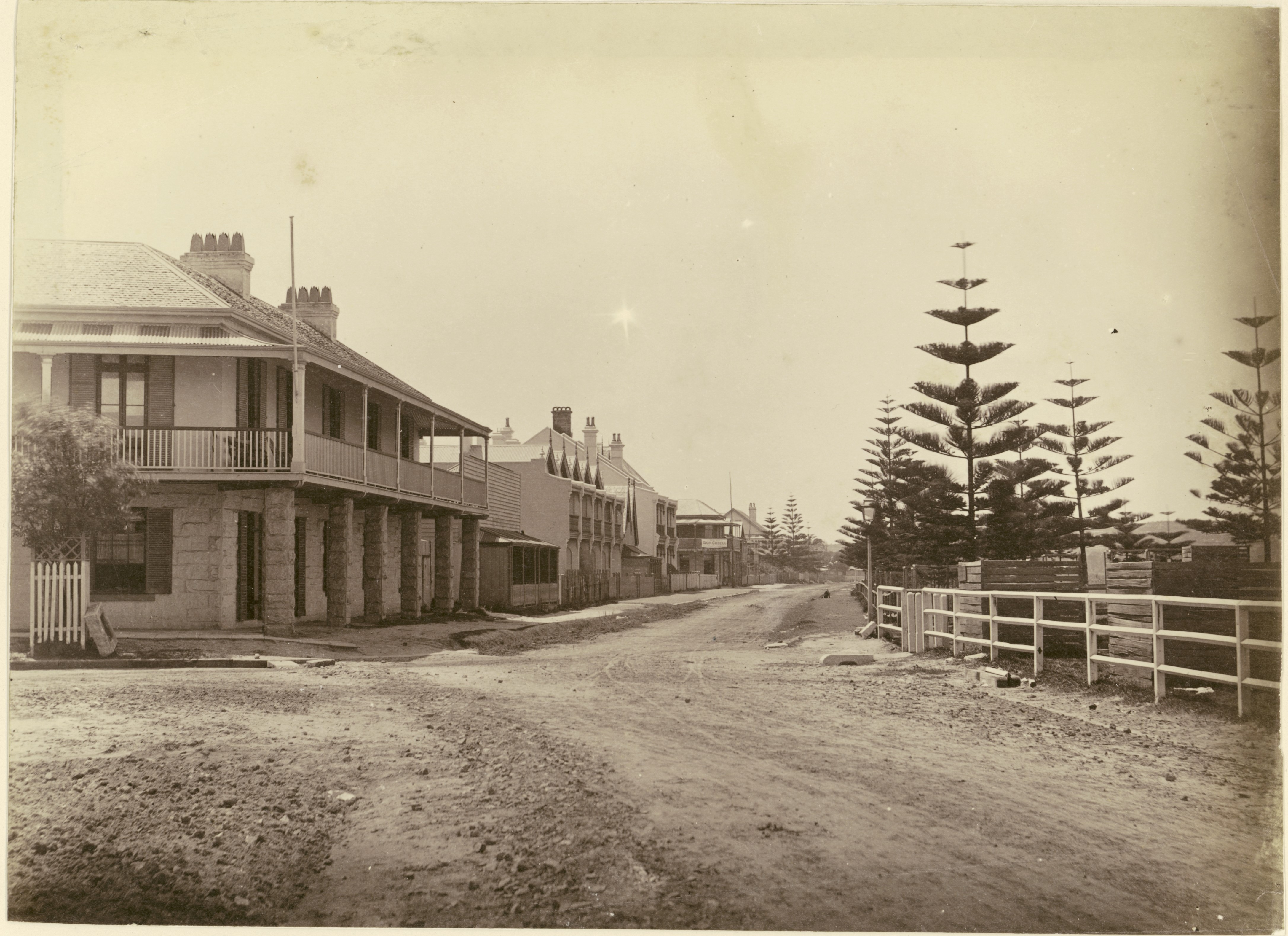
Manly streetscape; Steyne Hotel, corner of The Corso and Ocean Beach (left), circa. 1880-1890, courtesy State Library of New South Wales
Manly Wildflower Show.
Over 1500 people visited the show yesterday, and the floral decorations were greatly admired. The Maypole Dance is a great attraction; also the waxworks, theatricals, &ci, the tents being crowded every day and night. The refreshment tent is also doing a roaring trade. Manly Wildflower Show. (1890, September 26). Evening News (Sydney, NSW : 1869 - 1931), p. 4. Retrieved from http://nla.gov.au/nla.news-article113338361
MANLY WILDFLOWER SHOW.
The annual wildflower show at Manly was yesterday formally opened by Lady Jersey in the presence of a large number of spectators. The charming marine resort, which has long borne the title of " Our Village," was en /tie, and on the way to the show lines of flags were stretched across the streets. Lord and Lady Jersey, accompanied by Mr. Goschen (private secretary), arrived at the wharf shortly after 2 o'clock, where they were met by the Mayor (Alderman J. Cameron) and the aldermen, and presented with an address of welcome. The address contained views of the ocean and harbor from Manly, the whole being surrounded by wildflowers. The party were then driven round Manly and shown all the local "sights," the pavilion in which the show was held being reached at about a quarter to 3.
The Vice-regal party wore received by ex-Mayor C. R. Austin, and Lord Jersey was asked to declare the show open. Lady Jersey, however, undertook the duty and expressed her admiration for the scenery in and around Manly. She was, she said, glad to know that those flower shows, instead of tending to the destruction of the beautiful native area, tended to increase the interest and care of the public in the flowers. She then formally declared the show open, and was presented with a bouquet of flowers by a little girl. > The show itself compares favorably with any previous exhibition, both in extent and variety of the flowers shown. In the main hall the style of tho show has been totally changed, and instead of the heavy moss of foliage with whicli the building in previous years was decorated, it is made to represent an old stone structure covered with twining creepera and clinging moss. Tho proceeds of the show are to be devoted wholly to the improvement of the park and each stall has been prepared by one or other of tho various clubs which use the ground. At tho northern end the cricket club have formed a perfect bower of wild flowers, and from among masses of native roses, flannel flowers anu waratalis may be seen bats, stumps and the various other auxiliaries to the game of cricket. Stalls aro also held by the riflo club, tho lawn tennis club, tho Natural History Society aud tho football club. The Mauly Rowing and Sailing Club's stall, in addition to being splendidly decorated with flowers, contains a model of the club's sheds and a model of the yacht Sao.
"An Aborigines Camp" is the title given to an interesting portion of the show occupied by the Manly harriers stall. A scene from near Broken Bay is painted as a background, and in front, surrounded by masses of wild trees, are a number of aborigines seated round a camp, while some distance away a native warrior, boomerang in hand, is " cooeing" to his mates.
The fernery has been considerably enlarged and forms quite a feature of the show. At the rear of the pavilion are the refreshment booth and the Maypole dance booth, where entertainments are given at stated intervals. The show 1ms been devised and carried out under the superintendence of Mr. C. R. Austin, to whom praise is due for the excellent manner in which the exhibits ore shown.
The following are the ladies in charge of the various stalls : — " Rifle Club stall, Mrs. Haylock; Lawn Tenuis Club stall, Mrs. T. Smith and the Misses Ranson; Cricket Club stall, the Misses Wood ; Rowing and Sailing Club, the Misses Hack ; Bicycle Club stall, Mrs. C. R. Austin ; refreshment booth, Mrs. Moore and Mrs. Anslow; Maypole tent, Mrs. C. R. Austin and Mrs. T. C. Haylock. The show will raraain open until Saturday evening. MANLY WILDFLOWER SHOW. (1891, September 24). The Daily Telegraph (Sydney, NSW : 1883 - 1930), p. 3. Retrieved from http://nla.gov.au/nla.news-article235936502
The shows went ahead anyway, despite growing opposition and requirements at a state government level that the pickers be supervised to ensure the destruction of plants from root to fruit wasn't occurring.
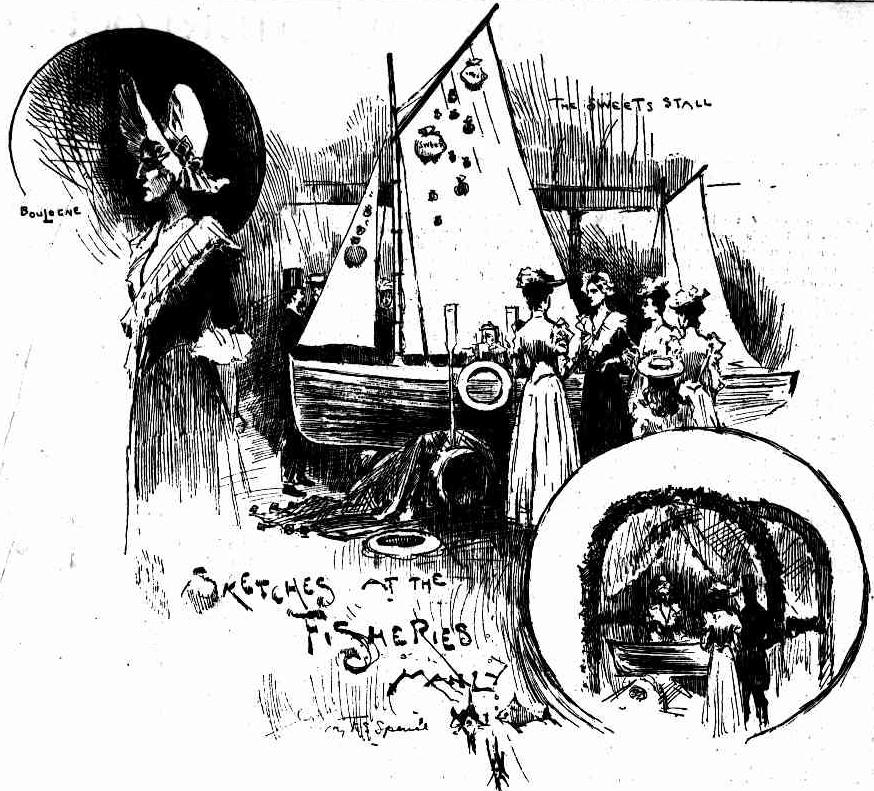
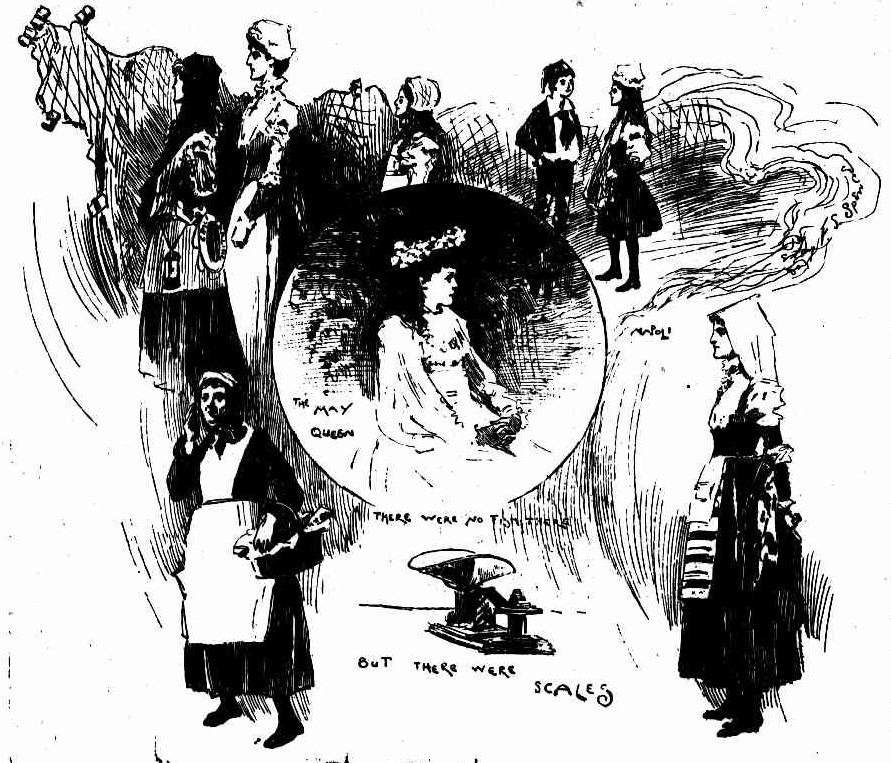
With the opening on December 23 1886 of the first Manly Aquarium, on the Corso, at least one of the shows occurred indoors when the pavilion in Ivanhoe Park became too dilapidated to be safe to use:
Manly Flower Festival.
The Annual Exhibition.
Upon the general result of the annual exhibition of wild flowers so auspiciously ' opened at Manly yesterday afternoon those who have interested themselves in this year's display are to be heartily congratulated. Compared with its predecessors the show must certainly be said to equal, if ' it does not surpass, those of former years, while the prospects of its being the success ' financially that it is artistically are most encouraging. It would seam, however, that but for the working classes of "our village" Uiure would have been no show at Manly ' this year. The working classes, for the promoters chose to apply that ' distinctive title to themselves, realised the amount of distress existing in the borough consequent upon the depressed times, and saw in the repetition of this annual festival an admirable opportunity for affording relief to those who had suffered thereby.
A show was accordingly determined upon, and with the kindly co'-operation of willing and energetic workers d toe committee who had taken the matter, in baud were enabled yesterday to congratulate themselves upon the fulfilment of a most worthy mission. , ' /.
In previous years, and, in fact, ever since the inauguration of this annual display of uncultivated blossoms, the old pavilion in Ivanhoe Park has been utilised. This year, however, the show is being held in the Aquarium, on the Corso, the pavilion being unfit for further occupation.
Tho- ..lima at)1 1 vsrlised for the formal opening of the exhibition yesterday was 2.30, nud;»t thasu hour a large assemblage filled, thc.building.
The Mayoress (Mrs. German), by whom the opening ceremony was to be performed was received on her arrival by. Mr.- Jiho Wood and the committee, Messrs.! JvA. Whitaker, \V. Kinchclla, H. J. Noate;-.-( A. J. De Mear and W. Gray.-
In declaring the show open Mrs. German expressed the hope that its success;! financially would be as great as it had been artistically. The Mayoress was thcnM presented by Miss Ida Ncatc with a very ." beautiful basket nf (lowers, -<G In tho arrangem ut of tho exhibits there' -is ample evidence of the untiring efforts that have been expended to bring about an effectivo display. Entorihg the hall one is : struck at tiie gorgeous prolusion of flowers in all their wealth of color and variety. The whole place is simply a mass ' of bioonib and foliage, and the eyo rests with ' admiration on the scene. Tho galleries are gracefully festooned, while from the roof of the building hang innumerable festoons -of gcebung.
In the centre stands a beautifully designed crown, made of floworB and over-greens, and rightly described aB a master-picco of art and' ingenuity. This inagni-firont flrtrr. 1 trnnliv Id ,sian/T unnn an octagonal stand which serves the pnrposo of a stall representing England. Thero aro four other stalls, each of which' can bo recognised by its national emblem. Tho 1 st ill. holders arc — England, Mrs. Bird and M;Si Gillett : Scotland, Mrs. Blair and Miss ; K ace ; Ireland, Mrs. Taylor and , Miss Wcekes; Australia, MissAria; America, Mrs. " XI' Grain and Whitaker, tho two lastnamed i h - vini; .1 very eleguntly-nrrangcd stall. . A ruiiiiii-luibly pretty acenio ilisplay is made, i On the Htuge wuh a mountain glen, in which a waterfall in all its rugged grandeur fulls i from a height of Beverul feet, the watef splashing itself over the feniM and other planlH which surround it in profusion., Tho ' nutting was arranged by Mr. W. Kincheila, whose reputation for that kind of work is I well known. ;
During the four days that the show will remain open entertainments of various ' kinds will be provided, amateur theatricals being the principal attraction. 'MANLY FLOWER FESTIVAL. (1893, September 29). The Australian Star (Sydney, NSW : 1887 - 1909), p. 3. Retrieved from http://nla.gov.au/nla.news-article227094089
A few notes bout that first Manly Aquarium:
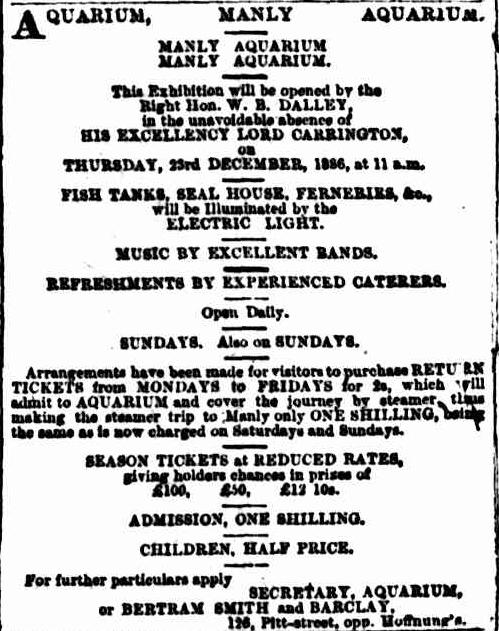
The Aquarium at Manly.
Our artist spent a portion of his holiday-season at Manly, and as a result we now furnish our readers with a few sketches which will enable thorn to form an idea concerning some of the attractions at the Manly Aquarium, a large two-story building on the eastern side of the Corso, which has been erected in a very short space of time forth* proprietors, Messrs. Griffin and Evans.
The building was not, commenced until late in October last. Between that time and the 23rd ultimo, when the Right Hon. W. B. Dalley performed the opening ceremony, a little short of half a million bricks were laid, a million and a quarter superficial feet of timberused, and nearly 700 casks of cement handled. Storage capacity for 50,000 gallons of water has been provided, irrespective of the seal tank, which contains 30,000 gallons or more. The building, without pretending to architectural magnificence, is a solid, permanent structure — designed in good taste and carried out with fidelity to engagements.
Within the first five days after the opening over 15,000 persons visited the aquarium, and the universal opinion is one of well-deserved admiration for the spirited enterprise which has secured such satisfactory results. The fernery, the sealhouse, with its singularly effective roof, the six chambers in which the specimens of wonders of the deep disport themselves in graceful and every-varying evolutions, their beautiful forms and their brilliant 'colourings, alone render a visit of great interest, amusement, and instruction. The sandy beds, shells, marine plants, and rocky caves offer distinct and lasting sources of interest, and' the charm is attested by crowds of admiring visitors. The seal, schnapper, yellow tail (which is equivalent to the English horse-mackerel), trevally, fathead, mullet, garfish, stingray, rock cod, octopus, old wife (one of the most beautiful in form and colour of the collection), the sweep, black bream, Jew fish, the tailor, sole, Port Jackson shark, swordfish, rainbow fish, and leather-jacket have representatives, and the collection will be daily increased.
The aquarium is to open daily from 11 until 5. and from 7 to 10 o'clock in the evening. The centre of the aquarium has been devoted to a large hall, surrounded by galleries and beautifully decorated. This will serve as a concert-room or lecture hall, which in itself is an acquisition to Manly, inasmuch as the township hitherto has not been well supplied in this respect.
Arrangements have been made to supply visitors with refreshments within the building ; and the Port Jackson Steamship Company have made concessions which enable the Sydney public- to visit the aquarium at a very slight advance upon the cost of an ordinary trip to the beach. The electric light enables visitors to inspect the contents of the tanks at night, and during the present month special attractions in. the form of concerts, vocal and instrumental, are provided. On Sunday evenings a special boat leaves Sydney at 7 to convey visitors to the aquarium, and returns at 9 o'clock. The Aquarium at Manly. (1887, January 8). The Sydney Mail and New South Wales Advertiser (NSW : 1871 - 1912), p. 77. Retrieved from http://nla.gov.au/nla.news-article163281060
SKETCHES IN THE MANLY AQUARIUM.
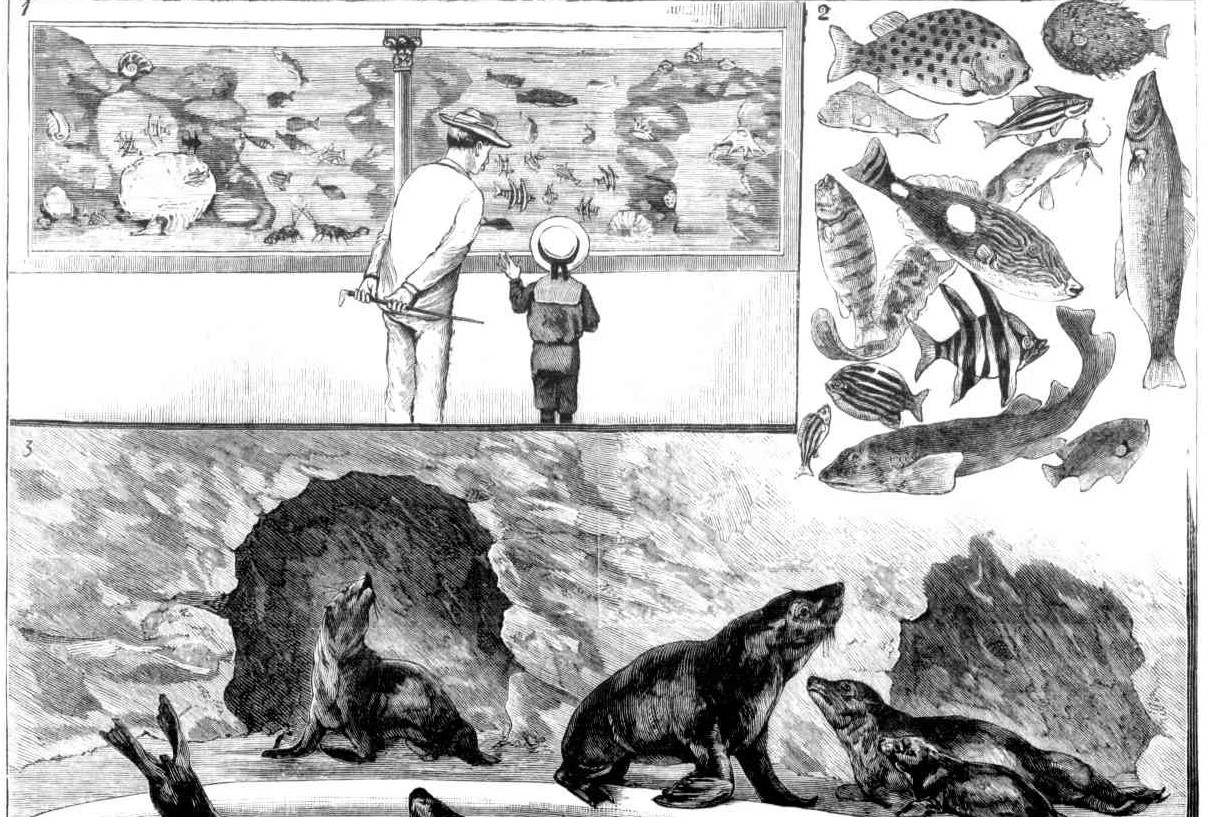
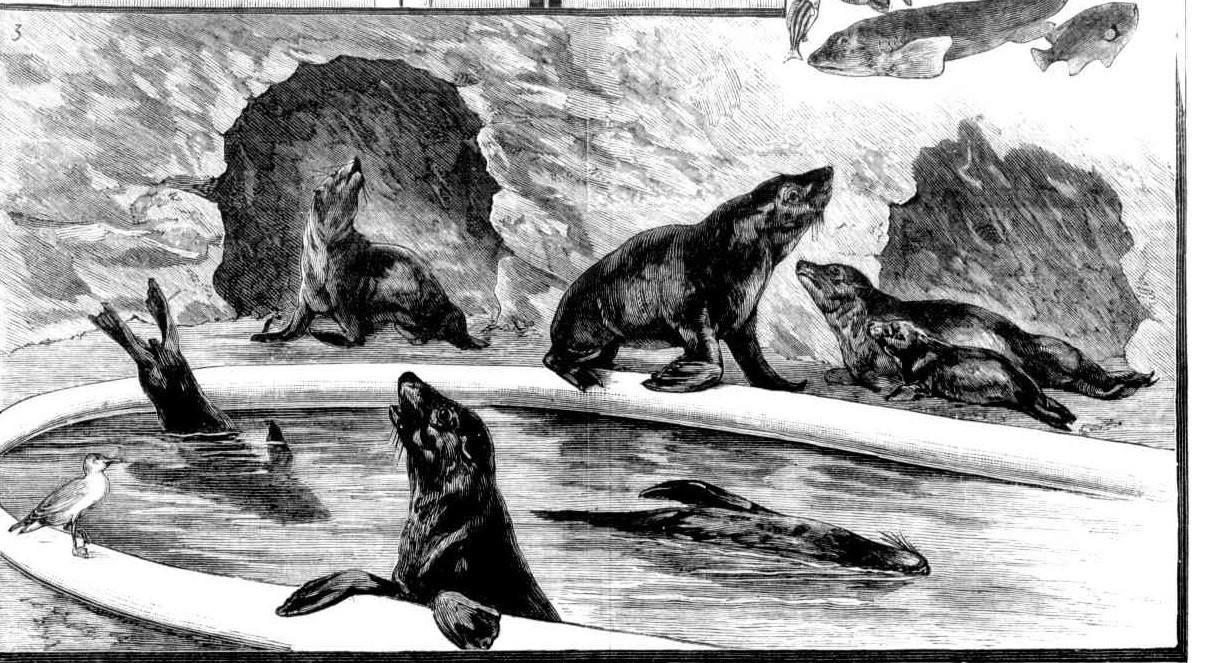
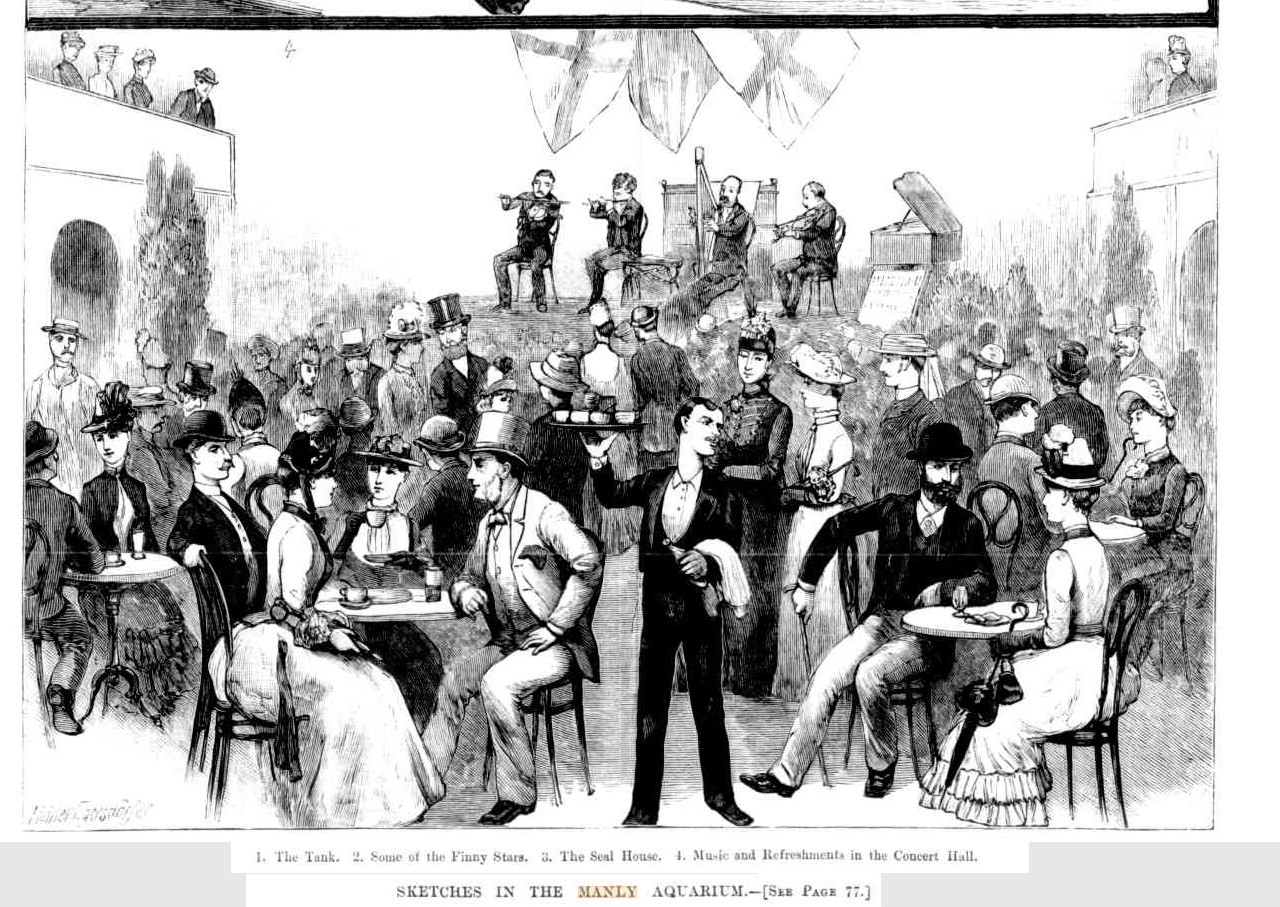
1. The Tank. 2. Some of the Finny Stars. 3. The Seal House. 4. Music and Refreshments in the Concert Hall. [See Page 77.] SKETCHES IN THE MANLY AQUARIUM. (1887, January 8). The Sydney Mail and New South Wales Advertiser (NSW : 1871 - 1912), p. 79. Retrieved from http://nla.gov.au/nla.news-article163281096
The Manly Aquarium needed a refurbish after a fire just 7 months after opening:
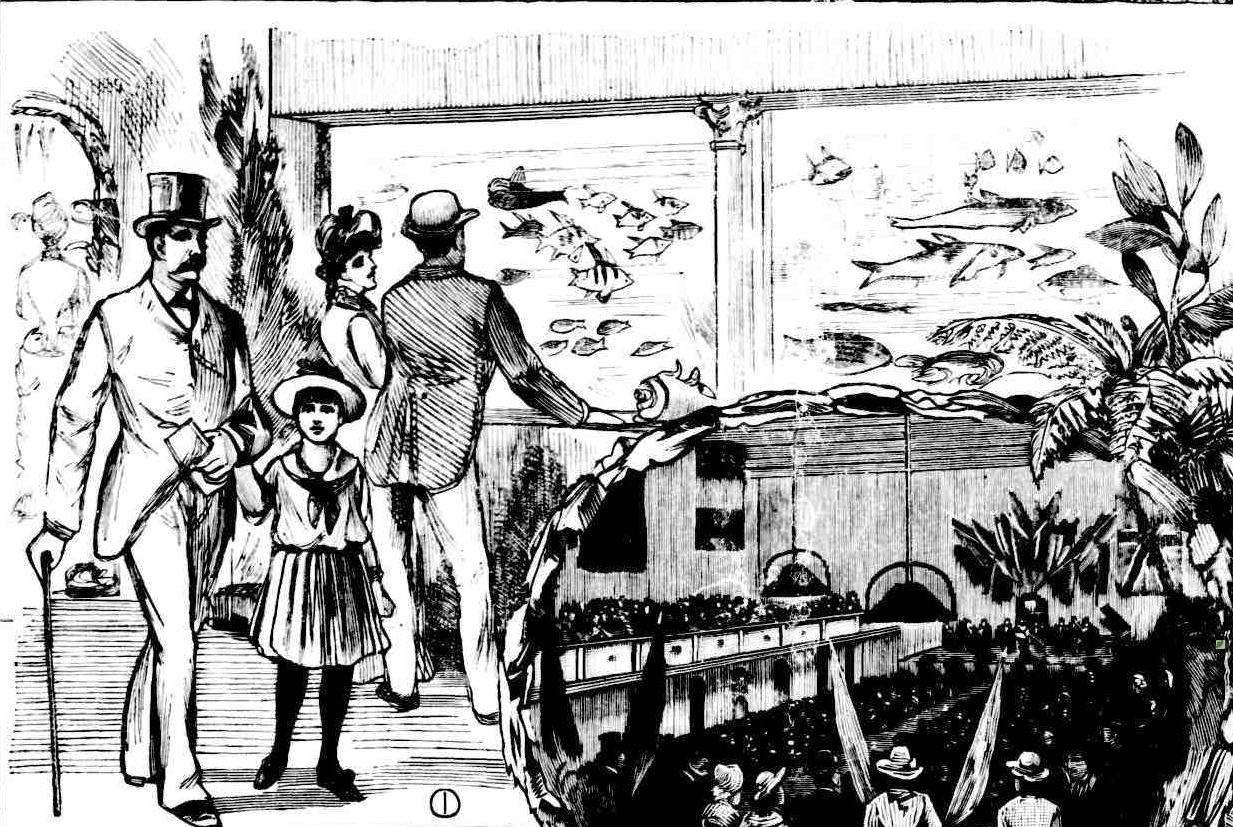
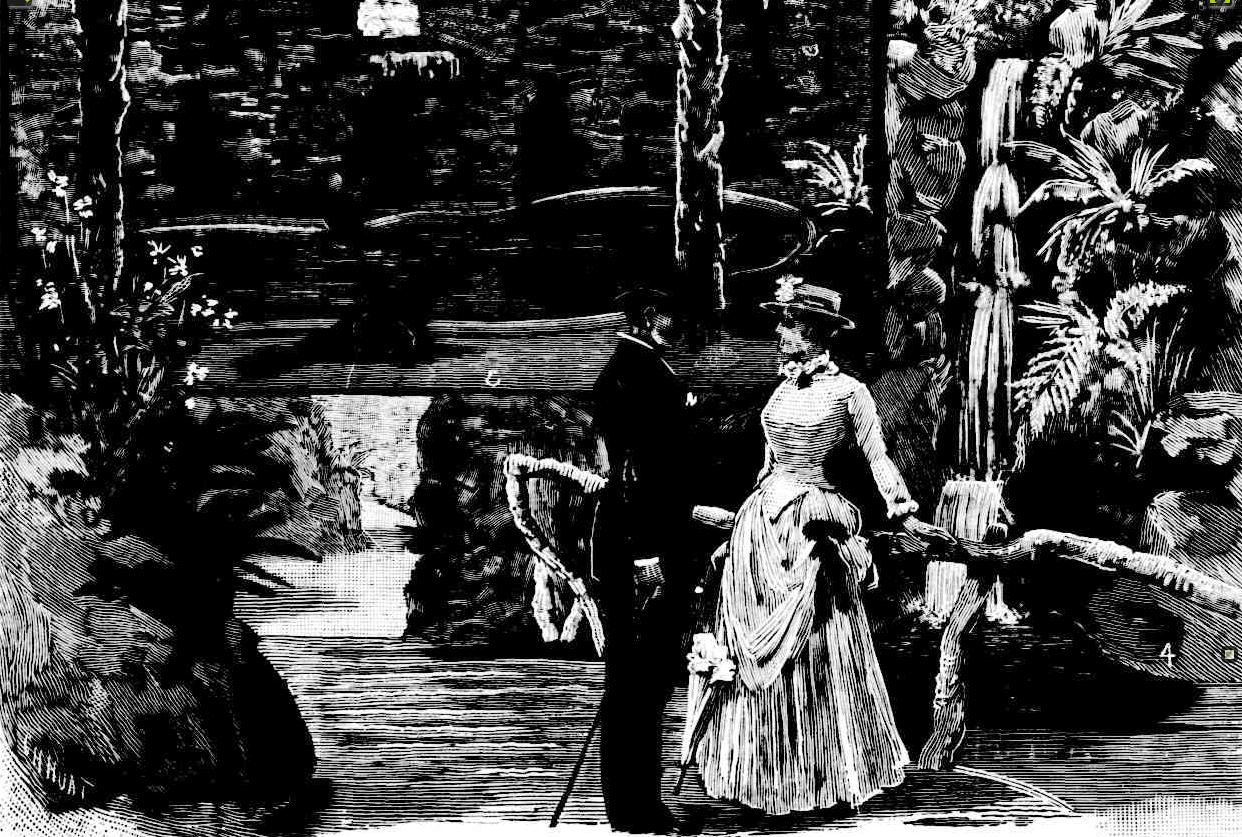
Manly Wild Flower Show.
Time was when the people of the 'little village by the sea' felt a yearning to assist some local charity they could create a wild-flower show by merely wandering round the vacant allotments at the backs of their houses, and gathering the flora in cartloads. But time, principally in the shape, of the ubiquitous professional flower-gatherer, and more recently the destructive bush fires, has changed all that.
A show such as was opened on the 1st is a thing to be undertaken with fear and trembling — and much expense. The material for the display is only to be obtained 'way back,' and the cost of cartage is heavy. Hence it is not surprising to find that the ' committee has rendered itself responsible for large sums in the preparation of this exhibition, but results are everything, and the members deserve much credit, not only for the wealth of the display, but for the manner in which it was disposed. There were five stalls in all, besides a charming little retreat for the dispensing of tea and light refreshments, and other side-shows, including a Maypole and a see-saw.
The ' Warringah ' stall, emblematic of the pastimes of the electorate, was presided over by Miss Butler and Miss Phillips, these ladies being assisted by Mesdames Butler and Frost and the Misses Bedwell, Wilson, Halloran, Walton, and Kirkpatrick. Next in order came the ' College' stall. This was fashioned on the model of St. Patrick's College, which is such a conspicuous landmark all round the neighbourhood of Manly. Mrs. James Falloa was in charge, assisted by the Misses Levy and Mesdames Furlong, Hanson, and Haylock. Facing the platform was the ' Esperanza ' stall, artistically arranged, and having as a centrepiece the Spanish coat of arms, the design of which was the work of Misses Warburton and Richards, who secured the prize for excellence in design. The stall was in charge of Mrs. M'Farlane, assisted by Mesdames Littlejohn, Eobev, Bobiu Littlejohn, King, and Misses Badgery and Carmody. The ' Palace ' stall, also a model of artistic skill, was presided over by the Misses Kelly, . with whom were Mrs. and Miss Adams and Misses Kirkham, Peasley, Morgan, and Lea. Last, but not least, came the ' Fairy Bower ' stall, with thatched roof and enchanting alcoves and prettily-dressed young ladies. Mrs. Freehill was in charge, and as assistants there were Misses Baxter, Scanlan, M'Donald, Clune, Morgan, Levy, and Hilder. The whole of the general decorations were contrived under the direction of Mrs. Townsend Robey.
The opening ceremony was performed in the presence of a large gathering of people. Lady and Miss Darley, attended by Captain Dangar, A.D.C., travelled down to Manly in a special launch, and were met at the wharf by the committee of the show, who drove them round the town before conducting them to the Aquarium, where the ceremony was to be performed. Arrived at the hall, they were welcomed by the stallholders and visitors.
Among those present were his Eminence the Cardinal, Monsignor Verdon, Monsignor O'Brien. Very Rev. Dr. O'Haran, Bev. Fathers Sl'Dermot and Hayden (hon. secretary of the show), the Mayor of Manly (Alderman H. E*. Farmer), Aldermen Passau, Carroll, German, Warburton, and Montagu, Mr. Dugald Thomson, M.L.A., Dra. Thomas and Watkins, Messrs. S. C. Sadler, J. J. Oalvert, G. A. Hoskings, and others.
The Mayor, in asking Lady parley to declare the show open, said the exhibition would compare favourably with its predecessors, notwithstanding the disadvantages with which they had had to contend.
In opening this show her Ladyship was not sanctioning any act of vandalism. A good deal had been said on this subject, but the flowers now exhibited had not been gathered by those who destroyed roots and everything in their desire to make a good display. The very men who had collected these flowers were the men whom it was intended to license under the proposed bill for protecting the native flora.
Lady Darley said :
I thank you very much for the hearty welcome you have given to me in coming to open your show. It is a long 'time since I was at Manly, and I see a great change and improvement in the whole of the town, through which I have just had a very pleasant drive. I never before attended a wild flower show here, but I think it is one of the most beautiful exhibitions I have ever witnessed. The tasteful arrangement of the flowers, and the harmonious effect of colour, are something such as I have never before seen. I wish the show every possible success, and have very much pleasure in declaring it open. (Cheers.)
At the instance of the Cardinal a vote of thanks was accorded to Lady Darley, The proceeds of the show are to be devoted to the Roman Catholic Church at Manly. Manly Wild Flower Show. (1895, October 12). The Sydney Mail and New South Wales Advertiser (NSW : 1871 - 1912), p. 771. Retrieved from http://nla.gov.au/nla.news-article162672536
MANLY WILD FLOWER SHOW.
the opening ceremony.
CARDINAL MORAN ON "THE ATTRACTION OF MANLY."
The annual wildflower show at Manly was opened yesterday afternoon in the presence of a large attendance of local residents and of visitors from Sydney. The show is one of the great events of the Manly year, and upon this occasion special efforts have been made. The proceeds are to be devoted to the aid of the Roman Catholic Church at Manly; and so far, judging by the results of the opening day, the prospects are highly encouraging. The Rev. Father Hayden is the hon. secretary, and Messrs. Macfarlane and Phillips are the hon. treasurers; whilst the committee consists of the Rev. Dr. Burke, Alderman F. C. Passau (Mayor of Manly), Alderman Owen Carroll, Alderman Quirk, Dr. Thomas, Dr. Watkins, and Messrs. Hoskings, M'Dermott, J. II. Butler, Mullett, Dargan, aud C. J. Smith.
The show Is being held In the Aquarium-hall, the stalls being located under the galleries. The general designs for these stalls are due to Mr. F. Trenchard Smith, and the stalls themselves are built up mostly on a groundwork of geebung and lilypilly. The rest is a wealth of yellow knots, pink neatu, boronia, waratah, uiuiuci huwci, mu.-den wreath, and a hundred other varieties of native flora. Just at this period of the year the blossoms are all at their freshest and best, and the effect Is altogether admirable. But there are other features of Interest.
A maypole dance by children, directed by Mrs. O'Grady, attracted a good deal ot attention yesterday, and SIgnor Schlavl'3 orchestra discoursed selections at intervals. Naturally, the fancy fair element was largoly In evidonco, and a host of ladles spent n busy time In persuading folk to purchase flowers, cigars, cigarettes, lollies, and ribbons, whilst those who lilted to try thoir luck found plenty of opportunity in the inevitable raffle.
In the absence of Lady Hampden, the opening ceremony was performed by Mrs. F. C. Passau, the Mayoress of Manly, at the request of his Eminence Cardinal Moran.
The Cardinal, In a few preliminary remarks, said that every suburb had its peculiar attraction; and the attraction of Manly was Its wildflower show, which, moreover, had, on this occasion at least, an excellent object to recommend it. The native flowers of the district were famed not only throughout the colony, but throughout Australia; and they had done much to make the seaside village of Manly known. Federation was no longer only In the air, and he hoped that in the near future Manly would have the wildflower show of ii Federated Australia. (Cheers.) In fact, It was the wild-flower show of Australia already.
Among the clergy present, In addition to the Cardinal, were the Rev. Dr. O'Haran (private secretary to his Eminence), the Rev. Dr. Murphy, the- Rev. Dr: Burke, Monsignor O'Brien, and the Rev. Fathers Hayden, M'Dermott, Brosnan, Dowling, Prendergast, and Fitzgerald; whilst other visitors Included the Mayor of Manly (Alderman F. C. Passau), Mr. J. T. Toohey, M.L.C., Mr. F. B. Freehlll (Consul for Spain), Aldermen Quirk and Owen Carroll, and Dr. Watkins.
The stallholders were as follow: — The Normandie Stall. — Mrs. F. B. Freehill, Mrs. J. T. Toohey, and Mrs. Aloysius Macdonald. .Assistants: Miss Marion Plomley, Miss Alice Irving, Miss Sylvia Williams, Miss May Baxter, Miss O'Grady. and Miss Ruby Carroll. Post-office Stall.— Mrs. J. Ferris, Miss Jenkins, and the Misses Kelly. Shamrock Stall— Mrs. W. Douglas, Mrs. Joseph German, Mrs. J. H. Butler, and Mrs. Prendergast. Assistants: Miss Bryan, Miss Fitzsimons, Miss J. Hanson. Mi6s Lane, Miss Neodham, Miss Harvey, and Miss Montagu. I Boomerang Stall. — Mrs. Herbert Murray, Miss M. Phillips, and Mrs. P. Burko. Assistants: Miss Kirkpatrlck, Miss Gwladys Ralfe. Miss Passau, Miss A. Bedwcll, Miss Mollie Watklns, Miss M. Bedwell, nnd Miss Line. Cafe Espagnol. — Mrs. Macfarlano. Assistants: Mrs. C. R. Murray, Mrs. Bronnan, Miss Baxter, Miss Mackler, Miss Oxenham, Miss Macfarlane, and Miss Green. The Gunyah. — Mrs. C. Fitzell, Mrs. C. Smith, Mrs. Trim, and Mrs. Mayberry. Assistants: Miss Farley, Miss Montefiore, and Miss O'Keith. The show will be open for the remainder of the week. MANLY WILD FLOWER SHOW. (1898, September 28). The Daily Telegraph (Sydney, NSW : 1883 - 1930), p. 7. Retrieved from http://nla.gov.au/nla.news-article239469739
Manly Wild Flower Show.
By Winifred.
On Tuesday, 27th September, the ' little village ' was gay with flags and with visitors, and as the day chosen for the opening of the floral festivity was fine and cool the success was distinctly assured. By our sketches you will all note how neither time nor labour had been spared in providing a grand display and that native geebung and lilypilly formed a groundwork worthy of every effort. The remainder seemed a wealth of yellow knob, pink heath, boronia, waratah, flannel flower, and a hundred varieties of native flora. The designs were so well worked and to such advantage that the blossoms all looked their freshest and best, making the congratulations bestowed on the originators doubly acceptable.
The stalls were built in the Aquarium Hall, and in each instance under the gallery, leaving the centre space for maids and maidens to tempt the visitors with wares and raffles. But there were other features of interest, including a maypole dance, a cigarette stall, a sweet stall, a post office, and two tea stalls, where pretty girls drew us without a murmur — on our parts. Tea is a luxury that appeals to all, even when purses have been emptied previously on bouquets, buttonholes, and equilly unnecessary purchases. But really the tea stalls at the show were pretty, and so cool — m fact, the ideal resting-place for the visitors who arrived somewhat blown about after the half hour's windy trip from Sydney. To sip tea at any time is restful, but to sip it amidst a bower of greenery banked with walls of lilies and ferns was, perhaps, specially .delightful. Opposite to this little bower was the Shamrock Stall, where sweet-singing dicky-birds chirped happily amidst wild flora, maidenhair ferns, and dainty fans of roses and pink heath.
The Boomerang Stall was also well in evidence, and, apparently, by the crowd that surrounded it, will have good results to show on behalf of the charity.
In the absence of Lady Hampden, the opening ceremony was performed by Mrs. F. C. Passau at the request and in tho presence of his Eminence Cardinal Moran. Among the clergy present were the Rev. Dr. O'Haran (private secretary to his Eminence), the Rev. Dr. Murphy, the Rev. Dr. Burke, Monsignor O'Brien, and the Rev. Fathers Hayden, M'Dermott, Brosnan, Dowling, Prendergast, and Fitzgerald, whilst other visitors included the Mayor of Manly (Alderman F. C. Passau), Mr. J. T. Toohey, M.L-C., Mr. F. B. Freehill (Consul for Spain), Aldermen Quirk and Owen Carroll, Dr. Watkins, Mrs. J. T. Toohey, Mrs. Mullins, Mrs. Brennen, Mrs. Monttfiore, Mrs. Conor O'Brian and her daughter, Miss Woods, and others. Since the opening ceremony the flower show has been crowded daily, denoting that our native heath can still claim interest from us all.
.jpg?timestamp=1725762625530)
.jpg?timestamp=1725762651951)
1. View from Gallery. 2. Mrs. Prendergast's and Mrs. German's Stall. S. From the Entrance. THE MANLY WILD FLOWER SHOW.
Manly Wild Flower Show. (1898, October 8). The Sydney Mail and New South Wales Advertiser (NSW : 1871 - 1912), p. 863. Retrieved from http://nla.gov.au/nla.news-article163807187
The Manly Wild Flower Show of 1899 sows a shift from being held in the Aquarium on the Corso and the need to hire, or borrow, a large marquee - adding to potential costs to be recouped. This was also a very late and last minute put-together show, with the first meeting discussing the possibility held midway through the first month in Spring itself:
MANLY FLOWER SHOW.
A public meeting was held in Purves's rooms, Manly, last night to consider the advisableness of holding a flower show. Representatives from the athletic bodies and from the Congregational i Church, were present and after discussion it was decided to hold a flower show this year. It is to be nothing but a wild flower show, pure and simple.. The affair is to be on a large scale, and to be a novelty in the way of entertainment for Manly. It is intended to hold it this time in the park, close by the cricket oval, and to erect a huge structure of canvas or wood. Mr. D. Ogilvy was authorised to make all arrangements and report to a meeting to be held on Tuesday. MANLY FLOWER SHOW. (1899, September 15). Evening News (Sydney, NSW : 1869 - 1931), p. 4. Retrieved from http://nla.gov.au/nla.news-article113265039
MANLY FLOWER SHOW.
Lady Harris '(Mayoress of Sydney) will open the Manly Wild Flower Show on Tuesday, October 10. The show is to run from Tuesday to the following Saturday, and is to be held at Fern Gully, behind the Manly Cricket Ground, close to the site where the Bower shows were held years ago, and which were such phenomenal successes.
The marquee to be erected is the largest in Australia, and covers an area of 130ft by 85ft, and will hold 5000 people, and is to be illuminated by acetylene gas. Prizes are offered by the committee for the best bridal bouquet, hand basket of flowers, etc., and already there is 'plenty of interest displayed in the show by the ladies of Manly, many of whom are adepts at bouquet forming. The tent is to contain twenty stalls, with a bandstand in the centre, the committee finding a difficulty in allotting the stalls, owing to the number of the applicants. There will be also a theatrical tent, to hold 800 people, and which contains a stage and maypole. The Misses Chapman are drilling the children for the latter. Concerts in the afternoon and evening are arranged, and Mr. D. Ogilvy (the hon. sec.) reports that with his committee of the cricket and other clubs all the arrangements are well forward. MANLY FLOWER SHOW. (1899, October 3). Evening News (Sydney, NSW : 1869 - 1931), p. 3. Retrieved from http://nla.gov.au/nla.news-article113687501
The Show itself included nightly torchlight tours, music and theatrics and, according to the Sydney Morning Herald; 'an interesting spectacle is presented as the local fire brigade parades the village, headed by the band of the National Guard', despite that first meeting of Manly citizens report stating it would be about flowers only.
This show also was responsible for the 'harvest' of thousands of bushflowers, which by then had to be sourced from outside of Manly, and prominent among these were:
THE MANLY FLOWER SHOW.
The arrangements to make the Wild Flower Show, to be held to-morrow in Fern Gully, a beauty spot at the rear of the cricket ground, a record one, are well forward. Crowds of willing helpers were busy till midnight on Saturday decorating the stalls. The tent is a mammoth one,being 130ft long, and Messrs. W. Watson and J. Patison have been very successful in the arrangement and erection of the miniature shops. The stalls are all on a different plan, the most prominent being the Manly Cricket Club pavilion (Mrs. J. H. Sanderson). The Geisha (Misses Passau and Isaacs) and the Lawn Tennis Club (Mrs. C. Murphy). There are sixteen ordinary bazaars ranged round the sides of the tent, while the centre is occupied by a large platform for the band, and two large octagonal stalls. The acetylene gas was used on Saturday. '
In the way of amusements there is a theatrophone (by Edison), never before heard in Australia, and the Georgia Magnet Party, who also make a first appearance. Concerts are to be held in a special tent, and a maypole dance, of an entirely novel description, is to take place daily.
The flowers are all arranged for, and among the contracts is one for 5000 waratahs, the first batch of which came to hand this morning. The National Guard Band has been engaged, and is to be received by the Manly Fire Brigade, who give a dinner in their honor on Wednesday. Fine weather is alone needed to make the show a gigantic success. THE MANLY FLOWER SHOW. (1899, October 9). Evening News (Sydney, NSW : 1869 - 1931), p. 8. Retrieved from http://nla.gov.au/nla.news-article113697943
MANLY FLOWER SHOW.
As was anticipated, a record attendance was present at the Wild Flower Show on Saturday, and the stalls and surroundings looked as fresh as on the opening day. The business done by the lady -assistants was very, gratifying. The honor of taking the most cash on the day's business fell to Mr. . L. H. Wyatt, who presided over the tobacco stall, Mrs. Sanderson being a very close second with her prettily arranged cricket booth. Very large numbers of visitors came from Sydney, and all were more than pleased with the good entertainment provided, the theatre tent having crowded 'houses' at every performance. MANLY FLOWER SHOW. (1899, October 16). Evening News (Sydney, NSW : 1869 - 1931), p. 8. Retrieved from http://nla.gov.au/nla.news-article113696914
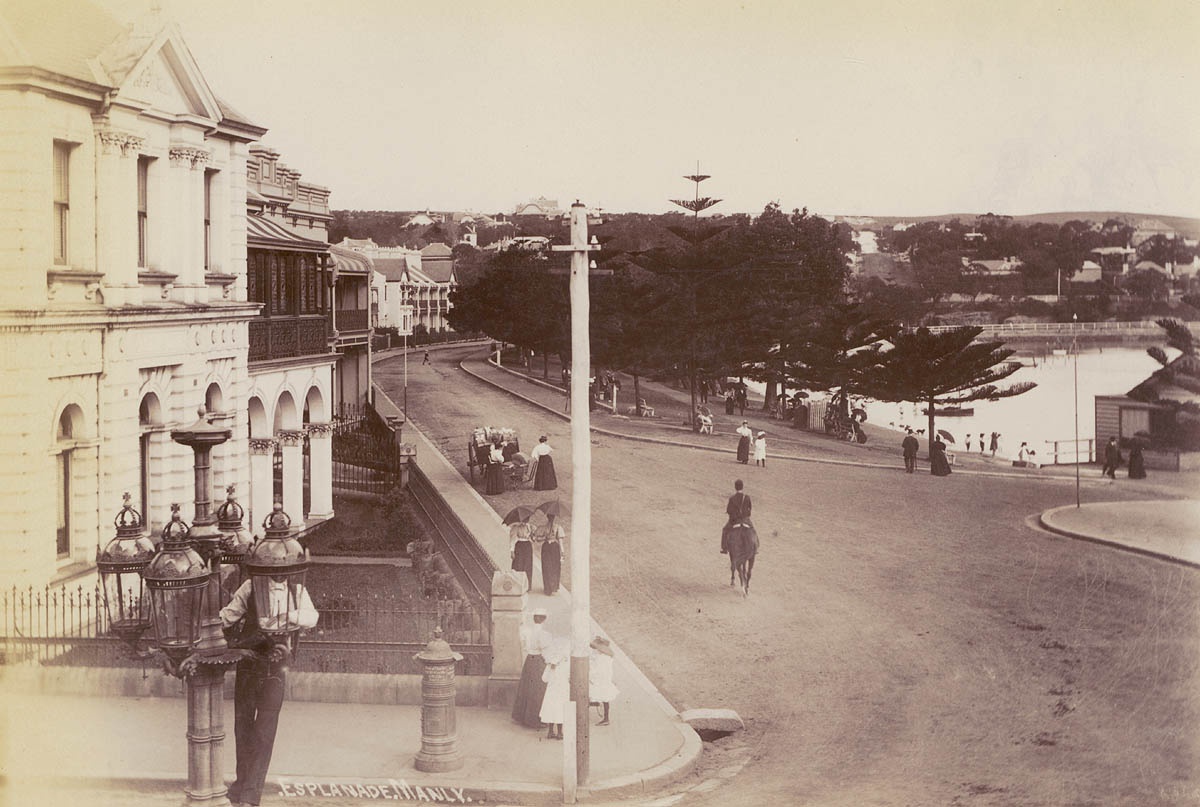
Manly Esplanade, ca. 1900-1910, courtesy NSW State Library. Item: SLNSW_FL1713667
However, despite the cessation of the Manly Wild Flower Shows, the pillage of the bush continued:
WILD FLOWERS AT MANLY.
Complaints have been frequent from the trustees of the Manly catchment-area that wholesale destruction of the native flora was caused by over-zealous flower gatherers. In a report to the Water and Sewerage Board, the engineer-in-charge of the area stated that in consequence of warnings, the depredations - of the flower seekers had been considerably minimised.
He had searched the Acts, but could not find a clause which provided for the protection of the flowers. WILD FLOWERS AT MANLY. (1913, October 8). The Daily Telegraph (Sydney, NSW : 1883 - 1930), p. 8. Retrieved from http://nla.gov.au/nla.news-article238901968
MANLY BATTLE OF FLOWERS
A battle of flowers, a quaint and old-world function, will be held at Manly on Saturday next, from 4 p.m. to 11 p.m., in aid of the funds of the local War Chest Fund. The procession will take place at 8 p.m. Prizes will be offered for the best decorated motor car and the most beautiful fancy dress. MANLY BATTLE OF FLOWERS (1917, January 20). The Sun (Sydney, NSW : 1910 - 1954), p. 6 (FINAL SPORTING). Retrieved from http://nla.gov.au/nla.news-article221958464
As can be read above, and despite all the objections to the destruction of native flora that commenced decades before, there were no protections in place to stop the looting of the bush for profit.
During 1926 a Bill to make provision for the regulation and control of the picking of wildflowers and native plants was brought into the Legislative Council and in 1927 became law. In this law, provision was made for the notification of any wildflower or native plant to be protected throughout the whole State of New South Wales, or in any part of the State.
As was the case with the Birds and Animals Protection Act, the Wild Flowers and Native Plants Protection Act, 1927 was based upon a Draft Bill prepared by the Australian Wild Life Society and clearly led, once again, by the people from Manly and up to Barrenjoey in Pittwater and those who spoke up before this era.
The Society had been successful in obtaining official protection for the koala first in 1911 and 1912, in New South Wales.
WILD FLOWERS.
Manly's new garden.
At Manly, on the new reservation, which was recently dedicated and named Park Hill Park, a large area Is being set aside as a national native wild flower garden. Every-thing possible is being done to preserve native flora.
The Mayor of Manly (Alderman Crossi and the council are Intent on making the new park worthy of the municipality. Special attention is to be paid to a large area of swampland, in which there are millions of Christmas bell plants.
"That piece of country," said the Mayor, "is the only one of its kind in the possession of any local government body on the nearer coastline. We Intend to preserve every inch of the area."
Footpaths have been constructed to points of interest overlooking the ocean and harbour, and a long footpath running parallel with the main traffic road has also been made. Arrangements are also being made to plant a memory avenue before August ends. More than 200 young pine trees will be placed in position. WILD FLOWERS. (1933, August 7). The Sydney Morning Herald (NSW : 1842 - 1954), p. 3. Retrieved from http://nla.gov.au/nla.news-article16996092
Although it may be a paradox to the current generation that so many flowers were ripped by the root from local soil to be put on display to build or extend churches and look after Ivanhoe Park so it may be a celebration of local flora, given so many of us see the whole planet as one perfect church of many colours, seasons and their songs, and songlines where what is within will surely manifest what is without, the 'it cannot be exhausted' context believed then must be taken into account.
Since Europeans landed in Australia they were required, when undertaking a grant for land, to clear that land - so many acres each year. Failure to do so meant they forfeited that land grant. Likewise,. from the outset of Europeans 'settling' in Australia,. the largest and ancient trees were cut down and shipped to England to make ships - the fealty of the 'Royal Estate' - from which we get real estate, meant whole forests were cut down for the benefit of the crown. Those trees closest to water, such as those that once grew alongside the Pittwater estuary and in the gullies around our creeks, were the first to go as in a land without roads, water became the highway for a marine based nation.
Despite the Manly Wild Flower Show proving within just a few years there is no inexhaustible supply of wild flowers and wild life, the practice continued. Those who were poor stole flowers to sell to feed themselves and their families - likewise all our native wildlife was hunted so their downy furred skins could be sold, for profit.
Even with the hard work of so many local volunteers to remove introduced weeds, restore and maintain local bush areas in Bushcare groups across Pittwater, and a few groups who work further south, locals must wonder how many species were irretrievably lost during the almost 20 years of Manly Wild Flower Shows taking and taking and taking.
How many local possums, bandicoots and birds and their youngsters starved every Spring because all their food had been taken to be put in a show?
The destruction led to people recognising there was no infinite amount of land and bush that could be destroyed. Even those who had been brought up witnessing the destruction armed themselves with knowledge that confirmed those inner feelings that hearken to the ancient songs and became the opponents of those who would persist in destruction of our bush and wildlife, for profit.
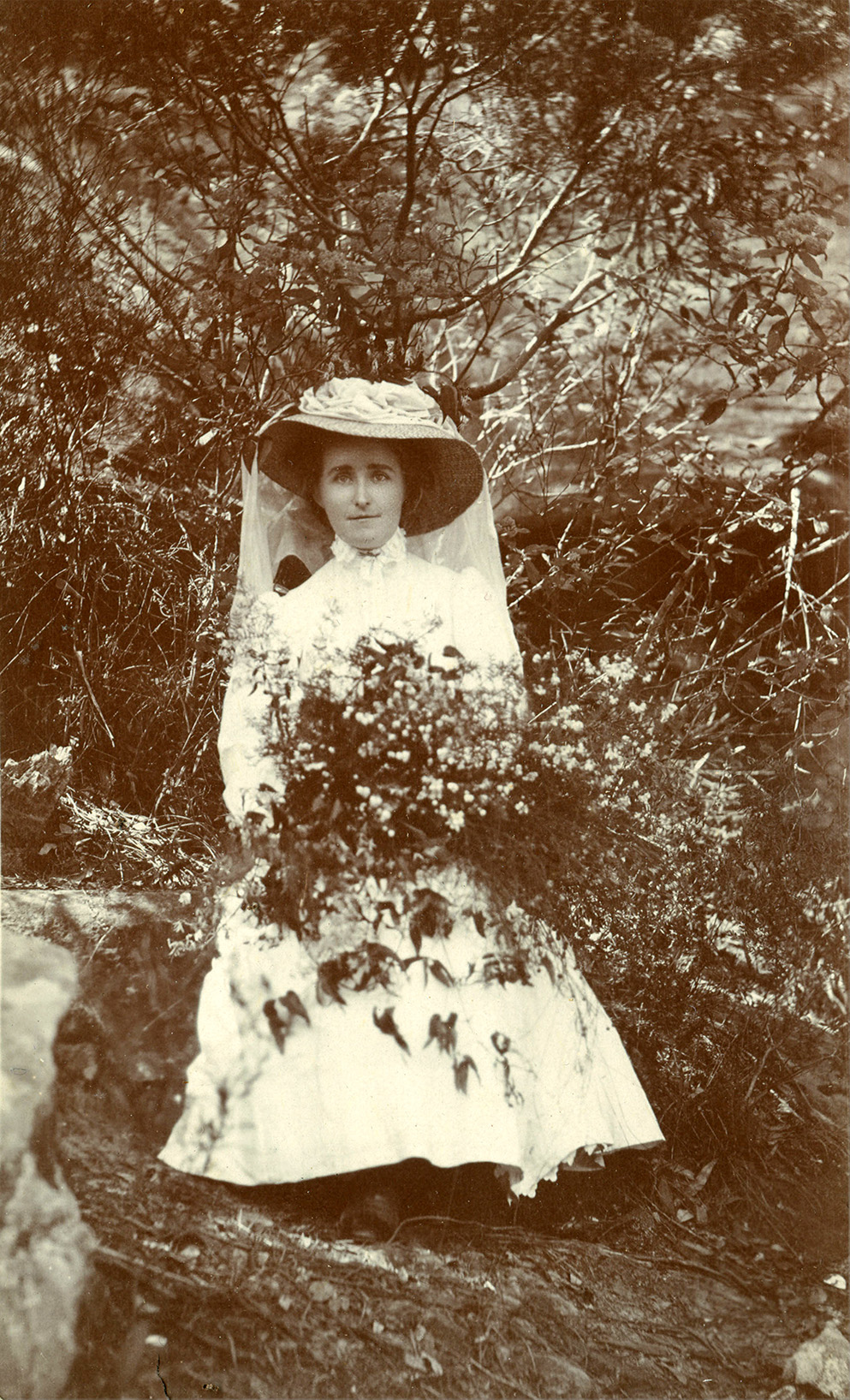
Annie Forsyth Evans, later Wyatt with wildflowers at her family's home Girrahween in Manly circa 1905 - from from family album held by Lynnette Lee.
We have had many champions of keeping the bush in our local bush. Marie Byles, Annie Wyatt, and Frederick Eccleston Du Faur were all frequent visitors or spent many a season here. Even later 'developers' like A J Small of 'Avalon' had a firm eye set on keeping the green in our greens; Angophora Reserve, the parks atop Bilgola Plateau, the Village Green of Dunbar Park are just some of all that came from his pocket and purse.
Also living here were residents who would plant trees, sing about the flowers, whether famous poets like Dorothea Mackellar of Lovett Bay, or earth-working year round Pittwater people who would choose a native over a non-native tree for, say, Taramatta (Mona Vale Village) park and even name places after a Rock Lily - which still appeared on birth certificates into the early 1920's - 'birthplace; Rock Lily' - the place, not the wayside inn and dining rooms.
Even the Manly Wildflower Show was a great idea prior to too many ripping out too many flowers to be 'on show'.
The Manly wildflower shows in their day were things of joy and beauty, and a great attraction for visitors. The first show was originated by Mr. Hayes, along with the Rev. T. Willis, while the former was Mayor, Mrs. Hayes and other ladies joined heartily in the scheme, which was to raise funds for St. Matthew's Church, and afford an advertisement for Manly. Willing volunteers gathered in the wildflowers, which were then abundant all round Manly, and the initial function was an astonishing and gratifying success. Mrs. Hayes states that over £250 was taken by the ladies in the first two hours of the festival of flowers. Each succeeding year the shows grew in importance, and attracted thousands of visitors from the city. The Manly Wildflower Show became a yearly event for the whole of Sydney, and was a fine advertisement for the place. Thousands of pounds were raised, which went to helping the different churches, who took half the proceeds, while the council received the other for the Improvement of the reserves. It was from the money gathered from the flowers that the oval was filled in and brought up to its present satisfactory condition, and many other park improvements were made from the funds. With the increasing scarcity of wildflowers the flower shows died out, after nearly a dozen years of existence. OLD MANLY. (1912, April 28). The Sun (Sydney, NSW : 1910 - 1954), , p. 11. Retrieved , from http://nla.gov.au/nla.news-article228857438
Throughout the gathering of threads for history subjects insights of how much the whole peninsula bloomed with every variety of native flower, and even recent and current adjustments to ensure the survival of those now threatened, as in the case of Grevillea cayli or the Angus's Onion Orchid, have allowed insights into what those who came before us saw and how we lost so much so soon.
All those who are part of today's Bushcare Groups, whether in their schools as students planting out native species in school grounds, in local reserves as adults or Duke of Edinburgh award students, weeding and watering and restoring with endemic plants, and even the work of our MP for Mackellar, Dr. Sophie Scamps as she persists in calling for an end to the logging of native forests, are those who are helping to restore the original church and its living temple, and carrying forward the possibility that a full restoration may take place.
The list of local Bushcare Groups is a permanent part of the Environment page, should you feel an urge to join the ranks of those who are determined to save local flora and fauna.
For when we were children we used to talk as a child, think as a child, reason as a child; when we became an adult, we put aside childish things.
notes
Birds Protection Act, 1901, and the Native Animals Protection Act, 1903
The 'Kangaroo Hunts at Manly'
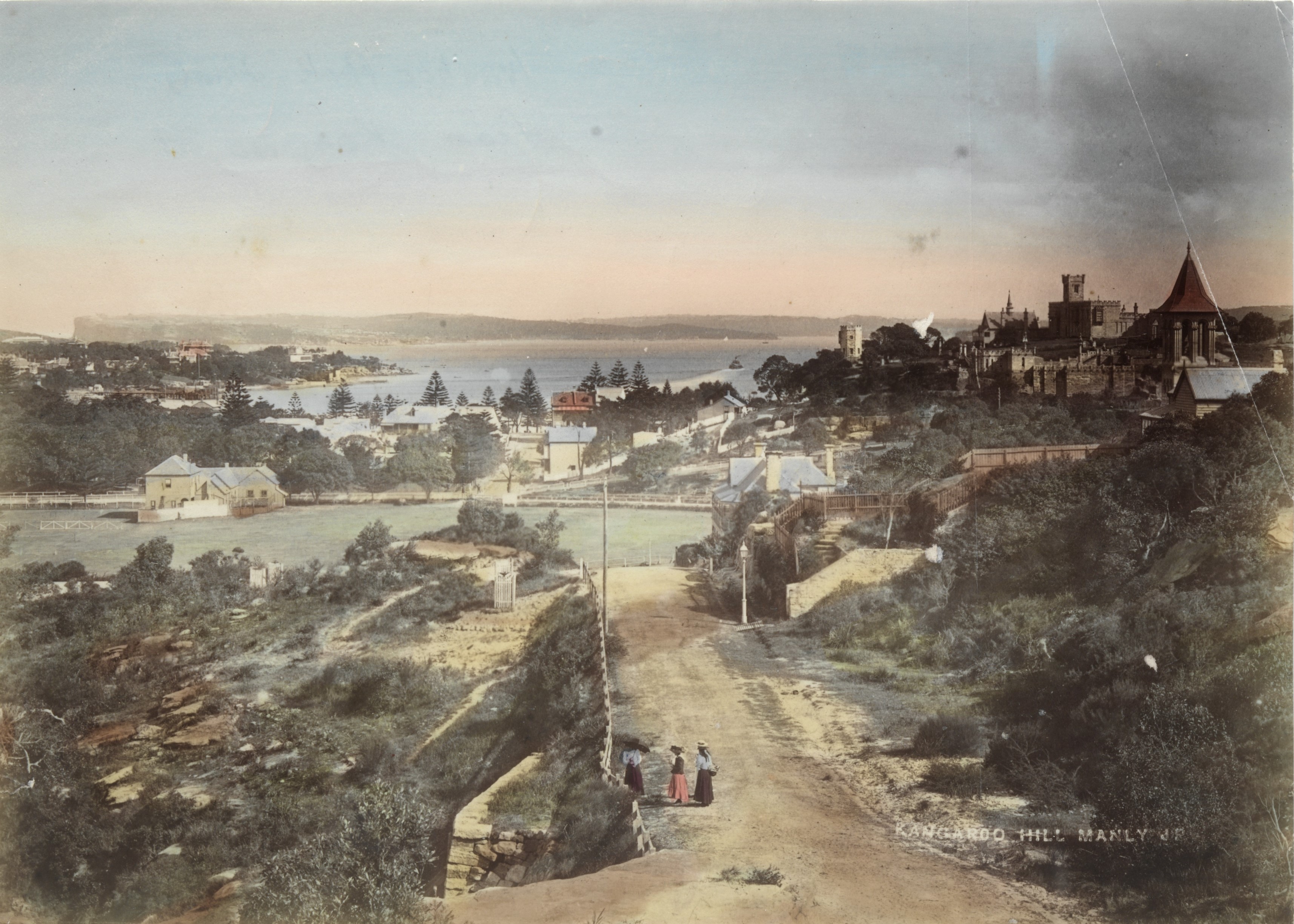
Kangaroo Hill, Manly, ca. 1880-1898, courtesy State Library of New South Wales, Item: SLNSW_FL1109634
In his 1861 published account of a walk from Manly to Barrenjoey, 'My Holiday', Charles De Boos he describes:
Having made an equal division of the various articles to be token with us in such a way as that each should have, as nearly as possible, the same weight to carry, we shouldered our swags for a start, when Tom suddenly remembered that our dogs wore not forthcoming. Down went our loads again, whilst Tom made off to get one of the two animals that were to accompany us. In about half-an-hour he returned, leading a kangaroo dog by a leash, and once more we buckled on our loads, and this time made a start. Scarcely, however, had we got into the roadway, than our animal became restive, hung back in the leash, and, in consequence of a rather impatient drag on the leading strap, drew her head clean out of the collar. No sooner aid she find herself free than she scampered off through the bush in a totally opposite direction to that by which we proposed to travel, utterly inattentive to the whistlings and the coaxing appeals of Tom, who, as the hound disappeared in the distance, gradually sank his note down to a growl, and ultimately to an expletive. As we all stood leaning sorrowfully upon our guns and looking mournfully along the track of the fugitive, we must have offered to the passer-by a very pretty picture of personified disappointment and, as it is considered absolutely de rigueur to be accompanied by kangaroo dogs when out after wallaby, we felt that this was a mischance that must under any circumstances be remedied.
As luck would have it, however, a gentleman resident in that vicinity, who had no doubt marked our disconsolate visages, and pitied our deserted position, very kindly came forward, and offered to lend us his dog-"a regular nipper"-as Tom, on his own personal knowledge declared him to be. Of course we were only too thankful for the offer, and after a brief delay, the dog was secured us we thought and we made another start, picking up our second animal, a very handsome kangaroo dog named Spanker, as we passed the Steyne Hotel, and going on our way rejoicing.
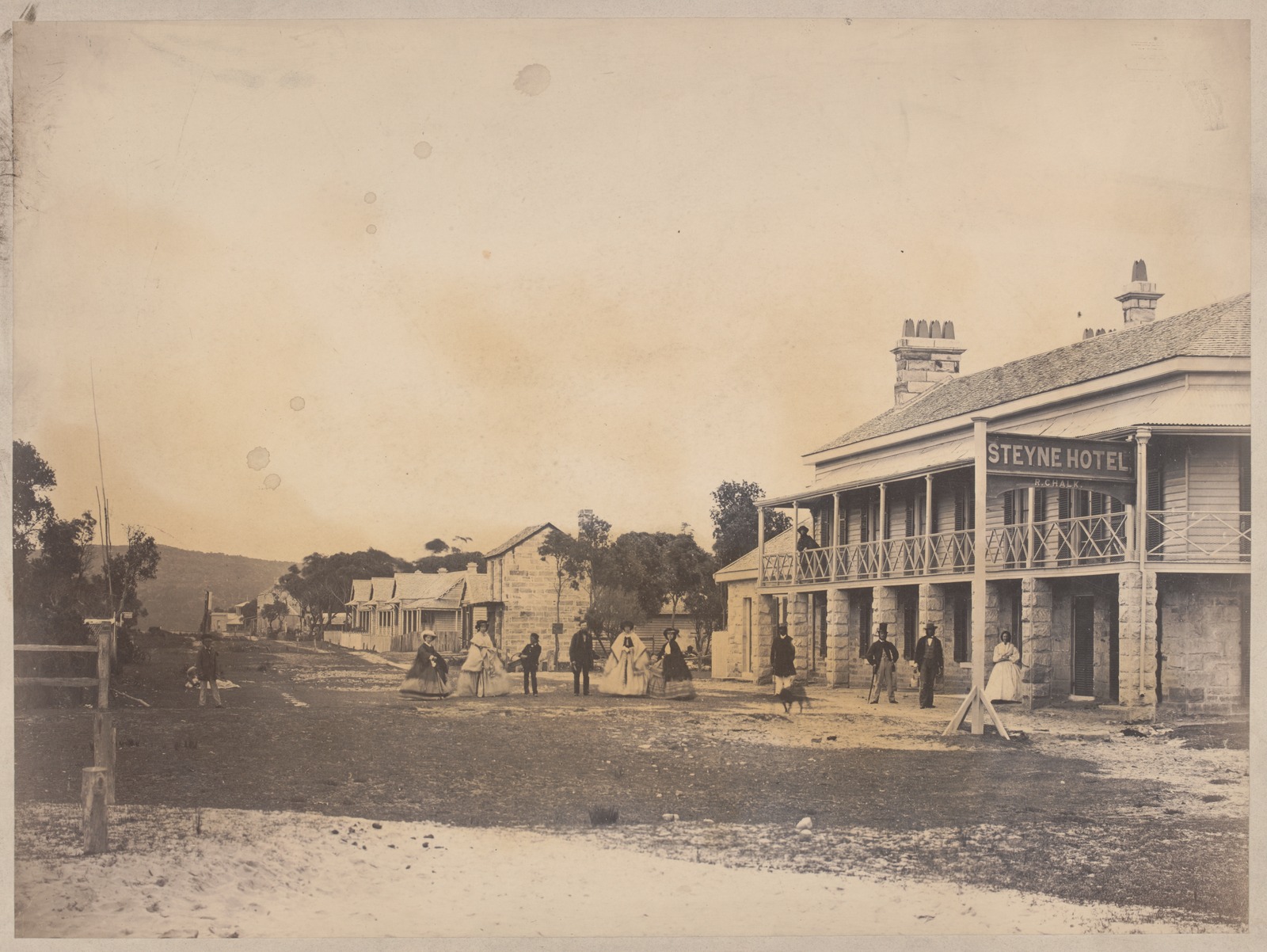
Manly Beach - circa 1860 - courtesy State Library of Victoria - Image No.: H3671.
But alas! our felicitations were ill-timed, since we had scarcely proceeded half a-mile before the regular nipper made a dive forward, a start backward, a sudden and indescribable shake and wriggle, and lo he was free of the leash, leaving behind in the hands of the astounded Tom the complicated series of knots which he had only a few minutes before defied the sleekest headed hound in creation to slip. Before any one of us could muster up presence of mind enough to call, whistle, or coax, the regular nipper, with his tail hard jammed down between his legs, had disappeared in the scrub, in the most direct route homewards. The faithful Spanker, however, was still left to us, and we were fain, as the afternoon was drawing on apace, to be contented with one dog, the more especially as that dog followed us of his own accord, influenced evidently by an innate love of sport. I am afraid that our parting addresses to the "nipper" were not exactly benedictions, but we were all of the one opinion that we were better rid of the nuisance of dragging him along, and we consequently made tracks much more lightly and cheerfully from being relieved of this incubus.
The shooting of 'Wonga Wonga' pigeons was a favourite sport too - so much so that they too would be soon quite rare in the peninsula area. De Boos describes, in opening his descriptions;
Wondrous tales were told me of the manner in which game abounded in that part of the country. Wallaby scoured the bush in flocks, and would run over you if you did not get out of their way. Wild ducks were so numerous that they were only too thankful to be shot that the redundant population of the swamps might be thinned off; wonga-wongas sat cooing their harsh note in every tree that lined the way and bronze wings were so common as to have fallen into general disrepute. Believing a very great deal less than the half of what I heard, I of course provided myself with a gun and its accompaniments powder and shot, and strapping my blankets on to my shoulders, took passage by the Phantom to Manly Beach.
And further along, when at Careel Bay, the future site for the proposed Royal Sydney Yacht Squadron's Pittwater chapter, and alongside where The Basin regattas of the 1890s would take place, which also included visitors 'hunting' game from their yachts, De Boos describes:
"A wonga wonga, by Jupiter!” he exclaimed, and, taking a steady aim, he fired, the feathers from the bird fell down in a shower, whilst the bird himself flew away into the thick brush of the gully, not unharmed, as many of the feathers were stained with blood. However, we did not get him, and that was enough for me. Not so for Tom, for he persisted in hunting up the feathers, in declaring that the bird must have been skinned by the shot, and in wondering however it could have got away. I was quite used to all that sort of thing, for I had tried the same dodge myself when I hadn't bagged my game, so I put down my gun, walked quietly down to the rocks, and commenced opening and eating the oysters with which they were covered in the greatest profusion.
.jpg?timestamp=1567239765467)
We had been led to expect that on the edge of this scrub we should put up any quantity of wonga wongas, and as Nat and I were desirous of making a triumphal entry into the station with a brace or two of these fine birds hanging at our girdles, we determined upon trying our luck. Carefully, and in a most sportsmanlike manner did we stalk along through the fern, which here grew as high as our waists, and formed an excellent cover for birds if they would but have come there. I fully expected every minute to put up, if not a wonga wonga, at all events a brace of quail; but we went on and on, and still nothing appeared. Nat audibly gave vent to his dissatisfaction, and stated as his private and particular opinion, that we had been humbugged. He uncocked his piece and threw it over his shoulder, whilst I was in the act of doing the same thing, when whirr !-up with a loud flapping of wings, that from its suddenness quite unnerved me and threw me off my guard, rose a magnificent wonga wonga, which in my agitation appeared to me as big as a turkey. It heeled round leisurely in front of me and lodged in the branches of a honey- suckle, full in sight, though out of gun-shot from where we stood, whilst I stood with mouth and eyes open, incapable of doing anything but watching its flight.
"What the mischief was that?" said Nat, in evident astonishment at the sound.
“Didn’t you see it? " I asked.
" Not a bit," he replied.
"It was a wonga, and as large a one as ever I saw. See, there he is on the honeysuckle vender, the fourth bough from the top."
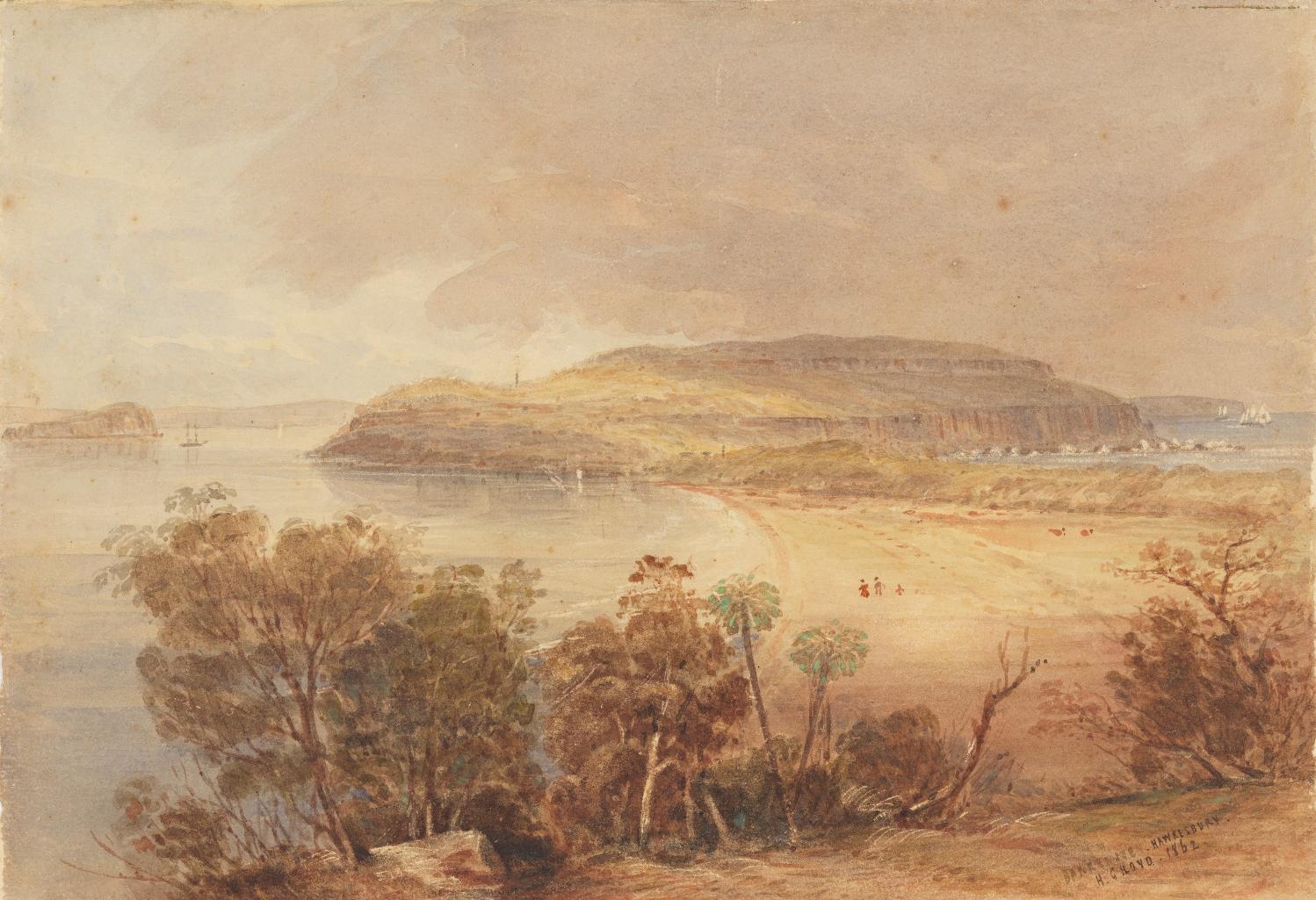
Birds Protection Bill 1892 - Parliament of NSW
Available at: https://www.parliament.nsw.gov.au
Status: Assented on Thu 1 Jun 1893 ; Bill Remarks: LA REMARKS: Reported 14/02/1893. Report Adopted 14/02/1893. Agreed to by Council with amendment 2/05/1893.
Origin: Legislative Assembly
Member with Carriage: Carruthers, Joseph Hector McNeil
LC - Council's amendments agreed to with amendments: Fri 19 May 1893
Assented: Thu 1 Jun 1893
Preamble
WHEREAS it is expedient to repeal the "Birds Protection Act of 1881" Be it therefore enacted by the Queen's Most Excellent Majesty, by and with the advice and consent of the Legislative Council and Legislative Assembly of New South Wales in Parliament assembled, and by the authority of the same, as follows :-
This Act shall come into force immediately on the passing thereof, and may be cited as the " Birds Protection Act of 1893."
The Act forty-fifth Victoria number twenty-nine is hereby repealed.
The expression " Protected bird " in this Act means any imported or native bird mentioned in or which may be added to the First and Third Schedules hereto. " Game bird "—any bird mentioned in or which may be added to the first or second parts of the Second Schedule hereto. " Scheduled bird "—a bird of any of the kinds or families mentioned in or which shall be added to any Schedule to this Act. And " Close season "—the periods of time prescribed by this Act for the protection of the birds included in the Schedules hereto.
Initially 'British Birds' was listed at the top of the schedule as birds never to be hunted, this wording was changed to 'Foreign Birds' and scheduled:
.jpg?timestamp=1724876283491)
.jpg?timestamp=1724877368058)
.jpg?timestamp=1724877735262)
BIRDS' PROTECTION ACT.
TO THE EDITOR OF THE HERALD.
Sir,- I see in to-day's issue of your paper that the Upper House has passed the above Act through its most important stage. In the list of birds protected for five years there are three omissions, i.e., the sea- gull, the laughing jackass and the Indian minah. These errors should be rectified as soon as possible. The laughing jackass ought to be perpetually protected. It may be somewhat of a revelation to the readers of your paper to leam that in certain parts of the colony this bird is shot wholesale. We want more of the real sporting feeling in this country. By this I mean the feeling which exists among the true sportsmen of the old country, where, if a man kills anything other than game or shoots game during the close season, he is looked upon as a person to he avoided.
The question of bird preservation is a matter of national importance. Forty million (40,000,000) birds are killed annually for purposes of millinery, &.c., and if this wholesale system of destruction is allowed to spread to Australia our distinctive birds will soon be annihilated. Country residents who are in sympathy with the bill should assist in every way in carrying out its provisions. Any person found infringing the provisions of the bill ought to be at once informed upon and punished. Farmers, station managers, and all who can possibly help in preserving our birds should do so as far as may be in their power. In conclusion, I would suggest that all the birds which have been taken out of the section protecting them for five years be promptly re- inserted therein. Recommending this to the notice of Mr. Carruthers, to whom we are indebted for this most useful piece of legislation.
I am, &c.,
J. F.B. April 28. BIRDS' PROTECTION ACT. (1893, May 2). The Sydney Morning Herald (NSW : 1842 - 1954), p. 6. Retrieved August 29, 2024, from http://nla.gov.au/nla.news-article13933302
BIRDS PROTECTION ACT.
TO THE EDITOR OF THE HERALD.
Sir,—I have just been handed a copy of the Birds Protection Act of 1893, and desire, with your kind permission, to say a few words with reference to it. The new Act is undoubtedly a great improvement on the old one, and in a general sense will be hailed with satisfaction by all lovers of Australian birds , but nevertheless I consider—and every one acquainted with the nidification of several Australian birds will and must, I am sure, consider—it in too many particulars clumsily framed, ineffective, and faulty.
Kindly allow me just to give one instance in support of the foregoing assertions. Let us simply take the emu—a bird which is known to everybody, and whose graceful, noble form adorns our present two penny stamp—and what do we find ? In order that it may lay its eggs and hatch its young in safety and peace it is "protected" by this new Act from the 1st August—mark this—to the 31st January. Now, every schoolboy who resides in districts where the emu occurs, knows that the bird begins to lay, not on the 1st August, as the framers of the Act seem to have imagined, but in May, and that by the 1st August, and often before that date, dozens of young emus may be seen running about with their mothers on the plains. No one in the Narrabri, Coonamble, or Coonabarabran districts will attempt to deny this. I have seen it myself 50 times. In June, 1886, when travelling to Coonamble, I met at Warren a bird and egg collector returning from Coonamble district, who had in his cart no less than 1600 fresh emu eggs. Now, what is the good, or where is the sense, of extending protection to a bird when all its eggs are laid and stolen ? The thing is simply a farce—a bit of make-believe—and everyone must know it.
The Sydney Morning Herald with considerable kindness has allowed me during these last 10 years a vast amount of space to denounce the old Game Protection Act over and over again and to point out its wretched inapplicability and faultiness ; and I say emphatically, and with little fear of being refuted, that in many particulars—altogether too many—the new Act is little less faulty, inapplicable, and ineffective. It is perfectly annoying to me to think that so clumsy and ineffective, so slipshod and farcical, an Act could be framed by a body of legislators who claim to be Australians. Had the Act been framed in Japan by a Japanese Legislature it could scarcely be more haphazard or ludicrously clumsy, ineffective, and inapplicable. I am ashamed to find that our legislators know so little and display such a gross and un-pardonable ignorance of the habits and nidification of so common an Australian bird as the emu. And let me distinctly say that I am not speaking as an expert, as I am not an authority on Australian birds. Now, is it too late to alter this Act in order that the emu, which is being destroyed with a rapid relentlessness that is not only undeniable, but is freely and generally admitted, from early extermination ? I repeat that the new Act in its present for is worse than worthless as a means of protection. As far as the emu—the noblest of our many noble birds—is concerned the Act is a miserable farce and an egregious failure, and for all the protection it will afford the emu—not to speak of other birds, and there are several—it might just as well be instantly swept from the statute book. What, I ask, is the use, and wherein is the sense, of protecting the emu itself when egg dealers are allowed to cart away thousands of the eggs before the Act comes into operation to protect them ?
Where is the sense of this sort of thing? Where is the logic? A mere schoolboy cannot fail to comprehend, to grasp, the sense of my argument. Was this Act framed merely as a joke, or must we regard it as a serious piece of legislation ? Why was not Dr. Ramsay asked simply when did the emu begin to lay its eggs ? This is the case in a nutshell:
A ludicrous attempt has been made to compel the emu to lay its eggs at a certain time of the year by Act of Parliament ! I am heartsick and weary of contemplating and denouncing this Act. May I hope that some intelligent Australian politician—if we have one—will immediately take this matter in hand and effect a change for the better ?
I am, &c.,
H. J. M'COOEY. July 28. BIRDS PROTECTION ACT. (1893, July 29). The Sydney Morning Herald (NSW : 1842 - 1954), p. 10. Retrieved from http://nla.gov.au/nla.news-article13932344
BIRDS PROTECTION ACT.
There appears to be some misapprehension with regard to the notices Issued under the Birds Protection Act owing to the passing of the Consolidated Act of 1901. It is pointed but for general information that the passing of the latter Act will not In any way affect the notices issued under the Birds Protection Act of 1893. BIRDS PROTECTION ACT. (1902, August 11). The Australian Star (Sydney, NSW : 1887 - 1909), p. 3. Retrieved from http://nla.gov.au/nla.news-article228945739
PROTECTION OF NATIVE ANIMALS.
A BILL for the protection of native animals was introduced in the Legislative Assembly last night by Sir John See. The bill provides for the protection for two years from the passing of the act of the red kangaroo, grey kangaroo, wallaroo, opossum, native bear, and wombat, and fixes the close season in each year from 1st July to 31st December. The platypus and echidna are to be protected perpetually. Power is given to add, by a notice in the Government Gazette, to the schedule of protected animals, and also to vary or remove the periods of protection on any animal. Persons are forbidden to have in their possession any animals recently taken or their skins. The maximum penalty for any breach of the act is £5.
PROTECTION OF NATIVE ANIMALS. (1903, August 21). Goulburn Herald (NSW : 1881 - 1907), p. 6. Retrieved from http://nla.gov.au/nla.news-article110079992
CARELESS USE OF FIRE ACT, 1912, AS AMENDED BY THE BUSH FIRES ACT, 1930.
Appointment of Honorary Rangers.
THE undermentioned persons have been appointed as Honorary Rangers in pursuance of the provisions of section 8a of the Careless Use of Fire Act, 1912, as inserted by the Bush Fires Act, 1930:—
Davies, Francis Lewis, Finisterre, Stokes Point, Careel Bay, Pittwater. CARELESS USE OF FIRE ACT, 1912, AS AMENDED BY THE BUSH FIRES ACT, 1930. (1930, December 19). Government Gazette of the State of New South Wales (Sydney, NSW : 1901 - 2001), p. 4955. Retrieved from http://nla.gov.au/nla.news-article220234670
BIRDS AND ANIMALS PROTECTION ACT, 1918- 1930.
Appointment of Honorary Rangers.
THE undermentioned persons have been appointed as Honorary Bangers, in pursuance of the provisions of the Birds and Animals Protection Act, 1918-1930:—
Francis Lewis Davies, Finisterre, Stokes Point, Careel Bay. BIRDS AND ANIMALS PROTECTION ACT, 19181930. (1930, November 14). Government Gazette of the State of New South Wales (Sydney, NSW : 1901 - 2001), p. 4580. Retrieved from http://nla.gov.au/nla.news-article220233247
RANGERS' LEAGUE. Mr. Francis Lewis Davies has been appointed honorary secretary to the Rangers' League. Mr Percy A. Meggy, who until recently held the office of honorary secretary, is now the honorary editor for the league. RANGERS' LEAGUE. (1931, June 19). The Sydney Morning Herald (NSW : 1842 - 1954), p. 10. Retrieved from http://nla.gov.au/nla.news-article16787048
THE RANGERS' LEAGUE.
(To the Editor).
Sir, — The Rangers' League, which was established for the purpose of giving practical service in its work covering the protection, and preservation of our unique and wonderful Australian Flora and Fauna and the other natural and special features of our country, has already made surprising progress.
Being the first organisation of its kind, the work of the League has been; mainly pioneering. Much field work has. been accomplished valuable assistance has been rendered by the Government, and also 'by public and private organisations ; this . has helped in large measure to bring about the success 'which has been achieved. The team work of the members, the general increasing . interest, and the - praise and sympathy received from many sources, are very encouraging.
The' League, is under the control of a Council representative of its manifold, activities, such as ecology, botany, etc!, while the more immediate supervision is entrusted to an executive. The service rendered by the members is given in a purely honorary' capacity, and each member is expected to contribute assistance in some form; this service is supplemented, as far as possible, with available funds.
Several acts, of great interest to Rangers, are in course of amendment by Parliament,- and it is pleasing to note that suggestions by the League for the amendment of the Birds and Animals Protection Act have been accepted and included. The continued success of the League depends upon the individual and united effort of each of us. It is the duty of all Australians to do their utmost to protect and preserve our native birds, animals. plants and flowers, which are becoming more rare and even extinct. In our own interest and in that of our children, these must be regarded as an everlasting heritage to be handed down to future generations: As a means to that end, the -League is commended to you ~f or your generous support. Th secretary will be pleased, to receive inquiries from individual Rangers and all others who are interested. — Yours, etc., J. D, TIPPER, President. THE RANGERS' LEAGUE. (1930, June 21). Molong Express and Western District Advertiser (NSW : 1887 - 1954), p. 2. Retrieved from http://nla.gov.au/nla.news-article139979951
Stokes Point during the 1930's was still a place of towering gums, with Warringah Shire Council records showing one resident complaining to the Council about the cutting down of huge trees on his property and threatening to sure them for doing so. Another is complaining of people using a path through their block to walkin in and access homes further out along the Point and threatening to close the gate and block the thoroughfare unless Council put a decent passable road in. Careel Bay, outside of the permanent fishermen and their families who had lived there, was a place far removed from the dusty hot streets of Sydney town. Well into the 1930's those who lived there all year round and those who had places they fled to during the cooler months of for the Summer 'Season' sought to preserve the natural beauty and wildlife that lived there - such as trees filled with koalas - the Wilson 2 acres down by the bay were called 'Koala' - and would voluntarily undertake these Honorary Ranger roles in order to do something about those that would destroy the the trees and animals, as Francis Davies did.
THE KANGAROO-MANLY.
TO THE EDITOR OF THE HERALD.
Sir, - The stone figure you refer to as representing a kangaroo at Manly I do not think existed in 1866, when I first visited the district. I understood from the Honorable W. B. Dalley it was placed in position during the seventies, but early residents could state correctly. The idea is given of greater antiquity, but even in the sixties living counterparts did abound in regions about. The spot formed part of the district of the Hunters' Hills, game being plentiful. If those sightless eyes referred to could have seen, by the image turning right about, boats could have been seen, even in the sixties, plying on the lake.
I am, etc.,
C. J. CAMPBELL. 64b Druitt-street, Feb. 22. THE KANGAROO—MANLY. (1937, March 6). The Sydney Morning Herald (NSW : 1842 - 1954), p. 11. Retrieved from http://nla.gov.au/nla.news-article17349752
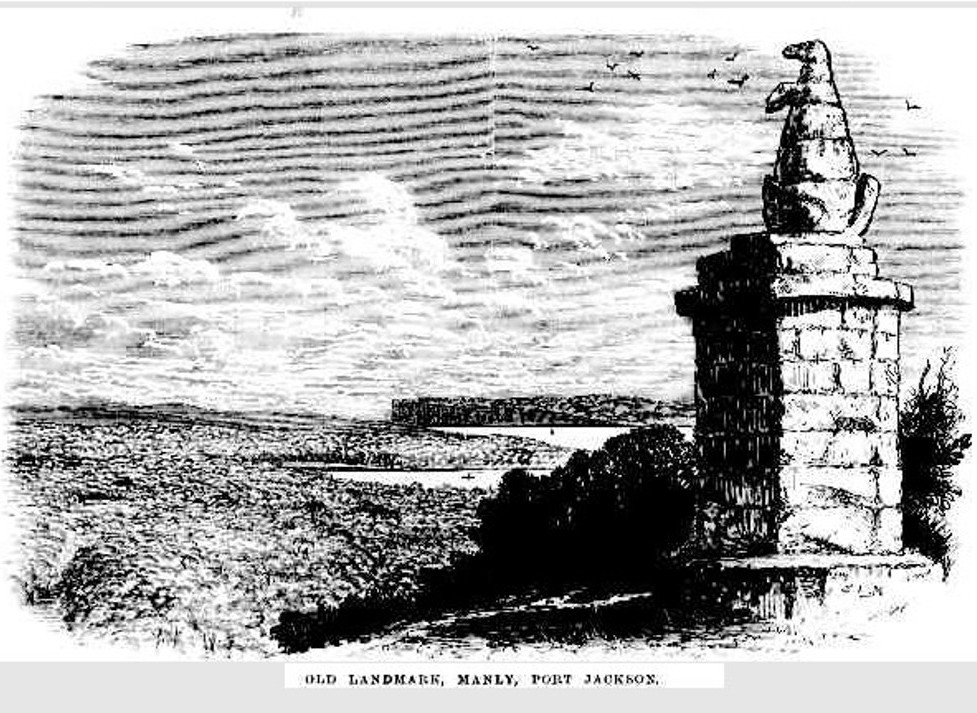
The kangaroo was erected by H.G. Smith – founder or ‘father’ of Manly around 1857 – Picture from: OLD LANDMARK, MANLY, PORT JACKSON'. The stone kangaroo, of somewhat primitive fashioning, which forms a prominent object in our engraving, is well known to most of the numerous pleasure-seekers at Manly, Port Jackson. It was erected by a local resident and property owner, and stands on the crown of a rocky hill, whence maybe obtained an excellent view of the pleasant little village of Manly and of the many charming villas that dot the slopes of the hills. Manly Bay is also to be Been, together with the South Head and entrance to Port Jackson. Sketches with Pencil. (1875, May 15). The Australasian Sketcher with Pen and Pencil (Melbourne, Vic. : 1873 - 1889), p. 19. Retrieved from http://nla.gov.au/nla.news-article60606767
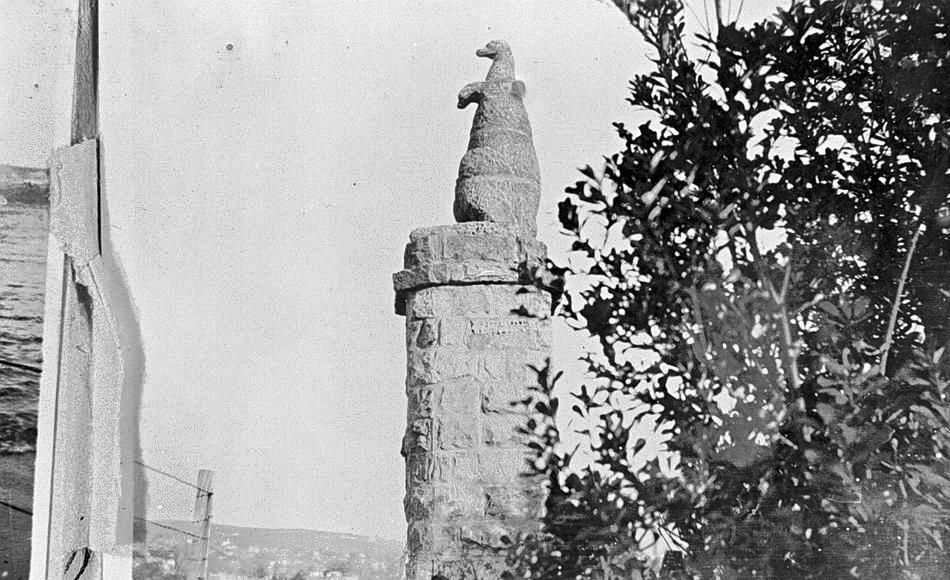
'Statue of a Kangaroo, Carved by Convicts, Manly, New South Wales', (Photo; 1915 Mrs C Chisholm, 1915) courtesy - The Biggest Family Album of Australia, Museum Victoria, Image No.: MM 001014 - sources state was built/carved circa 1857.